Nokia Solutions and Networks T5BP1 SC4812-MF 1X @ 800MHz CDMA BTS User Manual 1X SC4812T BTS Optimization ATP Release 2 16 3 x
Nokia Solutions and Networks SC4812-MF 1X @ 800MHz CDMA BTS 1X SC4812T BTS Optimization ATP Release 2 16 3 x
Exhibit 8

68P09258A31–A
Oct 2003
ENGLISH
CDMA
Software Release R2.16.3.x
Technical
Information
1X SCt 4812T BTS Optimization/ATP
800 and 1900 Mhz

SPECIFICATIONS SUBJECT TO CHANGE WITHOUT NOTICE
Notice
While reasonable efforts have been made to assure the accuracy of this document, Motorola, Inc. assumes no liability resulting from any
inaccuracies or omissions in this document, or from use of the information obtained herein. The information in this document has been
carefully checked and is believed to be entirely reliable. However, no responsibility is assumed for inaccuracies or omissions. Motorola,
Inc. reserves the right to make changes to any products described herein and reserves the right to revise this document and to make
changes from time to time in content hereof with no obligation to notify any person of revisions or changes. Motorola, Inc. does not
assume any liability arising out of the application or use of any product, software, or circuit described herein; neither does it convey
license under its patent rights or the rights of others.
It is possible that this publication may contain references to, or information about Motorola products (machines and programs),
programming, or services that are not announced in your country. Such references or information must not be construed to mean
that Motorola intends to announce such Motorola products, programming, or services in your country.
Copyrights
This instruction manual, and the Motorola products described in this instruction manual may be, include or describe copyrighted
Motorola material, such as computer programs stored in semiconductor memories or other media. Laws in the United States and
other countries preserve for Motorola and its licensors certain exclusive rights for copyrighted material, including the exclusive
right to copy, reproduce in any form, distribute and make derivative works of the copyrighted material. Accordingly, any
copyrighted material of Motorola and its licensors contained herein or in the Motorola products described in this instruction manual
may not be copied, reproduced, distributed, merged or modified in any manner without the express written permission of Motorola.
Furthermore, the purchase of Motorola products shall not be deemed to grant either directly or by implication, estoppel, or
otherwise, any license under the copyrights, patents or patent applications of Motorola, as arises by operation of law in the sale of a
product.
Usage and Disclosure Restrictions
License Agreement
The software described in this document is the property of Motorola, Inc and its licensors. It is furnished by express license
agreement only and may be used only in accordance with the terms of such an agreement.
Copyrighted Materials
Software and documentation are copyrighted materials. Making unauthorized copies is prohibited by law. No part of the software or
documentation may be reproduced, transmitted, transcribed, stored in a retrieval system, or translated into any language or
computer language, in any form or by any means, without prior written permission of Motorola, Inc.
High Risk Activities
Components, units, or third–party products used in the product described herein are NOT fault–tolerant and are NOT designed,
manufactured, or intended for use as on–line control equipment in the following hazardous environments requiring fail–safe
controls: the operation of Nuclear Facilities, Aircraft Navigation or Aircraft Communication Systems, Air Traffic Control, Life
Support, or Weapons Systems (“High Risk Activities”). Motorola and its supplier(s) specifically disclaim any expressed or implied
warranty of fitness for such High Risk Activities.
Trademarks
MOTOROLA and the Stylized M Logo are registered in the US Patent & Trademark Office. All other product or service names are
the property of their respective owners.
© Copyright 2003 Motorola, Inc.
Printed on
Recyclable Paper
REV091302

1X SCt 4812T BTS Optimization/ATP i
Oct 2003
1X SCt 4812T BTS
Optimization/ATP
Table of Contents
.
.
.

Table of Contents 68P09258A31–A
1X SCt 4812T BTS Optimization/ATP
ii Oct 2003
Contents
FCC Requirements xviii . . . . . . . . . . . . . . . . . . . . . . . . . . . . . . . . . . . . . . . . . . . . . . . . . . . . . . . . . . . . . . . . . . . . . . . . . .
Content xviii . . . . . . . . . . . . . . . . . . . . . . . . . . . . . . . . . . . . . . . . . . . . . . . . . . . . . . . . . . . . . . . . . . . . . . . . . . . . .
FCC Part 15 Requirements xviii . . . . . . . . . . . . . . . . . . . . . . . . . . . . . . . . . . . . . . . . . . . . . . . . . . . . . . . . . . . .
FCC Part 68 Requirements xix . . . . . . . . . . . . . . . . . . . . . . . . . . . . . . . . . . . . . . . . . . . . . . . . . . . . . . . . . . . .
Foreword xx . . . . . . . . . . . . . . . . . . . . . . . . . . . . . . . . . . . . . . . . . . . . . . . . . . . . . . . . . . . . . . . . . . . . . . . . . . . . . . . . . . .
General Safety xxii . . . . . . . . . . . . . . . . . . . . . . . . . . . . . . . . . . . . . . . . . . . . . . . . . . . . . . . . . . . . . . . . . . . . . . . . . . . . . .
Revision History xxiv . . . . . . . . . . . . . . . . . . . . . . . . . . . . . . . . . . . . . . . . . . . . . . . . . . . . . . . . . . . . . . . . . . . . . . . . . . . . .
Chapter 1 Introduction 1-1 . . . . . . . . . . . . . . . . . . . . . . . . . . . . . . . . . . . . . . . . . . . . . . . . . . . .
Optimization Manual: Scope and Layout 1-2 . . . . . . . . . . . . . . . . . . . . . . . . . . . . . . . . . . . . . . . . . . . . . . . . . . . . . . . .
Manual Scope and Layout 1-2 . . . . . . . . . . . . . . . . . . . . . . . . . . . . . . . . . . . . . . . . . . . . . . . . . . . . . . . . . . . . .
Assumptions and Prerequisites 1-2 . . . . . . . . . . . . . . . . . . . . . . . . . . . . . . . . . . . . . . . . . . . . . . . . . . . . . . . .
Document Composition 1-3 . . . . . . . . . . . . . . . . . . . . . . . . . . . . . . . . . . . . . . . . . . . . . . . . . . . . . . . . . . . . . . .
Purpose of the Optimization 1-4 . . . . . . . . . . . . . . . . . . . . . . . . . . . . . . . . . . . . . . . . . . . . . . . . . . . . . . . . . . . . . . . . . .
Why Optimize? 1-4 . . . . . . . . . . . . . . . . . . . . . . . . . . . . . . . . . . . . . . . . . . . . . . . . . . . . . . . . . . . . . . . . . . . . . .
What Is Optimization? 1-4 . . . . . . . . . . . . . . . . . . . . . . . . . . . . . . . . . . . . . . . . . . . . . . . . . . . . . . . . . . . . . . . .
What Happens During Optimization? 1-4 . . . . . . . . . . . . . . . . . . . . . . . . . . . . . . . . . . . . . . . . . . . . . . . . . . . .
When to Optimize 1-5 . . . . . . . . . . . . . . . . . . . . . . . . . . . . . . . . . . . . . . . . . . . . . . . . . . . . . . . . . . . . . . . . . . . . . . . . . . .
New Installations 1-5 . . . . . . . . . . . . . . . . . . . . . . . . . . . . . . . . . . . . . . . . . . . . . . . . . . . . . . . . . . . . . . . . . . . . .
Site Expansion 1-5 . . . . . . . . . . . . . . . . . . . . . . . . . . . . . . . . . . . . . . . . . . . . . . . . . . . . . . . . . . . . . . . . . . . . . . .
Periodic Optimization 1-5 . . . . . . . . . . . . . . . . . . . . . . . . . . . . . . . . . . . . . . . . . . . . . . . . . . . . . . . . . . . . . . . . .
Repaired Sites 1-5 . . . . . . . . . . . . . . . . . . . . . . . . . . . . . . . . . . . . . . . . . . . . . . . . . . . . . . . . . . . . . . . . . . . . . . .
Required Test Equipment and Software 1-6 . . . . . . . . . . . . . . . . . . . . . . . . . . . . . . . . . . . . . . . . . . . . . . . . . . . . . . . .
Overview 1-6 . . . . . . . . . . . . . . . . . . . . . . . . . . . . . . . . . . . . . . . . . . . . . . . . . . . . . . . . . . . . . . . . . . . . . . . . . . . .
Policy 1-6 . . . . . . . . . . . . . . . . . . . . . . . . . . . . . . . . . . . . . . . . . . . . . . . . . . . . . . . . . . . . . . . . . . . . . . . . . . . . . . .
Test Equipment Calibration 1-6 . . . . . . . . . . . . . . . . . . . . . . . . . . . . . . . . . . . . . . . . . . . . . . . . . . . . . . . . . . . .
Test Cable Calibration 1-6 . . . . . . . . . . . . . . . . . . . . . . . . . . . . . . . . . . . . . . . . . . . . . . . . . . . . . . . . . . . . . . . .
Equipment Warm–up 1-7 . . . . . . . . . . . . . . . . . . . . . . . . . . . . . . . . . . . . . . . . . . . . . . . . . . . . . . . . . . . . . . . . .
LMF computer and software 1-7 . . . . . . . . . . . . . . . . . . . . . . . . . . . . . . . . . . . . . . . . . . . . . . . . . . . . . . . . . . .
Communications system analyzer CDMA/analog 1-9 . . . . . . . . . . . . . . . . . . . . . . . . . . . . . . . . . . . . . . . . .
Optional Equipment 1-11 . . . . . . . . . . . . . . . . . . . . . . . . . . . . . . . . . . . . . . . . . . . . . . . . . . . . . . . . . . . . . . . . . .
Required Documentation 1-12 . . . . . . . . . . . . . . . . . . . . . . . . . . . . . . . . . . . . . . . . . . . . . . . . . . . . . . . . . . . . . . . . . . . . .
Required Documents 1-12 . . . . . . . . . . . . . . . . . . . . . . . . . . . . . . . . . . . . . . . . . . . . . . . . . . . . . . . . . . . . . . . . .
Related Publications 1-12 . . . . . . . . . . . . . . . . . . . . . . . . . . . . . . . . . . . . . . . . . . . . . . . . . . . . . . . . . . . . . . . . . .
Terms and Abbreviations 1-13 . . . . . . . . . . . . . . . . . . . . . . . . . . . . . . . . . . . . . . . . . . . . . . . . . . . . . . . . . . . . . . . . . . . . .
Standard and Non–standard Terms and Abbreviations 1-13 . . . . . . . . . . . . . . . . . . . . . . . . . . . . . . . . . . . . .
BTS Equipment Identification 1-15 . . . . . . . . . . . . . . . . . . . . . . . . . . . . . . . . . . . . . . . . . . . . . . . . . . . . . . . . . . . . . . . . .
Equipment Overview 1-15 . . . . . . . . . . . . . . . . . . . . . . . . . . . . . . . . . . . . . . . . . . . . . . . . . . . . . . . . . . . . . . . . . .
Ancillary Equipment Frame Identification 1-15 . . . . . . . . . . . . . . . . . . . . . . . . . . . . . . . . . . . . . . . . . . . . . . . .
Logical BTS 1-15 . . . . . . . . . . . . . . . . . . . . . . . . . . . . . . . . . . . . . . . . . . . . . . . . . . . . . . . . . . . . . . . . . . . . . . . . .
BTS Frame Description 1-21 . . . . . . . . . . . . . . . . . . . . . . . . . . . . . . . . . . . . . . . . . . . . . . . . . . . . . . . . . . . . . . .
I/O Interconnect Plates 1-23 . . . . . . . . . . . . . . . . . . . . . . . . . . . . . . . . . . . . . . . . . . . . . . . . . . . . . . . . . . . . . . . .
Combined CDMA Channel Processor Shelf 1-27 . . . . . . . . . . . . . . . . . . . . . . . . . . . . . . . . . . . . . . . . . . . . . .
BBX–1X and BBX2 Interchangeability 1-27 . . . . . . . . . . . . . . . . . . . . . . . . . . . . . . . . . . . . . . . . . . . . . . . . . . .
Linear Power Amplifier Shelf 1-28 . . . . . . . . . . . . . . . . . . . . . . . . . . . . . . . . . . . . . . . . . . . . . . . . . . . . . . . . . . .
BTS Sector Configuration 1-30 . . . . . . . . . . . . . . . . . . . . . . . . . . . . . . . . . . . . . . . . . . . . . . . . . . . . . . . . . . . . . . . . . . . .
Chapter 2 Preliminary Operations 2-1 . . . . . . . . . . . . . . . . . . . . . . . . . . . . . . . . . . . . . . . . . .
Preliminary Operations: Overview 2-2 . . . . . . . . . . . . . . . . . . . . . . . . . . . . . . . . . . . . . . . . . . . . . . . . . . . . . . . . . . . . .

Table of Contents
68P09258A31–A
1X SCt 4812T BTS Optimization/ATP iii
Oct 2003
Introduction 2-2 . . . . . . . . . . . . . . . . . . . . . . . . . . . . . . . . . . . . . . . . . . . . . . . . . . . . . . . . . . . . . . . . . . . . . . . . .
Cell Site Types 2-2 . . . . . . . . . . . . . . . . . . . . . . . . . . . . . . . . . . . . . . . . . . . . . . . . . . . . . . . . . . . . . . . . . . . . . . .
CDF/NECF 2-2 . . . . . . . . . . . . . . . . . . . . . . . . . . . . . . . . . . . . . . . . . . . . . . . . . . . . . . . . . . . . . . . . . . . . . . . . . .
Site Equipage Verification 2-2 . . . . . . . . . . . . . . . . . . . . . . . . . . . . . . . . . . . . . . . . . . . . . . . . . . . . . . . . . . . . .
Initial Installation of Boards/Modules 2-3 . . . . . . . . . . . . . . . . . . . . . . . . . . . . . . . . . . . . . . . . . . . . . . . . . . . .
Setting Frame C–CCP Shelf Configuration Switch 2-4 . . . . . . . . . . . . . . . . . . . . . . . . . . . . . . . . . . . . . . . .
Pre–Power–up Tests 2-5 . . . . . . . . . . . . . . . . . . . . . . . . . . . . . . . . . . . . . . . . . . . . . . . . . . . . . . . . . . . . . . . . . . . . . . . . .
Objective 2-5 . . . . . . . . . . . . . . . . . . . . . . . . . . . . . . . . . . . . . . . . . . . . . . . . . . . . . . . . . . . . . . . . . . . . . . . . . . . .
Test Equipment 2-5 . . . . . . . . . . . . . . . . . . . . . . . . . . . . . . . . . . . . . . . . . . . . . . . . . . . . . . . . . . . . . . . . . . . . . .
Cabling Inspection 2-5 . . . . . . . . . . . . . . . . . . . . . . . . . . . . . . . . . . . . . . . . . . . . . . . . . . . . . . . . . . . . . . . . . . . .
DC Power Pre-test (BTS Frame) 2-6 . . . . . . . . . . . . . . . . . . . . . . . . . . . . . . . . . . . . . . . . . . . . . . . . . . . . . . .
DC Power Pre-test (RFDS) 2-12 . . . . . . . . . . . . . . . . . . . . . . . . . . . . . . . . . . . . . . . . . . . . . . . . . . . . . . . . . . . .
Initial Power–up Tests and Procedures 2-13 . . . . . . . . . . . . . . . . . . . . . . . . . . . . . . . . . . . . . . . . . . . . . . . . . . . . . . . . .
Power-up Procedures 2-13 . . . . . . . . . . . . . . . . . . . . . . . . . . . . . . . . . . . . . . . . . . . . . . . . . . . . . . . . . . . . . . . . .
Common Power Supply Verification 2-14 . . . . . . . . . . . . . . . . . . . . . . . . . . . . . . . . . . . . . . . . . . . . . . . . . . . . .
Initial Power-up (RFDS) 2-15 . . . . . . . . . . . . . . . . . . . . . . . . . . . . . . . . . . . . . . . . . . . . . . . . . . . . . . . . . . . . . . .
Initial Power-up (BTS) 2-15 . . . . . . . . . . . . . . . . . . . . . . . . . . . . . . . . . . . . . . . . . . . . . . . . . . . . . . . . . . . . . . . .
Chapter 3 Optimization/Calibration 3-1 . . . . . . . . . . . . . . . . . . . . . . . . . . . . . . . . . . . . . . . . .
Introduction to Optimization and Calibration 3-2 . . . . . . . . . . . . . . . . . . . . . . . . . . . . . . . . . . . . . . . . . . . . . . . . . . . . .
Overview 3-2 . . . . . . . . . . . . . . . . . . . . . . . . . . . . . . . . . . . . . . . . . . . . . . . . . . . . . . . . . . . . . . . . . . . . . . . . . . . .
Optimization Process Summary 3-2 . . . . . . . . . . . . . . . . . . . . . . . . . . . . . . . . . . . . . . . . . . . . . . . . . . . . . . . .
Cell-site Types 3-3 . . . . . . . . . . . . . . . . . . . . . . . . . . . . . . . . . . . . . . . . . . . . . . . . . . . . . . . . . . . . . . . . . . . . . . .
CDF/NECF 3-3 . . . . . . . . . . . . . . . . . . . . . . . . . . . . . . . . . . . . . . . . . . . . . . . . . . . . . . . . . . . . . . . . . . . . . . . . . .
BTS System Software Download 3-4 . . . . . . . . . . . . . . . . . . . . . . . . . . . . . . . . . . . . . . . . . . . . . . . . . . . . . . .
Site Equipage Verification 3-4 . . . . . . . . . . . . . . . . . . . . . . . . . . . . . . . . . . . . . . . . . . . . . . . . . . . . . . . . . . . . .
Preparing the LMF 3-5 . . . . . . . . . . . . . . . . . . . . . . . . . . . . . . . . . . . . . . . . . . . . . . . . . . . . . . . . . . . . . . . . . . . . . . . . . . .
Overview of Packet BTS files 3-5 . . . . . . . . . . . . . . . . . . . . . . . . . . . . . . . . . . . . . . . . . . . . . . . . . . . . . . . . . .
LMF Features and Installation Requirements 3-6 . . . . . . . . . . . . . . . . . . . . . . . . . . . . . . . . . . . . . . . . . . . . .
LMF File Structure Overview 3-7 . . . . . . . . . . . . . . . . . . . . . . . . . . . . . . . . . . . . . . . . . . . . . . . . . . . . . . . . . . .
LMF Home Directory 3-8 . . . . . . . . . . . . . . . . . . . . . . . . . . . . . . . . . . . . . . . . . . . . . . . . . . . . . . . . . . . . . . . . .
NECF Filename Conventions and Directory Location 3-9 . . . . . . . . . . . . . . . . . . . . . . . . . . . . . . . . . . . . . .
LMF Operating System Installation 3-10 . . . . . . . . . . . . . . . . . . . . . . . . . . . . . . . . . . . . . . . . . . . . . . . . . . . . .
Copy BTS and CBSC CDF (or NECF) Files to the LMF Computer 3-11 . . . . . . . . . . . . . . . . . . . . . . . . . .
Creating a Named HyperTerminal Connection for MMI Connection 3-13 . . . . . . . . . . . . . . . . . . . . . . . . . .
Span Lines – Interface and Isolation 3-15 . . . . . . . . . . . . . . . . . . . . . . . . . . . . . . . . . . . . . . . . . . . . . . . . . . . . . . . . . . .
T1/E1 Span Interface 3-15 . . . . . . . . . . . . . . . . . . . . . . . . . . . . . . . . . . . . . . . . . . . . . . . . . . . . . . . . . . . . . . . . .
Isolate BTS from T1/E1 Spans 3-15 . . . . . . . . . . . . . . . . . . . . . . . . . . . . . . . . . . . . . . . . . . . . . . . . . . . . . . . . .
T1/E1 Span Isolation 3-16 . . . . . . . . . . . . . . . . . . . . . . . . . . . . . . . . . . . . . . . . . . . . . . . . . . . . . . . . . . . . . . . . .
LMF to BTS Connection 3-17 . . . . . . . . . . . . . . . . . . . . . . . . . . . . . . . . . . . . . . . . . . . . . . . . . . . . . . . . . . . . . . . . . . . . . .
Connect the LMF to the BTS 3-17 . . . . . . . . . . . . . . . . . . . . . . . . . . . . . . . . . . . . . . . . . . . . . . . . . . . . . . . . . . .
Using the LMF 3-18 . . . . . . . . . . . . . . . . . . . . . . . . . . . . . . . . . . . . . . . . . . . . . . . . . . . . . . . . . . . . . . . . . . . . . . . . . . . . . .
Basic LMF Operation 3-18 . . . . . . . . . . . . . . . . . . . . . . . . . . . . . . . . . . . . . . . . . . . . . . . . . . . . . . . . . . . . . . . . .
The LMF Display and the BTS 3-19 . . . . . . . . . . . . . . . . . . . . . . . . . . . . . . . . . . . . . . . . . . . . . . . . . . . . . . . . .
Graphical User Interface Overview 3-19 . . . . . . . . . . . . . . . . . . . . . . . . . . . . . . . . . . . . . . . . . . . . . . . . . . . . .
Understanding GUI Operation 3-20 . . . . . . . . . . . . . . . . . . . . . . . . . . . . . . . . . . . . . . . . . . . . . . . . . . . . . . . . . .
Command Line Interface Overview 3-25 . . . . . . . . . . . . . . . . . . . . . . . . . . . . . . . . . . . . . . . . . . . . . . . . . . . . .
Logging into a BTS 3-26 . . . . . . . . . . . . . . . . . . . . . . . . . . . . . . . . . . . . . . . . . . . . . . . . . . . . . . . . . . . . . . . . . . .
Logging Out 3-29 . . . . . . . . . . . . . . . . . . . . . . . . . . . . . . . . . . . . . . . . . . . . . . . . . . . . . . . . . . . . . . . . . . . . . . . . .
Establishing an MMI Communication Session 3-31 . . . . . . . . . . . . . . . . . . . . . . . . . . . . . . . . . . . . . . . . . . . .
Online Help 3-32 . . . . . . . . . . . . . . . . . . . . . . . . . . . . . . . . . . . . . . . . . . . . . . . . . . . . . . . . . . . . . . . . . . . . . . . . . .
Pinging the Processors 3-33 . . . . . . . . . . . . . . . . . . . . . . . . . . . . . . . . . . . . . . . . . . . . . . . . . . . . . . . . . . . . . . . . . . . . . . .

Table of Contents 68P09258A31–A
1X SCt 4812T BTS Optimization/ATP
iv Oct 2003
Pinging the BTS 3-33 . . . . . . . . . . . . . . . . . . . . . . . . . . . . . . . . . . . . . . . . . . . . . . . . . . . . . . . . . . . . . . . . . . . . .
Download the BTS 3-35 . . . . . . . . . . . . . . . . . . . . . . . . . . . . . . . . . . . . . . . . . . . . . . . . . . . . . . . . . . . . . . . . . . . . . . . . . .
Overview 3-35 . . . . . . . . . . . . . . . . . . . . . . . . . . . . . . . . . . . . . . . . . . . . . . . . . . . . . . . . . . . . . . . . . . . . . . . . . . . .
ROM Code 3-35 . . . . . . . . . . . . . . . . . . . . . . . . . . . . . . . . . . . . . . . . . . . . . . . . . . . . . . . . . . . . . . . . . . . . . . . . . .
RAM Code 3-35 . . . . . . . . . . . . . . . . . . . . . . . . . . . . . . . . . . . . . . . . . . . . . . . . . . . . . . . . . . . . . . . . . . . . . . . . . .
Verify GLI ROM Code Loads 3-37 . . . . . . . . . . . . . . . . . . . . . . . . . . . . . . . . . . . . . . . . . . . . . . . . . . . . . . . . . . .
Download RAM Code and Data to MGLI and GLI 3-38 . . . . . . . . . . . . . . . . . . . . . . . . . . . . . . . . . . . . . . . . .
Download Code and Data to Non–GLI Devices 3-39 . . . . . . . . . . . . . . . . . . . . . . . . . . . . . . . . . . . . . . . . . . .
Select CSM Clock Source 3-40 . . . . . . . . . . . . . . . . . . . . . . . . . . . . . . . . . . . . . . . . . . . . . . . . . . . . . . . . . . . . .
Enable MCCs 3-42 . . . . . . . . . . . . . . . . . . . . . . . . . . . . . . . . . . . . . . . . . . . . . . . . . . . . . . . . . . . . . . . . . . . . . . . .
Enable Redundant GLIs 3-42 . . . . . . . . . . . . . . . . . . . . . . . . . . . . . . . . . . . . . . . . . . . . . . . . . . . . . . . . . . . . . . .
CSM System Time – GPS & LFR/HSO Verification 3-43 . . . . . . . . . . . . . . . . . . . . . . . . . . . . . . . . . . . . . . . . . . . . . . .
CSM & LFR Background 3-43 . . . . . . . . . . . . . . . . . . . . . . . . . . . . . . . . . . . . . . . . . . . . . . . . . . . . . . . . . . . . . .
Front Panel LEDs 3-43 . . . . . . . . . . . . . . . . . . . . . . . . . . . . . . . . . . . . . . . . . . . . . . . . . . . . . . . . . . . . . . . . . . . .
Low Frequency Receiver/High Stability Oscillator (LFR/HSO) 3-44 . . . . . . . . . . . . . . . . . . . . . . . . . . . . . .
CSM Frequency Verification 3-45 . . . . . . . . . . . . . . . . . . . . . . . . . . . . . . . . . . . . . . . . . . . . . . . . . . . . . . . . . . .
Null Modem Cable 3-45 . . . . . . . . . . . . . . . . . . . . . . . . . . . . . . . . . . . . . . . . . . . . . . . . . . . . . . . . . . . . . . . . . . . .
Test Equipment Setup: GPS & LFR/HSO Verification 3-46 . . . . . . . . . . . . . . . . . . . . . . . . . . . . . . . . . . . . . .
GPS Initialization/Verification 3-48 . . . . . . . . . . . . . . . . . . . . . . . . . . . . . . . . . . . . . . . . . . . . . . . . . . . . . . . . . .
LFR Initialization/Verification 3-52 . . . . . . . . . . . . . . . . . . . . . . . . . . . . . . . . . . . . . . . . . . . . . . . . . . . . . . . . . . .
HSO Initialization/Verification 3-54 . . . . . . . . . . . . . . . . . . . . . . . . . . . . . . . . . . . . . . . . . . . . . . . . . . . . . . . . . .
Test Equipment Set-up 3-56 . . . . . . . . . . . . . . . . . . . . . . . . . . . . . . . . . . . . . . . . . . . . . . . . . . . . . . . . . . . . . . . . . . . . . . .
Connecting Test Equipment to the BTS 3-56 . . . . . . . . . . . . . . . . . . . . . . . . . . . . . . . . . . . . . . . . . . . . . . . . . .
Test Equipment GPIB Address Settings 3-56 . . . . . . . . . . . . . . . . . . . . . . . . . . . . . . . . . . . . . . . . . . . . . . . . .
Supported Test Equipment 3-57 . . . . . . . . . . . . . . . . . . . . . . . . . . . . . . . . . . . . . . . . . . . . . . . . . . . . . . . . . . . .
Test Equipment Connection Charts 3-58 . . . . . . . . . . . . . . . . . . . . . . . . . . . . . . . . . . . . . . . . . . . . . . . . . . . . .
Equipment Warm-up 3-60 . . . . . . . . . . . . . . . . . . . . . . . . . . . . . . . . . . . . . . . . . . . . . . . . . . . . . . . . . . . . . . . . . .
Automatic Cable Calibration Set–up 3-60 . . . . . . . . . . . . . . . . . . . . . . . . . . . . . . . . . . . . . . . . . . . . . . . . . . . .
Manual Cable Calibration 3-60 . . . . . . . . . . . . . . . . . . . . . . . . . . . . . . . . . . . . . . . . . . . . . . . . . . . . . . . . . . . . . .
Set-up for TX Calibration 3-65 . . . . . . . . . . . . . . . . . . . . . . . . . . . . . . . . . . . . . . . . . . . . . . . . . . . . . . . . . . . . . .
Setup for Optimization/ATP 3-68 . . . . . . . . . . . . . . . . . . . . . . . . . . . . . . . . . . . . . . . . . . . . . . . . . . . . . . . . . . . .
ATP Setup with Directional Couplers 3-72 . . . . . . . . . . . . . . . . . . . . . . . . . . . . . . . . . . . . . . . . . . . . . . . . . . . .
Test Set Calibration 3-74 . . . . . . . . . . . . . . . . . . . . . . . . . . . . . . . . . . . . . . . . . . . . . . . . . . . . . . . . . . . . . . . . . . . . . . . . . .
Background 3-74 . . . . . . . . . . . . . . . . . . . . . . . . . . . . . . . . . . . . . . . . . . . . . . . . . . . . . . . . . . . . . . . . . . . . . . . . .
Calibration Procedures Included 3-74 . . . . . . . . . . . . . . . . . . . . . . . . . . . . . . . . . . . . . . . . . . . . . . . . . . . . . . . .
GPIB Addresses 3-75 . . . . . . . . . . . . . . . . . . . . . . . . . . . . . . . . . . . . . . . . . . . . . . . . . . . . . . . . . . . . . . . . . . . . .
IP Addresses 3-75 . . . . . . . . . . . . . . . . . . . . . . . . . . . . . . . . . . . . . . . . . . . . . . . . . . . . . . . . . . . . . . . . . . . . . . . .
Selecting Test Equipment 3-75 . . . . . . . . . . . . . . . . . . . . . . . . . . . . . . . . . . . . . . . . . . . . . . . . . . . . . . . . . . . . .
Manually Selecting Test Equipment in a Serial Connection Tab 3-76 . . . . . . . . . . . . . . . . . . . . . . . . . . . . .
Automatically Selecting Test Equipment in Serial Connection Tab 3-77 . . . . . . . . . . . . . . . . . . . . . . . . . . .
Detecting Test Equipment when using Agilent E7495A 3-77 . . . . . . . . . . . . . . . . . . . . . . . . . . . . . . . . . . . .
Calibrating Test Equipment 3-78 . . . . . . . . . . . . . . . . . . . . . . . . . . . . . . . . . . . . . . . . . . . . . . . . . . . . . . . . . . . .
Calibrating Cables Overview 3-79 . . . . . . . . . . . . . . . . . . . . . . . . . . . . . . . . . . . . . . . . . . . . . . . . . . . . . . . . . . .
Calibrate Test Cabling using Communications System Analyzer 3-80 . . . . . . . . . . . . . . . . . . . . . . . . . . . .
Calibrate Test Cabling Using Signal Generator & Spectrum Analyzer 3-81 . . . . . . . . . . . . . . . . . . . . . . . .
Setting Cable Loss Values 3-83 . . . . . . . . . . . . . . . . . . . . . . . . . . . . . . . . . . . . . . . . . . . . . . . . . . . . . . . . . . . . .
Setting TX Coupler Loss Values 3-84 . . . . . . . . . . . . . . . . . . . . . . . . . . . . . . . . . . . . . . . . . . . . . . . . . . . . . . . .
Bay Level Offset Calibration 3-85 . . . . . . . . . . . . . . . . . . . . . . . . . . . . . . . . . . . . . . . . . . . . . . . . . . . . . . . . . . . . . . . . . .
Introduction 3-85 . . . . . . . . . . . . . . . . . . . . . . . . . . . . . . . . . . . . . . . . . . . . . . . . . . . . . . . . . . . . . . . . . . . . . . . . .
RF Path Bay Level Offset Calibration 3-85 . . . . . . . . . . . . . . . . . . . . . . . . . . . . . . . . . . . . . . . . . . . . . . . . . . .
When to Calibrate BLOs 3-85 . . . . . . . . . . . . . . . . . . . . . . . . . . . . . . . . . . . . . . . . . . . . . . . . . . . . . . . . . . . . . .
TX Path Calibration 3-86 . . . . . . . . . . . . . . . . . . . . . . . . . . . . . . . . . . . . . . . . . . . . . . . . . . . . . . . . . . . . . . . . . . .

Table of Contents
68P09258A31–A
1X SCt 4812T BTS Optimization/ATP v
Oct 2003
BLO Calibration Data File 3-86 . . . . . . . . . . . . . . . . . . . . . . . . . . . . . . . . . . . . . . . . . . . . . . . . . . . . . . . . . . . . .
Test Equipment Set-up for RF Path Calibration 3-89 . . . . . . . . . . . . . . . . . . . . . . . . . . . . . . . . . . . . . . . . . .
Transmit (TX) Path Calibration Description 3-89 . . . . . . . . . . . . . . . . . . . . . . . . . . . . . . . . . . . . . . . . . . . . . . .
TX Calibration and the LMF 3-90 . . . . . . . . . . . . . . . . . . . . . . . . . . . . . . . . . . . . . . . . . . . . . . . . . . . . . . . . . . . .
Set-up for TX Calibration 3-91 . . . . . . . . . . . . . . . . . . . . . . . . . . . . . . . . . . . . . . . . . . . . . . . . . . . . . . . . . . . . . .
TX Calibration 3-92 . . . . . . . . . . . . . . . . . . . . . . . . . . . . . . . . . . . . . . . . . . . . . . . . . . . . . . . . . . . . . . . . . . . . . . .
All Cal/Audit and TX Calibration Procedure 3-92 . . . . . . . . . . . . . . . . . . . . . . . . . . . . . . . . . . . . . . . . . . . . . .
Download BLO Procedure 3-94 . . . . . . . . . . . . . . . . . . . . . . . . . . . . . . . . . . . . . . . . . . . . . . . . . . . . . . . . . . . . .
Calibration Audit Introduction 3-94 . . . . . . . . . . . . . . . . . . . . . . . . . . . . . . . . . . . . . . . . . . . . . . . . . . . . . . . . . .
TX Path Audit 3-95 . . . . . . . . . . . . . . . . . . . . . . . . . . . . . . . . . . . . . . . . . . . . . . . . . . . . . . . . . . . . . . . . . . . . . . . .
TX Audit Test 3-95 . . . . . . . . . . . . . . . . . . . . . . . . . . . . . . . . . . . . . . . . . . . . . . . . . . . . . . . . . . . . . . . . . . . . . . . .
All Cal/Audit Test 3-97 . . . . . . . . . . . . . . . . . . . . . . . . . . . . . . . . . . . . . . . . . . . . . . . . . . . . . . . . . . . . . . . . . . . . .
Create CAL File 3-98 . . . . . . . . . . . . . . . . . . . . . . . . . . . . . . . . . . . . . . . . . . . . . . . . . . . . . . . . . . . . . . . . . . . . . .
RFDS Set–up and Calibration 3-99 . . . . . . . . . . . . . . . . . . . . . . . . . . . . . . . . . . . . . . . . . . . . . . . . . . . . . . . . . . . . . . . . .
RFDS Description 3-99 . . . . . . . . . . . . . . . . . . . . . . . . . . . . . . . . . . . . . . . . . . . . . . . . . . . . . . . . . . . . . . . . . . . .
RFDS Parameter Settings 3-99 . . . . . . . . . . . . . . . . . . . . . . . . . . . . . . . . . . . . . . . . . . . . . . . . . . . . . . . . . . . . .
Checking and Setting RFDS Parameters 3-100 . . . . . . . . . . . . . . . . . . . . . . . . . . . . . . . . . . . . . . . . . . . . . . . .
RFDS TSU NAM Programming 3-102 . . . . . . . . . . . . . . . . . . . . . . . . . . . . . . . . . . . . . . . . . . . . . . . . . . . . . . . .
Explanation of Parameters used when Programming the TSU NAM 3-102 . . . . . . . . . . . . . . . . . . . . . . . . .
Valid NAM Ranges 3-103 . . . . . . . . . . . . . . . . . . . . . . . . . . . . . . . . . . . . . . . . . . . . . . . . . . . . . . . . . . . . . . . . . . .
Set Antenna Map Data 3-104 . . . . . . . . . . . . . . . . . . . . . . . . . . . . . . . . . . . . . . . . . . . . . . . . . . . . . . . . . . . . . . . .
Set RFDS Configuration Data 3-105 . . . . . . . . . . . . . . . . . . . . . . . . . . . . . . . . . . . . . . . . . . . . . . . . . . . . . . . . . .
RFDS Calibration 3-106 . . . . . . . . . . . . . . . . . . . . . . . . . . . . . . . . . . . . . . . . . . . . . . . . . . . . . . . . . . . . . . . . . . . .
Program TSU NAM 3-108 . . . . . . . . . . . . . . . . . . . . . . . . . . . . . . . . . . . . . . . . . . . . . . . . . . . . . . . . . . . . . . . . . . .
BTS Redundancy/Alarm Testing 3-109 . . . . . . . . . . . . . . . . . . . . . . . . . . . . . . . . . . . . . . . . . . . . . . . . . . . . . . . . . . . . . . .
Objective 3-109 . . . . . . . . . . . . . . . . . . . . . . . . . . . . . . . . . . . . . . . . . . . . . . . . . . . . . . . . . . . . . . . . . . . . . . . . . . . .
Test Equipment 3-109 . . . . . . . . . . . . . . . . . . . . . . . . . . . . . . . . . . . . . . . . . . . . . . . . . . . . . . . . . . . . . . . . . . . . . .
Redundancy/Alarm Test 3-109 . . . . . . . . . . . . . . . . . . . . . . . . . . . . . . . . . . . . . . . . . . . . . . . . . . . . . . . . . . . . . . .
Test Equipment Setup 3-110 . . . . . . . . . . . . . . . . . . . . . . . . . . . . . . . . . . . . . . . . . . . . . . . . . . . . . . . . . . . . . . . .
Power Supply Redundancy 3-111 . . . . . . . . . . . . . . . . . . . . . . . . . . . . . . . . . . . . . . . . . . . . . . . . . . . . . . . . . . . .
Miscellaneous Alarm/Redundancy Tests 3-113 . . . . . . . . . . . . . . . . . . . . . . . . . . . . . . . . . . . . . . . . . . . . . . . . .
BBX Redundancy 3-114 . . . . . . . . . . . . . . . . . . . . . . . . . . . . . . . . . . . . . . . . . . . . . . . . . . . . . . . . . . . . . . . . . . . .
CSM, GPS, & LFR/HSO Redundancy/Alarm Tests 3-116 . . . . . . . . . . . . . . . . . . . . . . . . . . . . . . . . . . . . . . . .
Power Amplifier (PA) Redundancy Test 3-118 . . . . . . . . . . . . . . . . . . . . . . . . . . . . . . . . . . . . . . . . . . . . . . . . . .
MGLI/GLI Redundancy Test 3-119 . . . . . . . . . . . . . . . . . . . . . . . . . . . . . . . . . . . . . . . . . . . . . . . . . . . . . . . . . . .
Alarms Testing 3-120 . . . . . . . . . . . . . . . . . . . . . . . . . . . . . . . . . . . . . . . . . . . . . . . . . . . . . . . . . . . . . . . . . . . . . . . . . . . . . .
Alarm Verification 3-120 . . . . . . . . . . . . . . . . . . . . . . . . . . . . . . . . . . . . . . . . . . . . . . . . . . . . . . . . . . . . . . . . . . . .
Alarm Reporting Display 3-120 . . . . . . . . . . . . . . . . . . . . . . . . . . . . . . . . . . . . . . . . . . . . . . . . . . . . . . . . . . . . . .
Purpose 3-121 . . . . . . . . . . . . . . . . . . . . . . . . . . . . . . . . . . . . . . . . . . . . . . . . . . . . . . . . . . . . . . . . . . . . . . . . . . . .
Test Equipment 3-121 . . . . . . . . . . . . . . . . . . . . . . . . . . . . . . . . . . . . . . . . . . . . . . . . . . . . . . . . . . . . . . . . . . . . . .
CDI Alarm Input Verification with Alarms Test Box 3-122 . . . . . . . . . . . . . . . . . . . . . . . . . . . . . . . . . . . . . . . .
CDI Alarm Input Verification without Alarms Test Box 3-124 . . . . . . . . . . . . . . . . . . . . . . . . . . . . . . . . . . . . . .
Pin and Signal Information for Alarm Connectors 3-126 . . . . . . . . . . . . . . . . . . . . . . . . . . . . . . . . . . . . . . . . .
Chapter 4 Automated Acceptance Test Procedure 4-1 . . . . . . . . . . . . . . . . . . . . . . . . . . .
Automated Acceptance Test Procedures 4-2 . . . . . . . . . . . . . . . . . . . . . . . . . . . . . . . . . . . . . . . . . . . . . . . . . . . . . . .
Introduction 4-2 . . . . . . . . . . . . . . . . . . . . . . . . . . . . . . . . . . . . . . . . . . . . . . . . . . . . . . . . . . . . . . . . . . . . . . . . .
Reduced ATP 4-3 . . . . . . . . . . . . . . . . . . . . . . . . . . . . . . . . . . . . . . . . . . . . . . . . . . . . . . . . . . . . . . . . . . . . . . . .
ATP Test Options 4-4 . . . . . . . . . . . . . . . . . . . . . . . . . . . . . . . . . . . . . . . . . . . . . . . . . . . . . . . . . . . . . . . . . . . .
ATP Test Prerequisites 4-5 . . . . . . . . . . . . . . . . . . . . . . . . . . . . . . . . . . . . . . . . . . . . . . . . . . . . . . . . . . . . . . . .
TX OUT Connection 4-5 . . . . . . . . . . . . . . . . . . . . . . . . . . . . . . . . . . . . . . . . . . . . . . . . . . . . . . . . . . . . . . . . . .
Required Test Equipment 4-6 . . . . . . . . . . . . . . . . . . . . . . . . . . . . . . . . . . . . . . . . . . . . . . . . . . . . . . . . . . . . . .
Individual Acceptance Tests 4-7 . . . . . . . . . . . . . . . . . . . . . . . . . . . . . . . . . . . . . . . . . . . . . . . . . . . . . . . . . . .

Table of Contents 68P09258A31–A
1X SCt 4812T BTS Optimization/ATP
vi Oct 2003
Individual Tests 4-7 . . . . . . . . . . . . . . . . . . . . . . . . . . . . . . . . . . . . . . . . . . . . . . . . . . . . . . . . . . . . . . . . . . . . . .
ATP Test Procedure 4-9 . . . . . . . . . . . . . . . . . . . . . . . . . . . . . . . . . . . . . . . . . . . . . . . . . . . . . . . . . . . . . . . . . .
Individual ATP Test Background Information 4-11 . . . . . . . . . . . . . . . . . . . . . . . . . . . . . . . . . . . . . . . . . . . . . . . . . . . .
TX Spectral Purity Transmit Mask Acceptance Test (Tx Mask) 4-11 . . . . . . . . . . . . . . . . . . . . . . . . . . . . . .
TX Waveform Quality (rho) Acceptance Test 4-12 . . . . . . . . . . . . . . . . . . . . . . . . . . . . . . . . . . . . . . . . . . . . .
TX Pilot Time Offset Acceptance Test 4-13 . . . . . . . . . . . . . . . . . . . . . . . . . . . . . . . . . . . . . . . . . . . . . . . . . . .
TX Code Domain Power/Noise Floor Acceptance Test 4-13 . . . . . . . . . . . . . . . . . . . . . . . . . . . . . . . . . . . . .
RX Frame Error Rate (FER) Acceptance Test 4-14 . . . . . . . . . . . . . . . . . . . . . . . . . . . . . . . . . . . . . . . . . . . .
Generating an ATP Report 4-16 . . . . . . . . . . . . . . . . . . . . . . . . . . . . . . . . . . . . . . . . . . . . . . . . . . . . . . . . . . . . . . . . . . . .
Background 4-16 . . . . . . . . . . . . . . . . . . . . . . . . . . . . . . . . . . . . . . . . . . . . . . . . . . . . . . . . . . . . . . . . . . . . . . . . .
ATP Report 4-16 . . . . . . . . . . . . . . . . . . . . . . . . . . . . . . . . . . . . . . . . . . . . . . . . . . . . . . . . . . . . . . . . . . . . . . . . . .
Chapter 5 Prepare to Leave the Site 5-1 . . . . . . . . . . . . . . . . . . . . . . . . . . . . . . . . . . . . . . . .
Updating Calibration Data Files 5-2 . . . . . . . . . . . . . . . . . . . . . . . . . . . . . . . . . . . . . . . . . . . . . . . . . . . . . . . . . . . . . . . .
Software Release caveats 5-2 . . . . . . . . . . . . . . . . . . . . . . . . . . . . . . . . . . . . . . . . . . . . . . . . . . . . . . . . . . . . .
Copy and Load Cal File to to CBSC 5-2 . . . . . . . . . . . . . . . . . . . . . . . . . . . . . . . . . . . . . . . . . . . . . . . . . . . . .
Prepare to Leave the Site 5-4 . . . . . . . . . . . . . . . . . . . . . . . . . . . . . . . . . . . . . . . . . . . . . . . . . . . . . . . . . . . . . . . . . . . .
External Test Equipment Removal 5-4 . . . . . . . . . . . . . . . . . . . . . . . . . . . . . . . . . . . . . . . . . . . . . . . . . . . . . .
BTS Site Span Configuration Verification 5-5 . . . . . . . . . . . . . . . . . . . . . . . . . . . . . . . . . . . . . . . . . . . . . . . .
Set BTS Site Span Configuration 5-6 . . . . . . . . . . . . . . . . . . . . . . . . . . . . . . . . . . . . . . . . . . . . . . . . . . . . . . .
LMF Removal 5-8 . . . . . . . . . . . . . . . . . . . . . . . . . . . . . . . . . . . . . . . . . . . . . . . . . . . . . . . . . . . . . . . . . . . . . . .
Re–connect BTS T1/E1 Spans and Integrated Frame Modem 5-9 . . . . . . . . . . . . . . . . . . . . . . . . . . . . . .
Reset All Devices and Initialize Site Remotely 5-10 . . . . . . . . . . . . . . . . . . . . . . . . . . . . . . . . . . . . . . . . . . . .
Chapter 6 Basic Troubleshooting 6-1 . . . . . . . . . . . . . . . . . . . . . . . . . . . . . . . . . . . . . . . . . .
Basic Troubleshooting Overview 6-2 . . . . . . . . . . . . . . . . . . . . . . . . . . . . . . . . . . . . . . . . . . . . . . . . . . . . . . . . . . . . . . .
Overview 6-2 . . . . . . . . . . . . . . . . . . . . . . . . . . . . . . . . . . . . . . . . . . . . . . . . . . . . . . . . . . . . . . . . . . . . . . . . . . . .
Troubleshooting: Installation 6-3 . . . . . . . . . . . . . . . . . . . . . . . . . . . . . . . . . . . . . . . . . . . . . . . . . . . . . . . . . . . . . . . . . .
Cannot Log into Cell-Site 6-3 . . . . . . . . . . . . . . . . . . . . . . . . . . . . . . . . . . . . . . . . . . . . . . . . . . . . . . . . . . . . . .
Cannot Communicate to Power Meter 6-3 . . . . . . . . . . . . . . . . . . . . . . . . . . . . . . . . . . . . . . . . . . . . . . . . . . .
Cannot Communicate to Communications Analyzer 6-4 . . . . . . . . . . . . . . . . . . . . . . . . . . . . . . . . . . . . . . .
Troubleshooting: Download 6-5 . . . . . . . . . . . . . . . . . . . . . . . . . . . . . . . . . . . . . . . . . . . . . . . . . . . . . . . . . . . . . . . . . . .
Cannot Download CODE to Any Device (card) 6-5 . . . . . . . . . . . . . . . . . . . . . . . . . . . . . . . . . . . . . . . . . . .
Cannot Download DATA to Any Device (Card) 6-5 . . . . . . . . . . . . . . . . . . . . . . . . . . . . . . . . . . . . . . . . . . .
Cannot ENABLE Device 6-6 . . . . . . . . . . . . . . . . . . . . . . . . . . . . . . . . . . . . . . . . . . . . . . . . . . . . . . . . . . . . . .
Miscellaneous Errors 6-6 . . . . . . . . . . . . . . . . . . . . . . . . . . . . . . . . . . . . . . . . . . . . . . . . . . . . . . . . . . . . . . . . .
Troubleshooting: Calibration 6-7 . . . . . . . . . . . . . . . . . . . . . . . . . . . . . . . . . . . . . . . . . . . . . . . . . . . . . . . . . . . . . . . . . .
Bay Level Offset Calibration Failure 6-7 . . . . . . . . . . . . . . . . . . . . . . . . . . . . . . . . . . . . . . . . . . . . . . . . . . . . .
Cannot Load BLO 6-8 . . . . . . . . . . . . . . . . . . . . . . . . . . . . . . . . . . . . . . . . . . . . . . . . . . . . . . . . . . . . . . . . . . . .
Calibration Audit Failure 6-8 . . . . . . . . . . . . . . . . . . . . . . . . . . . . . . . . . . . . . . . . . . . . . . . . . . . . . . . . . . . . . . .
Troubleshooting: Transmit ATP 6-9 . . . . . . . . . . . . . . . . . . . . . . . . . . . . . . . . . . . . . . . . . . . . . . . . . . . . . . . . . . . . . . . .
BTS passed Reduced ATP tests but has forward link problem during normal operation 6-9 . . . . . . . .
Cannot Perform TX Mask Measurement 6-9 . . . . . . . . . . . . . . . . . . . . . . . . . . . . . . . . . . . . . . . . . . . . . . . . .
Cannot Perform Rho or Pilot Time Offset Measurement 6-9 . . . . . . . . . . . . . . . . . . . . . . . . . . . . . . . . . . .
Cannot Perform Code Domain Power and Noise Floor Measurement 6-10 . . . . . . . . . . . . . . . . . . . . . . . .
Troubleshooting: Receive ATP 6-11 . . . . . . . . . . . . . . . . . . . . . . . . . . . . . . . . . . . . . . . . . . . . . . . . . . . . . . . . . . . . . . . .
Multi–FER Test Failure 6-11 . . . . . . . . . . . . . . . . . . . . . . . . . . . . . . . . . . . . . . . . . . . . . . . . . . . . . . . . . . . . . . . .
Troubleshooting: CSM Check–list 6-12 . . . . . . . . . . . . . . . . . . . . . . . . . . . . . . . . . . . . . . . . . . . . . . . . . . . . . . . . . . . . . .
Problem Description 6-12 . . . . . . . . . . . . . . . . . . . . . . . . . . . . . . . . . . . . . . . . . . . . . . . . . . . . . . . . . . . . . . . . . .
Intermittent 19.6608 MHz Reference Clock/GPS Receiver Operation 6-12 . . . . . . . . . . . . . . . . . . . . . . . .

Table of Contents
68P09258A31–A
1X SCt 4812T BTS Optimization/ATP vii
Oct 2003
No GPS Reference Source 6-12 . . . . . . . . . . . . . . . . . . . . . . . . . . . . . . . . . . . . . . . . . . . . . . . . . . . . . . . . . . . .
Checksum Failure 6-12 . . . . . . . . . . . . . . . . . . . . . . . . . . . . . . . . . . . . . . . . . . . . . . . . . . . . . . . . . . . . . . . . . . . .
GPS Bad RX Message Type 6-12 . . . . . . . . . . . . . . . . . . . . . . . . . . . . . . . . . . . . . . . . . . . . . . . . . . . . . . . . . . .
CSM Reference Source Configuration Error 6-12 . . . . . . . . . . . . . . . . . . . . . . . . . . . . . . . . . . . . . . . . . . . . . .
Takes Too Long for CSM to Come INS 6-13 . . . . . . . . . . . . . . . . . . . . . . . . . . . . . . . . . . . . . . . . . . . . . . . . . .
C–CCP Backplane Troubleshooting 6-14 . . . . . . . . . . . . . . . . . . . . . . . . . . . . . . . . . . . . . . . . . . . . . . . . . . . . . . . . . . . .
Introduction 6-14 . . . . . . . . . . . . . . . . . . . . . . . . . . . . . . . . . . . . . . . . . . . . . . . . . . . . . . . . . . . . . . . . . . . . . . . . .
Connector Functionality 6-14 . . . . . . . . . . . . . . . . . . . . . . . . . . . . . . . . . . . . . . . . . . . . . . . . . . . . . . . . . . . . . . .
C–CCP Backplane Troubleshooting Procedure 6-15 . . . . . . . . . . . . . . . . . . . . . . . . . . . . . . . . . . . . . . . . . . .
Digital Control Problems 6-16 . . . . . . . . . . . . . . . . . . . . . . . . . . . . . . . . . . . . . . . . . . . . . . . . . . . . . . . . . . . . . .
DC Power Problems 6-19 . . . . . . . . . . . . . . . . . . . . . . . . . . . . . . . . . . . . . . . . . . . . . . . . . . . . . . . . . . . . . . . . . .
TX and RX Signal Routing Problems 6-20 . . . . . . . . . . . . . . . . . . . . . . . . . . . . . . . . . . . . . . . . . . . . . . . . . . . .
Module Front Panel LED Indicators and Connectors 6-21 . . . . . . . . . . . . . . . . . . . . . . . . . . . . . . . . . . . . . . . . . . . . .
Module Status Indicators 6-21 . . . . . . . . . . . . . . . . . . . . . . . . . . . . . . . . . . . . . . . . . . . . . . . . . . . . . . . . . . . . . .
LED Status Combinations for All Modules (except GLI, CSM, BBX, MCC) 6-21 . . . . . . . . . . . . . . . . . . .
DC/DC Converter LED Status Combinations 6-21 . . . . . . . . . . . . . . . . . . . . . . . . . . . . . . . . . . . . . . . . . . . . .
CSM LED Status Combinations 6-22 . . . . . . . . . . . . . . . . . . . . . . . . . . . . . . . . . . . . . . . . . . . . . . . . . . . . . . . .
GLI2 LED Status Combinations 6-23 . . . . . . . . . . . . . . . . . . . . . . . . . . . . . . . . . . . . . . . . . . . . . . . . . . . . . . . .
GLI2 Pushbuttons and Connectors 6-24 . . . . . . . . . . . . . . . . . . . . . . . . . . . . . . . . . . . . . . . . . . . . . . . . . . . . .
GLI3 Front Panel 6-26 . . . . . . . . . . . . . . . . . . . . . . . . . . . . . . . . . . . . . . . . . . . . . . . . . . . . . . . . . . . . . . . . . . . . .
BBX LED Status Combinations 6-27 . . . . . . . . . . . . . . . . . . . . . . . . . . . . . . . . . . . . . . . . . . . . . . . . . . . . . . . . .
MCC LED Status Combinations 6-27 . . . . . . . . . . . . . . . . . . . . . . . . . . . . . . . . . . . . . . . . . . . . . . . . . . . . . . . .
LPA Shelf LED Status Combinations 6-28 . . . . . . . . . . . . . . . . . . . . . . . . . . . . . . . . . . . . . . . . . . . . . . . . . . . .
Basic Troubleshooting – Span Control Link 6-29 . . . . . . . . . . . . . . . . . . . . . . . . . . . . . . . . . . . . . . . . . . . . . . . . . . . . .
Span Problems (No Control Link) 6-29 . . . . . . . . . . . . . . . . . . . . . . . . . . . . . . . . . . . . . . . . . . . . . . . . . . . . . . .
Set BTS Site Span Configuration 6-32 . . . . . . . . . . . . . . . . . . . . . . . . . . . . . . . . . . . . . . . . . . . . . . . . . . . . . . .
Appendix A Data Sheets A-1 . . . . . . . . . . . . . . . . . . . . . . . . . . . . . . . . . . . . . . . . . . . . . . . . . . .
Optimization (Pre–ATP) Data Sheets A-2 . . . . . . . . . . . . . . . . . . . . . . . . . . . . . . . . . . . . . . . . . . . . . . . . . . . . . . . . . . .
Verification of Test Equipment Used A-2 . . . . . . . . . . . . . . . . . . . . . . . . . . . . . . . . . . . . . . . . . . . . . . . . . . . .
Site Checklist A-3 . . . . . . . . . . . . . . . . . . . . . . . . . . . . . . . . . . . . . . . . . . . . . . . . . . . . . . . . . . . . . . . . . . . . . . . .
Preliminary Operations A-3 . . . . . . . . . . . . . . . . . . . . . . . . . . . . . . . . . . . . . . . . . . . . . . . . . . . . . . . . . . . . . . . .
Pre–Power and Initial Power Tests A-4 . . . . . . . . . . . . . . . . . . . . . . . . . . . . . . . . . . . . . . . . . . . . . . . . . . . . .
General Optimization Checklist A-5 . . . . . . . . . . . . . . . . . . . . . . . . . . . . . . . . . . . . . . . . . . . . . . . . . . . . . . . . .
GPS Receiver Operation A-6 . . . . . . . . . . . . . . . . . . . . . . . . . . . . . . . . . . . . . . . . . . . . . . . . . . . . . . . . . . . . . .
LFR Receiver Operation A-7 . . . . . . . . . . . . . . . . . . . . . . . . . . . . . . . . . . . . . . . . . . . . . . . . . . . . . . . . . . . . . .
LPA IM Reduction A-8 . . . . . . . . . . . . . . . . . . . . . . . . . . . . . . . . . . . . . . . . . . . . . . . . . . . . . . . . . . . . . . . . . . . .
LPA Convergence A-9 . . . . . . . . . . . . . . . . . . . . . . . . . . . . . . . . . . . . . . . . . . . . . . . . . . . . . . . . . . . . . . . . . . . .
TX BLO/Power Output Verification for 3–Sector Configurations A-10 . . . . . . . . . . . . . . . . . . . . . . . . . . . . .
TX BLO/Power Output Verification for 6–Sector Configurations A-15 . . . . . . . . . . . . . . . . . . . . . . . . . . . . .
BTS Redundancy/Alarm Tests A-17 . . . . . . . . . . . . . . . . . . . . . . . . . . . . . . . . . . . . . . . . . . . . . . . . . . . . . . . . .
TX Antenna VSWR A-17 . . . . . . . . . . . . . . . . . . . . . . . . . . . . . . . . . . . . . . . . . . . . . . . . . . . . . . . . . . . . . . . . . . .
RX Antenna VSWR A-18 . . . . . . . . . . . . . . . . . . . . . . . . . . . . . . . . . . . . . . . . . . . . . . . . . . . . . . . . . . . . . . . . . . .
AMR Verification A-18 . . . . . . . . . . . . . . . . . . . . . . . . . . . . . . . . . . . . . . . . . . . . . . . . . . . . . . . . . . . . . . . . . . . . .
Site Serial Number Check List A-19 . . . . . . . . . . . . . . . . . . . . . . . . . . . . . . . . . . . . . . . . . . . . . . . . . . . . . . . . . . . . . . . .
C–CCP Shelf A-19 . . . . . . . . . . . . . . . . . . . . . . . . . . . . . . . . . . . . . . . . . . . . . . . . . . . . . . . . . . . . . . . . . . . . . . . .
LPAs A-20 . . . . . . . . . . . . . . . . . . . . . . . . . . . . . . . . . . . . . . . . . . . . . . . . . . . . . . . . . . . . . . . . . . . . . . . . . . . . . . .
Power Conversion Shelf (–48 V BTS Only) A-20 . . . . . . . . . . . . . . . . . . . . . . . . . . . . . . . . . . . . . . . . . . . . . .
Appendix B PN Offset/I & Q Offset Register Programming Information B-1 . . . . . . . .
PN Offset Programming Information B-2 . . . . . . . . . . . . . . . . . . . . . . . . . . . . . . . . . . . . . . . . . . . . . . . . . . . . . . . . . . .
PN Offset Background B-2 . . . . . . . . . . . . . . . . . . . . . . . . . . . . . . . . . . . . . . . . . . . . . . . . . . . . . . . . . . . . . . . .

Table of Contents 68P09258A31–A
1X SCt 4812T BTS Optimization/ATP
viii Oct 2003
PN Offset Usage B-2 . . . . . . . . . . . . . . . . . . . . . . . . . . . . . . . . . . . . . . . . . . . . . . . . . . . . . . . . . . . . . . . . . . . . .
Appendix C FRU Optimization/ATP Test Matrix C-1 . . . . . . . . . . . . . . . . . . . . . . . . . . . . . .
FRU Optimization/ATP Test Matrix C-2 . . . . . . . . . . . . . . . . . . . . . . . . . . . . . . . . . . . . . . . . . . . . . . . . . . . . . . . . . . . . .
Usage & Background C-2 . . . . . . . . . . . . . . . . . . . . . . . . . . . . . . . . . . . . . . . . . . . . . . . . . . . . . . . . . . . . . . . . .
Detailed Optimization/ATP Test Matrix C-3 . . . . . . . . . . . . . . . . . . . . . . . . . . . . . . . . . . . . . . . . . . . . . . . . . .
Appendix D BBX Gain Set Point vs. BTS Output D-1 . . . . . . . . . . . . . . . . . . . . . . . . . . . . .
BBX Gain Set Point vs. BTS Output Considerations D-2 . . . . . . . . . . . . . . . . . . . . . . . . . . . . . . . . . . . . . . . . . . . . . .
Usage & Background D-2 . . . . . . . . . . . . . . . . . . . . . . . . . . . . . . . . . . . . . . . . . . . . . . . . . . . . . . . . . . . . . . . . .
Appendix E CDMA Operating Frequency E-1 . . . . . . . . . . . . . . . . . . . . . . . . . . . . . . . . . . . .
Operating Frequency – North American PCS Bands E-2 . . . . . . . . . . . . . . . . . . . . . . . . . . . . . . . . . . . . . . . . . . . . .
Introduction E-2 . . . . . . . . . . . . . . . . . . . . . . . . . . . . . . . . . . . . . . . . . . . . . . . . . . . . . . . . . . . . . . . . . . . . . . . . .
1900 MHz PCS Channels E-2 . . . . . . . . . . . . . . . . . . . . . . . . . . . . . . . . . . . . . . . . . . . . . . . . . . . . . . . . . . . . .
Calculating 1900 MHz Center Frequencies E-3 . . . . . . . . . . . . . . . . . . . . . . . . . . . . . . . . . . . . . . . . . . . . . .
800 MHz CDMA Channels E-5 . . . . . . . . . . . . . . . . . . . . . . . . . . . . . . . . . . . . . . . . . . . . . . . . . . . . . . . . . . . . .
Calculating 800 MHz Center Frequencies E-5 . . . . . . . . . . . . . . . . . . . . . . . . . . . . . . . . . . . . . . . . . . . . . . . .
Operating Frequency – Korean Bands E-7 . . . . . . . . . . . . . . . . . . . . . . . . . . . . . . . . . . . . . . . . . . . . . . . . . . . . . . . . . .
1700 MHz PCS Channels E-7 . . . . . . . . . . . . . . . . . . . . . . . . . . . . . . . . . . . . . . . . . . . . . . . . . . . . . . . . . . . . .
Calculating 1700 MHz Center Frequencies E-8 . . . . . . . . . . . . . . . . . . . . . . . . . . . . . . . . . . . . . . . . . . . . . .
Appendix F Test Equipment Preparation F-1 . . . . . . . . . . . . . . . . . . . . . . . . . . . . . . . . . . . .
Test Equipment Preparation F-2 . . . . . . . . . . . . . . . . . . . . . . . . . . . . . . . . . . . . . . . . . . . . . . . . . . . . . . . . . . . . . . . . . .
Purpose F-2 . . . . . . . . . . . . . . . . . . . . . . . . . . . . . . . . . . . . . . . . . . . . . . . . . . . . . . . . . . . . . . . . . . . . . . . . . . . .
Agilent R7495A Test Equipment Setup F-3 . . . . . . . . . . . . . . . . . . . . . . . . . . . . . . . . . . . . . . . . . . . . . . . . . .
Verifying and Setting GPIB Addresses F-6 . . . . . . . . . . . . . . . . . . . . . . . . . . . . . . . . . . . . . . . . . . . . . . . . . . . . . . . . .
Agilent E4406A Transmitter Tester GPIB Address F-6 . . . . . . . . . . . . . . . . . . . . . . . . . . . . . . . . . . . . . . . .
Agilent E4432B Signal Generator GPIB Address F-7 . . . . . . . . . . . . . . . . . . . . . . . . . . . . . . . . . . . . . . . . .
Advantest R3267 Spectrum Analyzer GPIB Address F-8 . . . . . . . . . . . . . . . . . . . . . . . . . . . . . . . . . . . . . .
Advantest R3562 Signal Generator GPIB Address F-9 . . . . . . . . . . . . . . . . . . . . . . . . . . . . . . . . . . . . . . . .
Agilent 8935 Series E6380 (formerly HP 8935) Test Set GPIB Address F-10 . . . . . . . . . . . . . . . . . . . . . .
Hewlett Packard HP8921A and HP83236A/B GPIB Address F-11 . . . . . . . . . . . . . . . . . . . . . . . . . . . . . . .
Advantest R3465 Communications Test Set GPIB Address F-12 . . . . . . . . . . . . . . . . . . . . . . . . . . . . . . . .
Motorola CyberTest GPIB Address F-13 . . . . . . . . . . . . . . . . . . . . . . . . . . . . . . . . . . . . . . . . . . . . . . . . . . . . .
HP 437 Power Meter GPIB Address F-14 . . . . . . . . . . . . . . . . . . . . . . . . . . . . . . . . . . . . . . . . . . . . . . . . . . . .
Gigatronics 8541C Power Meter GPIB Address F-15 . . . . . . . . . . . . . . . . . . . . . . . . . . . . . . . . . . . . . . . . . .
RS232 GPIB Interface Adapter F-16 . . . . . . . . . . . . . . . . . . . . . . . . . . . . . . . . . . . . . . . . . . . . . . . . . . . . . . . . .
Test Equipment Set-up F-17 . . . . . . . . . . . . . . . . . . . . . . . . . . . . . . . . . . . . . . . . . . . . . . . . . . . . . . . . . . . . . . . . . . . . . . .
Purpose F-17 . . . . . . . . . . . . . . . . . . . . . . . . . . . . . . . . . . . . . . . . . . . . . . . . . . . . . . . . . . . . . . . . . . . . . . . . . . . .
Equipment Warm up F-17 . . . . . . . . . . . . . . . . . . . . . . . . . . . . . . . . . . . . . . . . . . . . . . . . . . . . . . . . . . . . . . . . . .
Prerequisites F-17 . . . . . . . . . . . . . . . . . . . . . . . . . . . . . . . . . . . . . . . . . . . . . . . . . . . . . . . . . . . . . . . . . . . . . . . .
HP8921A System Connectivity Test F-18 . . . . . . . . . . . . . . . . . . . . . . . . . . . . . . . . . . . . . . . . . . . . . . . . . . . . .
Manual Cable Calibration using HP8921 with HP PCS Interface (HP83236) F-19 . . . . . . . . . . . . . . . . . .
HP PCS Interface Test Equipment Setup for Manual Testing F-23 . . . . . . . . . . . . . . . . . . . . . . . . . . . . . . .
Calibrating Test Cable Setup using Advantest R3465 F-24 . . . . . . . . . . . . . . . . . . . . . . . . . . . . . . . . . . . . . .
Agilent E4406A Transmitter Tester Self-alignment (Calibration) F-27 . . . . . . . . . . . . . . . . . . . . . . . . . . . . .
Appendix G Download ROM Code G-1 . . . . . . . . . . . . . . . . . . . . . . . . . . . . . . . . . . . . . . . . . .
Download ROM Code G-2 . . . . . . . . . . . . . . . . . . . . . . . . . . . . . . . . . . . . . . . . . . . . . . . . . . . . . . . . . . . . . . . . . . . . . . . .
Download ROM Code G-2 . . . . . . . . . . . . . . . . . . . . . . . . . . . . . . . . . . . . . . . . . . . . . . . . . . . . . . . . . . . . . . . . .

Table of Contents
68P09258A31–A
1X SCt 4812T BTS Optimization/ATP ix
Oct 2003
Appendix H In–Service Calibration H-1 . . . . . . . . . . . . . . . . . . . . . . . . . . . . . . . . . . . . . . . . .
Introduction H-2 . . . . . . . . . . . . . . . . . . . . . . . . . . . . . . . . . . . . . . . . . . . . . . . . . . . . . . . . . . . . . . . . . . . . . . . . . . . . . . . . .
Purpose H-2 . . . . . . . . . . . . . . . . . . . . . . . . . . . . . . . . . . . . . . . . . . . . . . . . . . . . . . . . . . . . . . . . . . . . . . . . . . . .
Equipment Warm up H-2 . . . . . . . . . . . . . . . . . . . . . . . . . . . . . . . . . . . . . . . . . . . . . . . . . . . . . . . . . . . . . . . . . .
Power Delta Calibration H-3 . . . . . . . . . . . . . . . . . . . . . . . . . . . . . . . . . . . . . . . . . . . . . . . . . . . . . . . . . . . . . . . . . . . . . .
Power Delta Calibration Introduction H-3 . . . . . . . . . . . . . . . . . . . . . . . . . . . . . . . . . . . . . . . . . . . . . . . . . . . .
HP8921A Power Delta Calibration H-3 . . . . . . . . . . . . . . . . . . . . . . . . . . . . . . . . . . . . . . . . . . . . . . . . . . . . . .
Advantest R3465 Power Delta Calibration H-5 . . . . . . . . . . . . . . . . . . . . . . . . . . . . . . . . . . . . . . . . . . . . . . .
HP8935 Power Delta Calibration H-8 . . . . . . . . . . . . . . . . . . . . . . . . . . . . . . . . . . . . . . . . . . . . . . . . . . . . . . .
Agilent E4406A Power Delta Calibration H-10 . . . . . . . . . . . . . . . . . . . . . . . . . . . . . . . . . . . . . . . . . . . . . . . . .
In–Service Calibration H-13 . . . . . . . . . . . . . . . . . . . . . . . . . . . . . . . . . . . . . . . . . . . . . . . . . . . . . . . . . . . . . . . . . . . . . . . .
Appendix I VSWR I-1 . . . . . . . . . . . . . . . . . . . . . . . . . . . . . . . . . . . . . . . . . . . . . . . . . . . . . . . . .
Transmit & Receive Antenna VSWR I-2 . . . . . . . . . . . . . . . . . . . . . . . . . . . . . . . . . . . . . . . . . . . . . . . . . . . . . . . . . . .
Purpose I-2 . . . . . . . . . . . . . . . . . . . . . . . . . . . . . . . . . . . . . . . . . . . . . . . . . . . . . . . . . . . . . . . . . . . . . . . . . . . .
Test equipment I-2 . . . . . . . . . . . . . . . . . . . . . . . . . . . . . . . . . . . . . . . . . . . . . . . . . . . . . . . . . . . . . . . . . . . . . .
Equipment Setup – HP Test Set I-3 . . . . . . . . . . . . . . . . . . . . . . . . . . . . . . . . . . . . . . . . . . . . . . . . . . . . . . .
Equipment Setup – Advantest Test Set I-5 . . . . . . . . . . . . . . . . . . . . . . . . . . . . . . . . . . . . . . . . . . . . . . . . .
Appendix J Packet Backhaul Configuration J-1 . . . . . . . . . . . . . . . . . . . . . . . . . . . . . . . . .
BTS Router Initial Configuration J-2 . . . . . . . . . . . . . . . . . . . . . . . . . . . . . . . . . . . . . . . . . . . . . . . . . . . . . . . . . . . . . . .
Overview J-2 . . . . . . . . . . . . . . . . . . . . . . . . . . . . . . . . . . . . . . . . . . . . . . . . . . . . . . . . . . . . . . . . . . . . . . . . . . . .
Terminal Setup J-3 . . . . . . . . . . . . . . . . . . . . . . . . . . . . . . . . . . . . . . . . . . . . . . . . . . . . . . . . . . . . . . . . . . . . . . . . . . . . . .
General J-3 . . . . . . . . . . . . . . . . . . . . . . . . . . . . . . . . . . . . . . . . . . . . . . . . . . . . . . . . . . . . . . . . . . . . . . . . . . . . .
BTS Router Serial Communication J-5 . . . . . . . . . . . . . . . . . . . . . . . . . . . . . . . . . . . . . . . . . . . . . . . . . . . . .
Downloading Minimum Canned BTS Router Configuration Files J-8 . . . . . . . . . . . . . . . . . . . . . . . . . . . . . . . . . . .
Downloading Overview J-8 . . . . . . . . . . . . . . . . . . . . . . . . . . . . . . . . . . . . . . . . . . . . . . . . . . . . . . . . . . . . . . . .
Prerequisites J-8 . . . . . . . . . . . . . . . . . . . . . . . . . . . . . . . . . . . . . . . . . . . . . . . . . . . . . . . . . . . . . . . . . . . . . . . .
FTP File Transfer from the OMC–R J-8 . . . . . . . . . . . . . . . . . . . . . . . . . . . . . . . . . . . . . . . . . . . . . . . . . . . . .
Verifying IOS Canned Version of the CF Memory Card J-13 . . . . . . . . . . . . . . . . . . . . . . . . . . . . . . . . . . . . . . . . . . .
Overview J-13 . . . . . . . . . . . . . . . . . . . . . . . . . . . . . . . . . . . . . . . . . . . . . . . . . . . . . . . . . . . . . . . . . . . . . . . . . . . .
IOS Version Verification and File Sequence Position J-13 . . . . . . . . . . . . . . . . . . . . . . . . . . . . . . . . . . . . . .
Canned Configuration File Installation J-13 . . . . . . . . . . . . . . . . . . . . . . . . . . . . . . . . . . . . . . . . . . . . . . . . . . .
Method 1: Using a TFTP Server to Load to CF Memory Card J-15 . . . . . . . . . . . . . . . . . . . . . . . . . . . . . .
Method 2: Using a CF Memory Card Reader to Load CF Memory Card J-29 . . . . . . . . . . . . . . . . . . . . . .
Replacing Installed BTS Router CF Memory Card IOS Version J-36 . . . . . . . . . . . . . . . . . . . . . . . . . . . . . . . . . . . .
Background J-36 . . . . . . . . . . . . . . . . . . . . . . . . . . . . . . . . . . . . . . . . . . . . . . . . . . . . . . . . . . . . . . . . . . . . . . . . .
Equipment and Software Required for Verification Methods J-36 . . . . . . . . . . . . . . . . . . . . . . . . . . . . . . . .
Required Publications J-36 . . . . . . . . . . . . . . . . . . . . . . . . . . . . . . . . . . . . . . . . . . . . . . . . . . . . . . . . . . . . . . . . .
Method 1: Replacement of Installed Router CF Card IOS Data J-37 . . . . . . . . . . . . . . . . . . . . . . . . . . . . .
Method 2: Using a CF Memory Card Reader for Replacement of Installed IOS Version and Changing File
Sequence Position J-44 . . . . . . . . . . . . . . . . . . . . . . . . . . . . . . . . . . . . . . . . . . . . . . . . . . . . . . . . . . . . . . . . . . .
Change CF Memory Card File Sequence to Place IOS File First on the Card J-48 . . . . . . . . . . . . . . . . .
Verify and Upgrade rommon Version J-56 . . . . . . . . . . . . . . . . . . . . . . . . . . . . . . . . . . . . . . . . . . . . . . . . . . . . . . . . . . .
Introduction J-56 . . . . . . . . . . . . . . . . . . . . . . . . . . . . . . . . . . . . . . . . . . . . . . . . . . . . . . . . . . . . . . . . . . . . . . . . .
Equipment and Software Required for Verification J-56 . . . . . . . . . . . . . . . . . . . . . . . . . . . . . . . . . . . . . . . .
Required Publications J-56 . . . . . . . . . . . . . . . . . . . . . . . . . . . . . . . . . . . . . . . . . . . . . . . . . . . . . . . . . . . . . . . . .
Method 1: In–Router Verification and Replacement of Installed rommon Version J-57 . . . . . . . . . . . . . .
Method 2: Verification and Replacement of Installed rommon Version Using a CF Memory Card Reader .
J-63
Recovery From BTS Router Boot to rommon J-67 . . . . . . . . . . . . . . . . . . . . . . . . . . . . . . . . . . . . . . . . . . . . . . . . . . . .

Table of Contents 68P09258A31–A
1X SCt 4812T BTS Optimization/ATP
xOct 2003
Introduction J-67 . . . . . . . . . . . . . . . . . . . . . . . . . . . . . . . . . . . . . . . . . . . . . . . . . . . . . . . . . . . . . . . . . . . . . . . . .
Simple Recovery from Boot to rommon J-67 . . . . . . . . . . . . . . . . . . . . . . . . . . . . . . . . . . . . . . . . . . . . . . . . . .
Extended Recovery from Boot to rommon J-71 . . . . . . . . . . . . . . . . . . . . . . . . . . . . . . . . . . . . . . . . . . . . . . .
Entering or Changing Router FE Interface IP Address J-75 . . . . . . . . . . . . . . . . . . . . . . . . . . . . . . . . . . . . . . . . . . . .
Prerequisites J-75 . . . . . . . . . . . . . . . . . . . . . . . . . . . . . . . . . . . . . . . . . . . . . . . . . . . . . . . . . . . . . . . . . . . . . . . .
Entering or Changing FE Interface IP Addresses J-75 . . . . . . . . . . . . . . . . . . . . . . . . . . . . . . . . . . . . . . . . .
BTS Router Canned Configuration File J-79 . . . . . . . . . . . . . . . . . . . . . . . . . . . . . . . . . . . . . . . . . . . . . . . . . .
Obtaining the Latest Configuration File Content J-79 . . . . . . . . . . . . . . . . . . . . . . . . . . . . . . . . . . . . . . . . . .
Configuration File Examples J-79 . . . . . . . . . . . . . . . . . . . . . . . . . . . . . . . . . . . . . . . . . . . . . . . . . . . . . . . . . . .
“Blue” BTS Router Canned Configuration J-80 . . . . . . . . . . . . . . . . . . . . . . . . . . . . . . . . . . . . . . . . . . . . . . . .
“Red” BTS Router Canned Configuration J-82 . . . . . . . . . . . . . . . . . . . . . . . . . . . . . . . . . . . . . . . . . . . . . . . .
Preparation for Site Turn–over J-84 . . . . . . . . . . . . . . . . . . . . . . . . . . . . . . . . . . . . . . . . . . . . . . . . . . . . . . . . . . . . . . . .
Returning the Site to OMC–R Control J-84 . . . . . . . . . . . . . . . . . . . . . . . . . . . . . . . . . . . . . . . . . . . . . . . . . . .
What to Do Next J-84 . . . . . . . . . . . . . . . . . . . . . . . . . . . . . . . . . . . . . . . . . . . . . . . . . . . . . . . . . . . . . . . . . . . . .
Index Index-1 . . . . . . . . . . . . . . . . . . . . . . . . . . . . . . . . . . . . . . . . . . . . . . . . . . . . . . . . . . . . . . . . . . . . .

Table of Contents
68P09258A31–A
1X SCt 4812T BTS Optimization/ATP xi
Oct 2003
List of Figures
Figure 1-1: Null Modem Cable Detail 1-8 . . . . . . . . . . . . . . . . . . . . . . . . . . . . . . . . . . . . . . . . . . . . . . . . . . . .
Figure 1-2: +27 V SC 4812T BTS Starter Frame 1-17 . . . . . . . . . . . . . . . . . . . . . . . . . . . . . . . . . . . . . . . . .
Figure 1-3: –48 V SC 4812T BTS Starter Frame (2100 mm) 1-18 . . . . . . . . . . . . . . . . . . . . . . . . . . . . . . .
Figure 1-4: +27 V SC 4812T BTS Expansion Frame 1-19 . . . . . . . . . . . . . . . . . . . . . . . . . . . . . . . . . . . . . .
Figure 1-5: –48 V SC 4812T BTS Expansion Frame (2100 mm) 1-20 . . . . . . . . . . . . . . . . . . . . . . . . . . . .
Figure 1-6: +27 V SC 4812T Starter Frame I/O Interconnect Plate 1-23 . . . . . . . . . . . . . . . . . . . . . . . . . .
Figure 1-7: –48 V SC 4812T Starter Frame I/O Interconnect Plate 1-24 . . . . . . . . . . . . . . . . . . . . . . . . . .
Figure 1-8: +27 V SC 4812T Expansion Frame I/O Interconnect Plate 1-25 . . . . . . . . . . . . . . . . . . . . . . .
Figure 1-9: –48 V SC 4812T Expansion Frame I/O Interconnect Plate 1-26 . . . . . . . . . . . . . . . . . . . . . . .
Figure 1-10: SC 4812T Combined CDMA Channel Processor (C–CCP) Shelf 1-27 . . . . . . . . . . . . . . . .
Figure 1-11: +27 V SC 4812T PA Configuration – 4 Carrier with 2:1 Combiners 1-28 . . . . . . . . . . . . . . .
Figure 1-12: –48 V SC 4812T PA Configuration – 4 Carrier, 3–Sector with 2:1 Combiners 1-29 . . . . . .
Figure 1-13: +27 V SC4812T PA Configuration with Combiners/Filters 1-32 . . . . . . . . . . . . . . . . . . . . . . .
Figure 1-14: –48 V SC4812T PA Configuration with Combiners/Filters 1-33 . . . . . . . . . . . . . . . . . . . . . . .
Figure 1-15: –48 V BTS Power Conversion Shelf 1-34 . . . . . . . . . . . . . . . . . . . . . . . . . . . . . . . . . . . . . . . . .
Figure 1-16: CDMA (COBRA) RFDS Layout 1-35 . . . . . . . . . . . . . . . . . . . . . . . . . . . . . . . . . . . . . . . . . . . . .
Figure 2-1: 800 MHz Configuration Switch Card 2-3 . . . . . . . . . . . . . . . . . . . . . . . . . . . . . . . . . . . . . . . . . .
Figure 2-2: Backplane DIP Switch Settings – SC 4812T 2-4 . . . . . . . . . . . . . . . . . . . . . . . . . . . . . . . . . . .
Figure 2-3: +27 V BTS DC Distribution Pre-test 2-8 . . . . . . . . . . . . . . . . . . . . . . . . . . . . . . . . . . . . . . . . . .
Figure 2-4: +27 V SC 4812T BTS Starter Frame 2-9 . . . . . . . . . . . . . . . . . . . . . . . . . . . . . . . . . . . . . . . . .
Figure 2-5: –48 V BTS DC Distribution Pre-test 2-10 . . . . . . . . . . . . . . . . . . . . . . . . . . . . . . . . . . . . . . . . . . .
Figure 2-6: –48 V SC 4812T BTS Starter Frame 2-11 . . . . . . . . . . . . . . . . . . . . . . . . . . . . . . . . . . . . . . . . . .
Figure 2-7: DC Distribution Pre-test (COBRA RFDS Detail) 2-12 . . . . . . . . . . . . . . . . . . . . . . . . . . . . . . . .
Figure 3-1: LMF Folder Structure 3-7 . . . . . . . . . . . . . . . . . . . . . . . . . . . . . . . . . . . . . . . . . . . . . . . . . . . . . . .
Figure 3-2: Span I/O Board T1 Span Isolation 3-15 . . . . . . . . . . . . . . . . . . . . . . . . . . . . . . . . . . . . . . . . . . . .
Figure 3-3: LMF Connection Detail 3-17 . . . . . . . . . . . . . . . . . . . . . . . . . . . . . . . . . . . . . . . . . . . . . . . . . . . . .
Figure 3-4: BTS Login screen – identifying circuit and packet BTS files 3-21 . . . . . . . . . . . . . . . . . . . . . .
Figure 3-5: Self–Managed Network Elements (NEs) state of a packet mode SC4812T 3-22 . . . . . . . . .
Figure 3-6: Available packet mode commands 3-23 . . . . . . . . . . . . . . . . . . . . . . . . . . . . . . . . . . . . . . . . . . .
Figure 3-7: Packet mode site with MCC–1 and BBX–1 under LMF control 3-24 . . . . . . . . . . . . . . . . . . . .
Figure 3-8: CDMA LMF Computer Common MMI Connections 3-32 . . . . . . . . . . . . . . . . . . . . . . . . . . . . .
Figure 3-9: BTS Ethernet LAN Interconnect Diagram 3-33 . . . . . . . . . . . . . . . . . . . . . . . . . . . . . . . . . . . . . .
Figure 3-10: Null Modem Cable Detail 3-45 . . . . . . . . . . . . . . . . . . . . . . . . . . . . . . . . . . . . . . . . . . . . . . . . . . .
Figure 3-11: CSM MMI terminal connection 3-47 . . . . . . . . . . . . . . . . . . . . . . . . . . . . . . . . . . . . . . . . . . . . . .
Figure 3-12: IS–95A/B Cable Calibration Test Setup –
CyberTest, Agilent 8935, Advantest R3465, and HP 8921A 3-61 . . . . . . . . . . . . . . . . . . . . . . . . . . . . . . . .
Figure 3-13: IS–95A/B and CDMA 2000 1X Cable Calibration Test Setup –
Agilent E4406A/E4432B and Advantest R3267/R3562 3-62 . . . . . . . . . . . . . . . . . . . . . . . . . . . . . . . . . . . . .
Figure 3-14: CDMA2000 1X Cable Calibration Test Setup – Agilent 8935/E4432B 3-63 . . . . . . . . . . . . .
Figure 3-15: CDMA2000 1X Cable Calibration Test Setup – Agilent E7495A 3-64 . . . . . . . . . . . . . . . . .

Table of Contents 68P09258A31–A
1X SCt 4812T BTS Optimization/ATP
xii Oct 2003
Figure 3-16: TX Calibration Test Setup – CyberTest (IS–95A/B) and
Agilent 8935 (IS–95A/B and CDMA2000 1X), and Advantest R3465 3-65 . . . . . . . . . . . . . . . . . . . . . . . . .
Figure 3-17: TX Calibration Test Setup –
Agilent E4406A and Advantest R3567 (IS–95A/B and CDMA2000 1X) 3-66 . . . . . . . . . . . . . . . . . . . . . . .
Figure 3-18: TX Calibration Test Setup – Agilent E7495A (IS–95A/B and CDMA2000 1X) 3-67 . . . . . .
Figure 3-19: Optimization/ATP Test Setup Calibration – Agilent 8935 3-68 . . . . . . . . . . . . . . . . . . . . . . . .
Figure 3-20: Optimization/ATP Test Setup – HP 8921 3-69 . . . . . . . . . . . . . . . . . . . . . . . . . . . . . . . . . . . . .
Figure 3-21: IS–95A/B and CDMA2000 1X Optimization/ATP Test Setup –
Advantest R3267/3562, Agilent E4432B/E4406A 3-70 . . . . . . . . . . . . . . . . . . . . . . . . . . . . . . . . . . . . . . . . .
Figure 3-22: IS–95A/B and CDMA2000 1X Optimization/ATP Test Setup –
Agilent E7495A 3-71 . . . . . . . . . . . . . . . . . . . . . . . . . . . . . . . . . . . . . . . . . . . . . . . . . . . . . . . . . . . . . . . . . . . . . .
Figure 3-23: Typical TX ATP Setup with Directional Coupler 3-72 . . . . . . . . . . . . . . . . . . . . . . . . . . . . . . . .
Figure 3-24: Typical RX ATP Setup with Directional Coupler 3-73 . . . . . . . . . . . . . . . . . . . . . . . . . . . . . . .
Figure 3-25: Cal Setup for TX/Duplexed RX Test Cabling
Using Signal Generator & Spectrum Analyzer 3-81 . . . . . . . . . . . . . . . . . . . . . . . . . . . . . . . . . . . . . . . . . . . .
Figure 3-26: Cal Setup for Non–Duplexed RX Test Cabling
Using Signal Generator & Spectrum Analyzer 3-82 . . . . . . . . . . . . . . . . . . . . . . . . . . . . . . . . . . . . . . . . . . . .
Figure 3-27: SC 4812T C–CCP Shelf 3-112 . . . . . . . . . . . . . . . . . . . . . . . . . . . . . . . . . . . . . . . . . . . . . . . . . . .
Figure 3-28: –48 V BTS Power Conversion Shelf 3-112 . . . . . . . . . . . . . . . . . . . . . . . . . . . . . . . . . . . . . . . . .
Figure 3-29: +27 V BTS C-CCP Fan Modules 3-114 . . . . . . . . . . . . . . . . . . . . . . . . . . . . . . . . . . . . . . . . . . . .
Figure 3-30: –48 V BTS C-CCP and Power Conversion Shelf Fan Modules 3-114 . . . . . . . . . . . . . . . . . .
Figure 3-31: Alarm Connector Location and Connector Pin Numbering 3-121 . . . . . . . . . . . . . . . . . . . . . .
Figure 3-32: AMR Connector Pin Numbering 3-122 . . . . . . . . . . . . . . . . . . . . . . . . . . . . . . . . . . . . . . . . . . . . .
Figure 4-1: TX Mask Verification Spectrum Analyzer Display 4-12 . . . . . . . . . . . . . . . . . . . . . . . . . . . . . . .
Figure 4-2: Code Domain Power and Noise Floor Levels 4-14 . . . . . . . . . . . . . . . . . . . . . . . . . . . . . . . . . . .
Figure 5-1: MGLI2/GLI2 MMI Port Connection 5-6 . . . . . . . . . . . . . . . . . . . . . . . . . . . . . . . . . . . . . . . . . . .
Figure 5-2: Site and Span I/O Boards T1 Span Connections 5-9 . . . . . . . . . . . . . . . . . . . . . . . . . . . . . . .
Figure 6-1: CSM Front Panel Indicators & Monitor Ports 6-22 . . . . . . . . . . . . . . . . . . . . . . . . . . . . . . . . . . .
Figure 6-2: GLI2 Front Panel 6-25 . . . . . . . . . . . . . . . . . . . . . . . . . . . . . . . . . . . . . . . . . . . . . . . . . . . . . . . . . .
Figure 6-3: GLI3 Front Panel 6-26 . . . . . . . . . . . . . . . . . . . . . . . . . . . . . . . . . . . . . . . . . . . . . . . . . . . . . . . . . .
Figure 6-4: MCC Front Panel 6-28 . . . . . . . . . . . . . . . . . . . . . . . . . . . . . . . . . . . . . . . . . . . . . . . . . . . . . . . . . .
Figure 6-5: MGLI/GLI Board MMI Connection Detail 6-30 . . . . . . . . . . . . . . . . . . . . . . . . . . . . . . . . . . . . . .
Figure 6-6: GLI3 Board MMI Connection Detail 6-31 . . . . . . . . . . . . . . . . . . . . . . . . . . . . . . . . . . . . . . . . . . .
Figure E-1: North American PCS 1900 MHz Frequency Spectrum E-2 . . . . . . . . . . . . . . . . . . . . . . . . . .
Figure E-2: North American Cellular Telephone System Frequency Spectrum E-5 . . . . . . . . . . . . . . . .
Figure E-3: 1700 MHz PCS Frequency Spectrum E-7 . . . . . . . . . . . . . . . . . . . . . . . . . . . . . . . . . . . . . . . . .
Figure F-1: Agilent E7495A Pre–Power Sensor Calibration connection F-5 . . . . . . . . . . . . . . . . . . . . . .
Figure F-2: Agilent E7495A Power Sensor Calibration connection F-5 . . . . . . . . . . . . . . . . . . . . . . . . . . .
Figure F-3: Setting Agilent E4406A GPIB Address F-6 . . . . . . . . . . . . . . . . . . . . . . . . . . . . . . . . . . . . . . . .
Figure F-4: Setting Agilent E4432B GPIB Address F-7 . . . . . . . . . . . . . . . . . . . . . . . . . . . . . . . . . . . . . . . .
Figure F-5: Setting Advantest R3267 GPIB Address F-8 . . . . . . . . . . . . . . . . . . . . . . . . . . . . . . . . . . . . . .
Figure F-6: Advantest R3562 GPIB Address Switch Setting F-9 . . . . . . . . . . . . . . . . . . . . . . . . . . . . . . . .
Figure F-7: Agilent 8935 Test Set F-10 . . . . . . . . . . . . . . . . . . . . . . . . . . . . . . . . . . . . . . . . . . . . . . . . . . . . . . .

Table of Contents
68P09258A31–A
1X SCt 4812T BTS Optimization/ATP xiii
Oct 2003
Figure F-8: HP 8921A and HP 83236A/B F-11 . . . . . . . . . . . . . . . . . . . . . . . . . . . . . . . . . . . . . . . . . . . . . . . .
Figure F-9: R3465 Communications Test Set F-12 . . . . . . . . . . . . . . . . . . . . . . . . . . . . . . . . . . . . . . . . . . . . .
Figure F-10: HP 437 Power Meter F-14 . . . . . . . . . . . . . . . . . . . . . . . . . . . . . . . . . . . . . . . . . . . . . . . . . . . . . .
Figure F-11: Gigatronics 8541C Power Meter Detail F-15 . . . . . . . . . . . . . . . . . . . . . . . . . . . . . . . . . . . . . . .
Figure F-12: RS232 GPIB Interface Adapter F-16 . . . . . . . . . . . . . . . . . . . . . . . . . . . . . . . . . . . . . . . . . . . . .
Figure F-13: Calibrating Test Setup Components F-22 . . . . . . . . . . . . . . . . . . . . . . . . . . . . . . . . . . . . . . . . .
Figure F-14: Cable Calibration using Advantest R3465 F-26 . . . . . . . . . . . . . . . . . . . . . . . . . . . . . . . . . . . .
Figure F-15: Agilent E4406A Self–alignment F-27 . . . . . . . . . . . . . . . . . . . . . . . . . . . . . . . . . . . . . . . . . . . . .
Figure H-1: Delta Calibration Setup – HP8921A to HP437B H-4 . . . . . . . . . . . . . . . . . . . . . . . . . . . . . . . .
Figure H-2: Delta Calibration Setup – HP8921A to HP8921A H-5 . . . . . . . . . . . . . . . . . . . . . . . . . . . . . . .
Figure H-3: Delta Calibration Setup – R3561L to HP437B H-7 . . . . . . . . . . . . . . . . . . . . . . . . . . . . . . . . . .
Figure H-4: Delta Calibration Setup – R3561L to R3465 H-7 . . . . . . . . . . . . . . . . . . . . . . . . . . . . . . . . . . .
Figure H-5: Delta Calibration Setup – HP8935 to HP437B H-9 . . . . . . . . . . . . . . . . . . . . . . . . . . . . . . . . .
Figure H-6: Delta Calibration Setup – HP8935 to HP8935 H-9 . . . . . . . . . . . . . . . . . . . . . . . . . . . . . . . . . .
Figure H-7: Delta Calibration Setup – Agilent E4432B to HP437 H-12 . . . . . . . . . . . . . . . . . . . . . . . . . . . .
Figure H-8: Delta Calibration Setup – Agilent E4432B to Agilent E4406A H-12 . . . . . . . . . . . . . . . . . . . . .
Figure H-9: Optimization/ATP Test Setup Using RFDS H-14 . . . . . . . . . . . . . . . . . . . . . . . . . . . . . . . . . . . .
Figure H-10: IS–95 A/B/C Optimization/ATP Test Setup Using RFDS H-15 . . . . . . . . . . . . . . . . . . . . . . . .
Figure I-1: Manual VSWR Test Setup Using HP8921 Test Set (1700/1900 MHz) I-4 . . . . . . . . . . . . . .
Figure I-2: Manual VSWR Test Setup Using HP8921 Test Set (800 MHz) I-5 . . . . . . . . . . . . . . . . . . . .
Figure I-3: Manual VSWR Test Setup Using Advantest R3465 I-7 . . . . . . . . . . . . . . . . . . . . . . . . . . . . . .
Figure J-1: Wiring Diagram, BTS Router Communication Rollover Cable J-5 . . . . . . . . . . . . . . . . . . . . .
Figure J-2: Wiring Diagram, DB–9 Plug–to–8–contact Modular Plug Adapter J-6 . . . . . . . . . . . . . . . . .
Figure J-3: LMF Computer Connections to BTS Router J-7 . . . . . . . . . . . . . . . . . . . . . . . . . . . . . . . . . . .
Figure J-4: LMF Computer TFTP Connections to BTS Router J-19 . . . . . . . . . . . . . . . . . . . . . . . . . . . . .

Table of Contents 68P09258A31–A
1X SCt 4812T BTS Optimization/ATP
xiv Oct 2003
List of Tables
FCC Part 68 Registered Devices xviii . . . . . . . . . . . . . . . . . . . . . . . . . . . . . . . . . . . . . . . . . . . . . . . . . . . . . . .
Table 1-1: CDMA LMF Test Equipment Support Table 1-9 . . . . . . . . . . . . . . . . . . . . . . . . . . . . . . . . . . . . .
Table 1-2: Abbreviations and Acronyms 1-13 . . . . . . . . . . . . . . . . . . . . . . . . . . . . . . . . . . . . . . . . . . . . . . . . .
Table 1-3: C–CCP Shelf/Cage Card/Module Device ID Numbers (Top Shelf) 1-16 . . . . . . . . . . . . . . . . . .
Table 1-4: C–CCP Shelf/Cage Card/Module Device ID Numbers (Bottom Shelf) 1-16 . . . . . . . . . . . . . .
Table 1-5: BTS Sector Configuration 1-30 . . . . . . . . . . . . . . . . . . . . . . . . . . . . . . . . . . . . . . . . . . . . . . . . . . . .
Table 1-6: Sector Configurations 1-31 . . . . . . . . . . . . . . . . . . . . . . . . . . . . . . . . . . . . . . . . . . . . . . . . . . . . . . .
Table 2-1: Initial Installation of Boards/Modules 2-3 . . . . . . . . . . . . . . . . . . . . . . . . . . . . . . . . . . . . . . . . . . .
Table 2-2: DC Power Pre–test (BTS Frame) 2-6 . . . . . . . . . . . . . . . . . . . . . . . . . . . . . . . . . . . . . . . . . . . . .
Table 2-3: DC Power Pre-test (RFDS) 2-12 . . . . . . . . . . . . . . . . . . . . . . . . . . . . . . . . . . . . . . . . . . . . . . . . . . .
Table 2-4: DC Input Power Cable Guidelines 2-13 . . . . . . . . . . . . . . . . . . . . . . . . . . . . . . . . . . . . . . . . . . . . .
Table 2-5: Common Power Supply Verification 2-14 . . . . . . . . . . . . . . . . . . . . . . . . . . . . . . . . . . . . . . . . . . .
Table 2-6: Initial Power-up (RFDS) 2-15 . . . . . . . . . . . . . . . . . . . . . . . . . . . . . . . . . . . . . . . . . . . . . . . . . . . . . .
Table 2-7: Initial Power–up (BTS) 2-15 . . . . . . . . . . . . . . . . . . . . . . . . . . . . . . . . . . . . . . . . . . . . . . . . . . . . . . .
Table 3-1: Install LMF using CD ROM 3-10 . . . . . . . . . . . . . . . . . . . . . . . . . . . . . . . . . . . . . . . . . . . . . . . . . . .
Table 3-2: Copying CDF or NECF Files to the LMF Computer 3-11 . . . . . . . . . . . . . . . . . . . . . . . . . . . . . .
Table 3-3: Creating a Named Hyperlink Connection for MMI Connection 3-13 . . . . . . . . . . . . . . . . . . . . .
Table 3-4: T1/E1 Span Isolation 3-16 . . . . . . . . . . . . . . . . . . . . . . . . . . . . . . . . . . . . . . . . . . . . . . . . . . . . . . . .
Table 3-5: LMF to BTS Connection 3-17 . . . . . . . . . . . . . . . . . . . . . . . . . . . . . . . . . . . . . . . . . . . . . . . . . . . . .
Table 3-6: BTS GUI Login Procedure 3-26 . . . . . . . . . . . . . . . . . . . . . . . . . . . . . . . . . . . . . . . . . . . . . . . . . . .
Table 3-7: BTS CLI Login Procedure 3-28 . . . . . . . . . . . . . . . . . . . . . . . . . . . . . . . . . . . . . . . . . . . . . . . . . . . .
Table 3-8: BTS GUI Logout Procedure 3-29 . . . . . . . . . . . . . . . . . . . . . . . . . . . . . . . . . . . . . . . . . . . . . . . . . .
Table 3-9: BTS CLI Logout Procedure 3-30 . . . . . . . . . . . . . . . . . . . . . . . . . . . . . . . . . . . . . . . . . . . . . . . . . . .
Table 3-10: Establishing MMI Communications 3-31 . . . . . . . . . . . . . . . . . . . . . . . . . . . . . . . . . . . . . . . . . . .
Table 3-11: Pinging the Processors 3-34 . . . . . . . . . . . . . . . . . . . . . . . . . . . . . . . . . . . . . . . . . . . . . . . . . . . . .
Table 3-12: Verify GLI ROM Code Loads 3-37 . . . . . . . . . . . . . . . . . . . . . . . . . . . . . . . . . . . . . . . . . . . . . . . .
Table 3-13: Download and Enable MGLI 3-38 . . . . . . . . . . . . . . . . . . . . . . . . . . . . . . . . . . . . . . . . . . . . . . . . .
Table 3-14: Download RAM Code and Data to Non–GLI Devices 3-39 . . . . . . . . . . . . . . . . . . . . . . . . . . .
Table 3-15: Select CSM Clock Source 3-40 . . . . . . . . . . . . . . . . . . . . . . . . . . . . . . . . . . . . . . . . . . . . . . . . . . .
Table 3-16: Enable CSMs 3-41 . . . . . . . . . . . . . . . . . . . . . . . . . . . . . . . . . . . . . . . . . . . . . . . . . . . . . . . . . . . . .
Table 3-17: Enable MCCs 3-42 . . . . . . . . . . . . . . . . . . . . . . . . . . . . . . . . . . . . . . . . . . . . . . . . . . . . . . . . . . . . .
Table 3-18: Enable Redundant GLIs 3-42 . . . . . . . . . . . . . . . . . . . . . . . . . . . . . . . . . . . . . . . . . . . . . . . . . . . .
Table 3-19: Test Equipment Setup (GPS & LFR/HSO Verification) 3-46 . . . . . . . . . . . . . . . . . . . . . . . . . .
Table 3-20: GPS Initialization/Verification 3-49 . . . . . . . . . . . . . . . . . . . . . . . . . . . . . . . . . . . . . . . . . . . . . . . .
Table 3-21: LFR Initialization/Verification 3-53 . . . . . . . . . . . . . . . . . . . . . . . . . . . . . . . . . . . . . . . . . . . . . . . . .
Table 3-22: HSO Initialization/Verification 3-55 . . . . . . . . . . . . . . . . . . . . . . . . . . . . . . . . . . . . . . . . . . . . . . . .
Table 3-23: IS–95 A/B Test Equipment Setup 3-58 . . . . . . . . . . . . . . . . . . . . . . . . . . . . . . . . . . . . . . . . . . . .
Table 3-24: CDMA2000 1X/IS–95A/B Test Equipment Interconnection 3-59 . . . . . . . . . . . . . . . . . . . . . . .
Table 3-25: Selecting Test Equipment Manually in a Serial Connection Tab 3-76 . . . . . . . . . . . . . . . . . . .

Table of Contents
68P09258A31–A
1X SCt 4812T BTS Optimization/ATP xv
Oct 2003
Table 3-26: Selecting Test Equipment Using Auto-Detect 3-77 . . . . . . . . . . . . . . . . . . . . . . . . . . . . . . . . . .
Table 3-27: Test Equipment Calibration 3-78 . . . . . . . . . . . . . . . . . . . . . . . . . . . . . . . . . . . . . . . . . . . . . . . . . .
Table 3-28: Test Cabling Calibration using Comm. System Analyzer 3-80 . . . . . . . . . . . . . . . . . . . . . . . . .
Table 3-29: Calibrating TX/Duplexed RX Cables Using Signal Generator & Spectrum Analyzer 3-81 .
Table 3-30: Calibrating Non–Duplexed RX Cables Using a Signal Generator &Spectrum Analyzer 3-82
Table 3-31: Setting Cable Loss Values 3-83 . . . . . . . . . . . . . . . . . . . . . . . . . . . . . . . . . . . . . . . . . . . . . . . . . .
Table 3-32: Setting TX Coupler Loss Value 3-84 . . . . . . . . . . . . . . . . . . . . . . . . . . . . . . . . . . . . . . . . . . . . . .
Table 3-33: BLO BTS.cal File Array Assignments 3-87 . . . . . . . . . . . . . . . . . . . . . . . . . . . . . . . . . . . . . . . . .
Table 3-34: BTS.cal File Array (Per Sector) 3-87 . . . . . . . . . . . . . . . . . . . . . . . . . . . . . . . . . . . . . . . . . . . . . .
Table 3-35: Set Up Test Equipment for RF Path Calibration 3-89 . . . . . . . . . . . . . . . . . . . . . . . . . . . . . . . .
Table 3-37: All Cal/Audit and TX Calibration Procedure 3-92 . . . . . . . . . . . . . . . . . . . . . . . . . . . . . . . . . . . .
Table 3-38: Download BLO 3-94 . . . . . . . . . . . . . . . . . . . . . . . . . . . . . . . . . . . . . . . . . . . . . . . . . . . . . . . . . . . .
Table 3-39: BTS TX Path Audit 3-96 . . . . . . . . . . . . . . . . . . . . . . . . . . . . . . . . . . . . . . . . . . . . . . . . . . . . . . . . .
Table 3-40: All Cal/Audit Test 3-97 . . . . . . . . . . . . . . . . . . . . . . . . . . . . . . . . . . . . . . . . . . . . . . . . . . . . . . . . . .
Table 3-41: Create CAL File 3-98 . . . . . . . . . . . . . . . . . . . . . . . . . . . . . . . . . . . . . . . . . . . . . . . . . . . . . . . . . . .
Table 3-42: RFDS Parameter Settings 3-100 . . . . . . . . . . . . . . . . . . . . . . . . . . . . . . . . . . . . . . . . . . . . . . . . . .
Table 3-43: Definition of Parameters 3-102 . . . . . . . . . . . . . . . . . . . . . . . . . . . . . . . . . . . . . . . . . . . . . . . . . . . .
Table 3-44: Valid NAM Field Ranges 3-103 . . . . . . . . . . . . . . . . . . . . . . . . . . . . . . . . . . . . . . . . . . . . . . . . . . . .
Table 3-45: Set Antenna Map Data 3-104 . . . . . . . . . . . . . . . . . . . . . . . . . . . . . . . . . . . . . . . . . . . . . . . . . . . . .
Table 3-46: Set RFDS Configuration Data 3-105 . . . . . . . . . . . . . . . . . . . . . . . . . . . . . . . . . . . . . . . . . . . . . . .
Table 3-47: RFDS TSIC Calibration Channel Frequencies 3-106 . . . . . . . . . . . . . . . . . . . . . . . . . . . . . . . . . .
Table 3-48: RFDS Calibration Procedure 3-107 . . . . . . . . . . . . . . . . . . . . . . . . . . . . . . . . . . . . . . . . . . . . . . . .
Table 3-49: Program the TSU NAM 3-108 . . . . . . . . . . . . . . . . . . . . . . . . . . . . . . . . . . . . . . . . . . . . . . . . . . . . .
Table 3-50: Test Equipment Setup for Redundancy/Alarm Tests 3-110 . . . . . . . . . . . . . . . . . . . . . . . . . . . .
Table 3-51: Power Supply/Converter Redundancy (BTS Frame) 3-111 . . . . . . . . . . . . . . . . . . . . . . . . . . . .
Table 3-52: Miscellaneous Alarm Tests 3-113 . . . . . . . . . . . . . . . . . . . . . . . . . . . . . . . . . . . . . . . . . . . . . . . . . .
Table 3-53: BBX Redundancy Alarms 3-115 . . . . . . . . . . . . . . . . . . . . . . . . . . . . . . . . . . . . . . . . . . . . . . . . . . .
Table 3-54: CSM, GPS, & LFR/HSO, Redundancy/Alarm Tests 3-116 . . . . . . . . . . . . . . . . . . . . . . . . . . . .
Table 3-55: Power Amplifier Redundancy Test 3-118 . . . . . . . . . . . . . . . . . . . . . . . . . . . . . . . . . . . . . . . . . . . .
Table 3-56: MGLI/GLI Redundancy Test (with MM Connection Established) 3-119 . . . . . . . . . . . . . . . . . .
Table 3-57: CDI Alarm Input Verification Using the Alarms Test Box 3-122 . . . . . . . . . . . . . . . . . . . . . . . . .
Table 3-58: CDI Alarm Input Verification Without the Alarms Test Box 3-124 . . . . . . . . . . . . . . . . . . . . . . .
Table 3-59: Pin and Signal Information for Alarm Connectors 3-126 . . . . . . . . . . . . . . . . . . . . . . . . . . . . . . .
Table 4-1: ATP Test Procedure 4-9 . . . . . . . . . . . . . . . . . . . . . . . . . . . . . . . . . . . . . . . . . . . . . . . . . . . . . . . . .
Table 4-2: Generating an ATP Report 4-16 . . . . . . . . . . . . . . . . . . . . . . . . . . . . . . . . . . . . . . . . . . . . . . . . . . .
Table 5-1: Copying CAL Files to a Diskette 5-2 . . . . . . . . . . . . . . . . . . . . . . . . . . . . . . . . . . . . . . . . . . . . . .
Table 5-2: Procedures to Copy CAL Files from Diskette to the CBSC 5-3 . . . . . . . . . . . . . . . . . . . . . . . .
Table 5-3: External Test Equipment Removal 5-4 . . . . . . . . . . . . . . . . . . . . . . . . . . . . . . . . . . . . . . . . . . . . .
Table 5-4: BTS Span Parameter Configuration 5-5 . . . . . . . . . . . . . . . . . . . . . . . . . . . . . . . . . . . . . . . . . . .
Table 5-5: Set BTS Span Parameter Configuration 5-6 . . . . . . . . . . . . . . . . . . . . . . . . . . . . . . . . . . . . . . . .
Table 5-6: Terminate the LMF Session and Remove the LMF 5-8 . . . . . . . . . . . . . . . . . . . . . . . . . . . . . . .

Table of Contents 68P09258A31–A
1X SCt 4812T BTS Optimization/ATP
xvi Oct 2003
Table 5-7: T1/E1 Span/IFM Connections 5-9 . . . . . . . . . . . . . . . . . . . . . . . . . . . . . . . . . . . . . . . . . . . . . . . .
Table 5-8: Reset BTS Devices and Remote Site Initialization 5-10 . . . . . . . . . . . . . . . . . . . . . . . . . . . . . . .
Table 6-1: Login Failure Troubleshooting Procedures 6-3 . . . . . . . . . . . . . . . . . . . . . . . . . . . . . . . . . . . . . .
Table 6-2: Troubleshooting a Power Meter Communication Failure 6-3 . . . . . . . . . . . . . . . . . . . . . . . . .
Table 6-3: Troubleshooting a Communications Analyzer Communication Failure 6-4 . . . . . . . . . . . . . .
Table 6-4: Troubleshooting Code Download Failure 6-5 . . . . . . . . . . . . . . . . . . . . . . . . . . . . . . . . . . . . . . .
Table 6-5: Troubleshooting Data Download Failure 6-5 . . . . . . . . . . . . . . . . . . . . . . . . . . . . . . . . . . . . . . . .
Table 6-6: Troubleshooting Device Enable (INS) Failure 6-6 . . . . . . . . . . . . . . . . . . . . . . . . . . . . . . . . . . .
Table 6-7: Miscellaneous Failures 6-6 . . . . . . . . . . . . . . . . . . . . . . . . . . . . . . . . . . . . . . . . . . . . . . . . . . . . . .
Table 6-8: Troubleshooting BLO Calibration Failure 6-7 . . . . . . . . . . . . . . . . . . . . . . . . . . . . . . . . . . . . . . .
Table 6-9: Troubleshooting Calibration Audit Failure 6-8 . . . . . . . . . . . . . . . . . . . . . . . . . . . . . . . . . . . . . . .
Table 6-10: Troubleshooting Forward Link Failure (BTS Passed Reduced ATP) 6-9 . . . . . . . . . . . . . . .
Table 6-11: Troubleshooting TX Mask Measurement Failure 6-9 . . . . . . . . . . . . . . . . . . . . . . . . . . . . . . . .
Table 6-12: Troubleshooting Rho and Pilot Time Offset Measurement Failure 6-9 . . . . . . . . . . . . . . . . .
Table 6-13: Troubleshooting Code Domain Power and Noise Floor Measurement Failure 6-10 . . . . . . .
Table 6-14: Troubleshooting Multi-FER Failure 6-11 . . . . . . . . . . . . . . . . . . . . . . . . . . . . . . . . . . . . . . . . . . .
Table 6-15: No GLI Control via LMF (all GLIs) 6-16 . . . . . . . . . . . . . . . . . . . . . . . . . . . . . . . . . . . . . . . . . . . .
Table 6-16: No GLI Control through Span Line Connection (Both GLIs) 6-16 . . . . . . . . . . . . . . . . . . . . . .
Table 6-17: MGLI Control Good – No Control over Co–located GLI 6-16 . . . . . . . . . . . . . . . . . . . . . . . . . .
Table 6-18: MGLI Control Good – No Control over AMR 6-17 . . . . . . . . . . . . . . . . . . . . . . . . . . . . . . . . . . .
Table 6-19: No BBX Control in the Shelf – No Control over Co–located GLIs 6-17 . . . . . . . . . . . . . . . . .
Table 6-20: MGLI Control Good – No (or Missing) Span Line Traffic 6-17 . . . . . . . . . . . . . . . . . . . . . . . . .
Table 6-21: No MCC Channel Elements 6-18 . . . . . . . . . . . . . . . . . . . . . . . . . . . . . . . . . . . . . . . . . . . . . . . . .
Table 6-22: No DC Input Voltage to Power Supply Module 6-19 . . . . . . . . . . . . . . . . . . . . . . . . . . . . . . . . .
Table 6-23: No DC Input Voltage to any C–CCP Shelf Module 6-20 . . . . . . . . . . . . . . . . . . . . . . . . . . . . . .
Table 6-24: TX and RX Signal Routing Problems 6-20 . . . . . . . . . . . . . . . . . . . . . . . . . . . . . . . . . . . . . . . . .
Table 6-25: Troubleshoot Control Link Failure 6-29 . . . . . . . . . . . . . . . . . . . . . . . . . . . . . . . . . . . . . . . . . . . .
Table 6-26: Set BTS Span Parameter Configuration 6-32 . . . . . . . . . . . . . . . . . . . . . . . . . . . . . . . . . . . . . . .
Table A-1: Verification of Test Equipment Used A-2 . . . . . . . . . . . . . . . . . . . . . . . . . . . . . . . . . . . . . . . . . . .
Table A-2: Site Checklist A-3 . . . . . . . . . . . . . . . . . . . . . . . . . . . . . . . . . . . . . . . . . . . . . . . . . . . . . . . . . . . . . .
Table A-3: Preliminary Operations A-3 . . . . . . . . . . . . . . . . . . . . . . . . . . . . . . . . . . . . . . . . . . . . . . . . . . . . . .
Table A-4: Pre–power Checklist A-4 . . . . . . . . . . . . . . . . . . . . . . . . . . . . . . . . . . . . . . . . . . . . . . . . . . . . . . . .
Table A-5: Pre–power Checklist A-5 . . . . . . . . . . . . . . . . . . . . . . . . . . . . . . . . . . . . . . . . . . . . . . . . . . . . . . . .
Table A-6: GPS Receiver Operation A-6 . . . . . . . . . . . . . . . . . . . . . . . . . . . . . . . . . . . . . . . . . . . . . . . . . . . . .
Table A-7: LFR Receiver Operation A-7 . . . . . . . . . . . . . . . . . . . . . . . . . . . . . . . . . . . . . . . . . . . . . . . . . . . . .
Table A-8: LPA IM Reduction A-8 . . . . . . . . . . . . . . . . . . . . . . . . . . . . . . . . . . . . . . . . . . . . . . . . . . . . . . . . . . .
Table A-9: LPA Convergence A-9 . . . . . . . . . . . . . . . . . . . . . . . . . . . . . . . . . . . . . . . . . . . . . . . . . . . . . . . . . .
Table A-10: TX BLO Calibration (3–S: 1–C, and 2– and 4–C Non–adjacent Channels) A-10 . . . . . . . . .
Table A-11: TX BLO Calibration (3–S: 2–C Adjacent Channels) A-11 . . . . . . . . . . . . . . . . . . . . . . . . . . . . .
Table A-12: TX BLO Calibration (3–S: 3– or 4–C Adjacent Channels) A-12 . . . . . . . . . . . . . . . . . . . . . . . .
Table A-13: TX BLO Calibration (6–S: 1–C, 2–C Non–adjacent Channels) A-15 . . . . . . . . . . . . . . . . . . . .

Table of Contents
68P09258A31–A
1X SCt 4812T BTS Optimization/ATP xvii
Oct 2003
Table A-14: BTS Redundancy/Alarm Tests A-17 . . . . . . . . . . . . . . . . . . . . . . . . . . . . . . . . . . . . . . . . . . . . . . .
Table A-15: TX Antenna VSWR A-17 . . . . . . . . . . . . . . . . . . . . . . . . . . . . . . . . . . . . . . . . . . . . . . . . . . . . . . . .
Table A-16: RX Antenna VSWR A-18 . . . . . . . . . . . . . . . . . . . . . . . . . . . . . . . . . . . . . . . . . . . . . . . . . . . . . . . .
Table A-17: AMR CDI Alarm Input Verification A-18 . . . . . . . . . . . . . . . . . . . . . . . . . . . . . . . . . . . . . . . . . . . .
Table B-1: PnMask I and PnMask Q Values for PilotPn B-3 . . . . . . . . . . . . . . . . . . . . . . . . . . . . . . . . . . . .
Table C-1: When RF Optimization is required on the BTS C-2 . . . . . . . . . . . . . . . . . . . . . . . . . . . . . . . . . .
Table C-2: When to Optimize Inter–frame Cabling C-3 . . . . . . . . . . . . . . . . . . . . . . . . . . . . . . . . . . . . . . . .
Table C-3: SC 4812T BTS Optimization and ATP Test Matrix C-4 . . . . . . . . . . . . . . . . . . . . . . . . . . . . . . .
Table D-1: BBX Gain Set Point vs. Actual BTS Output (in dBm) D-2 . . . . . . . . . . . . . . . . . . . . . . . . . . . .
Table E-1: 1900 MHz TX and RX Frequency vs. Channel E-3 . . . . . . . . . . . . . . . . . . . . . . . . . . . . . . . . . .
Table E-2: 800 MHz TX and RX Frequency vs. Channel E-5 . . . . . . . . . . . . . . . . . . . . . . . . . . . . . . . . . . .
Table E-3: 1700 MHz TX and RX Frequency vs. Channel (Korean Bands) E-8 . . . . . . . . . . . . . . . . . . .
Table F-1: Set IP Address on Agilent E7495A test set F-3 . . . . . . . . . . . . . . . . . . . . . . . . . . . . . . . . . . . . .
Table F-2: Detecting Agilent E7495A Test Equipment F-4 . . . . . . . . . . . . . . . . . . . . . . . . . . . . . . . . . . . . . .
Table F-3: E7495A Power Sensor Calibration F-4 . . . . . . . . . . . . . . . . . . . . . . . . . . . . . . . . . . . . . . . . . . . .
Table F-4: Verify and Change Agilent E4406A GPIB Address F-6 . . . . . . . . . . . . . . . . . . . . . . . . . . . . . . .
Table F-5: Verify and Change Agilent E4432B GPIB Address F-7 . . . . . . . . . . . . . . . . . . . . . . . . . . . . . . .
Table F-6: Verify and Change Advantest R3267 GPIB Address F-8 . . . . . . . . . . . . . . . . . . . . . . . . . . . . .
Table F-7: Verify and/or Change Agilent 8935 (formerly HP 8935) GPIB Address F-10 . . . . . . . . . . . . . .
Table F-8: Verify and/or Change HP 8921A and HP 83236A GPIB Addresses F-11 . . . . . . . . . . . . . . . .
Table F-9: Verify and/or Change Advantest R3465 GPIB Address F-12 . . . . . . . . . . . . . . . . . . . . . . . . . . .
Table F-10: Verify and/or Change Motorola CyberTest GPIB Address F-13 . . . . . . . . . . . . . . . . . . . . . . .
Table F-11: Verify and/or Change HP 437 Power Meter GPIB Address F-14 . . . . . . . . . . . . . . . . . . . . . . .
Table F-12: Verify and/or Change Gigatronics 8541C Power Meter GPIB Address F-15 . . . . . . . . . . . . .
Table F-13: System Connectivity F-18 . . . . . . . . . . . . . . . . . . . . . . . . . . . . . . . . . . . . . . . . . . . . . . . . . . . . . . .
Table F-14: Manual Cable Calibration Test Equipment Setup (using the HP PCS Interface) F-19 . . . . .
Table F-15: HP PCS Interface Test Equipment Setup for Manual Testing F-23 . . . . . . . . . . . . . . . . . . . . .
Table F-16: Procedure for Calibrating Test Cable Setup Using Advantest R3465 F-24 . . . . . . . . . . . . . .
Table F-17: Agilent E4406A Self–alignment (Calibration) F-27 . . . . . . . . . . . . . . . . . . . . . . . . . . . . . . . . . . .
Table G-1: Download ROM Code G-2 . . . . . . . . . . . . . . . . . . . . . . . . . . . . . . . . . . . . . . . . . . . . . . . . . . . . . . .
Table H-1: HP8921A Power Delta Calibration Procedure H-3 . . . . . . . . . . . . . . . . . . . . . . . . . . . . . . . . . . .
Table H-2: Advantest Power Delta Calibration Procedure H-5 . . . . . . . . . . . . . . . . . . . . . . . . . . . . . . . . . .
Table H-3: HP8935 Power Delta Calibration Procedure H-8 . . . . . . . . . . . . . . . . . . . . . . . . . . . . . . . . . . . .
Table H-4: Agilent E4406A Power Delta Calibration Procedure H-10 . . . . . . . . . . . . . . . . . . . . . . . . . . . . .
Table H-5: In–Service Calibration H-16 . . . . . . . . . . . . . . . . . . . . . . . . . . . . . . . . . . . . . . . . . . . . . . . . . . . . . . .
Table I-1: VSWR Measurement Procedure – HP Test Set I-3 . . . . . . . . . . . . . . . . . . . . . . . . . . . . . . . . . .
Table I-2: VSWR Measurement Procedure – Advantest Test Set I-5 . . . . . . . . . . . . . . . . . . . . . . . . . . . .
Table J-1: Establish HyperTerminal Connection J-3 . . . . . . . . . . . . . . . . . . . . . . . . . . . . . . . . . . . . . . . . . . .
Table J-2: Establishing BTS Router Serial Communication J-6 . . . . . . . . . . . . . . . . . . . . . . . . . . . . . . . . .
Table J-3: BTS Router Canned Configuration File FTP Transfer from the OMC–R J-8 . . . . . . . . . . . . .
Table J-4: Set LMF Computer NIC IP Address and Create a Default TFTP Directory J-17 . . . . . . . . . .

Table of Contents 68P09258A31–A
1X SCt 4812T BTS Optimization/ATP
xviii Oct 2003
Table J-5: Connecting the LMF Computer to the BTS Router for TFTP File Transfer J-20 . . . . . . . . . . .
Table J-6: BTS Router Power–up and Initial Ethernet Configuration J-20 . . . . . . . . . . . . . . . . . . . . . . . . .
Table J-7: Transfer Canned Configuration Files to the BTS Router Using a TFTP Server J-23 . . . . . . .
Table J-8: Transfer Canned Configuration File to CF Memory Card with CF Memory Card Reader J-30
Table J-9: Copy Canned Configuration File to BTS Router Startup
Configuration and Verify IOS File Position J-33 . . . . . . . . . . . . . . . . . . . . . . . . . . . . . . . . . . . . . . . . . . . . . . .
Table J-10: Using a TFTP Server Application for Replacing Loaded
IOS Version and Verifying File Sequence Position J-38 . . . . . . . . . . . . . . . . . . . . . . . . . . . . . . . . . . . . . . . .
Table J-11: Using a CF Memory Card Reader for Replacing
Loaded IOS Version and Verifying File Sequence Position J-45 . . . . . . . . . . . . . . . . . . . . . . . . . . . . . . . . .
Table J-12: Use CF Memory Card Reader to Place IOS File
First in CF Memory Card File Sequence J-49 . . . . . . . . . . . . . . . . . . . . . . . . . . . . . . . . . . . . . . . . . . . . . . . . .
Table J-13: Verify and Replace Installed rommon Version Using a tftp Server J-58 . . . . . . . . . . . . . . . . .
Table J-14: Verify and Replace Installed rommon Version Using a CF Memory Card Reader J-64 . . . .
Table J-15: Simple Recovery from BTS Router rommon Boot J-68 . . . . . . . . . . . . . . . . . . . . . . . . . . . . . .
Table J-16: Extended Recovery from BTS Router rommon Boot J-72 . . . . . . . . . . . . . . . . . . . . . . . . . . . .
Table J-17: Enter/Change BTS Router FE Interface IP Addresses & Operating Parameters J-75 . . . .
Table J-18: Prepare for Site Turn–over J-84 . . . . . . . . . . . . . . . . . . . . . . . . . . . . . . . . . . . . . . . . . . . . . . . . . .
Table J-19: Returning the Site to Operational Control J-84 . . . . . . . . . . . . . . . . . . . . . . . . . . . . . . . . . . . . . .

FCC Requirements
1X SCt 4812T BTS Optimization/ATP xix
Oct 2003
FCC Requirements
Content
This section presents Federal Communications Commission (FCC)
Rules Parts 15 and 68 requirements and compliance information for the
SCt4812T/ET/ET Lite series Radio Frequency Base Transceiver
Stations.
FCC Part 15 Requirements
Part 15.19a(3) – INFORMATION TO USER
NOTE This device complies with Part 15 of the FCC Rules. Operation
is subject to the following two conditions:
1. This device may not cause harmful interference, and
2. This device must accept any interference received, including
interference that may cause undesired operation.
Part 15.21 – INFORMATION TO USER
CAUTION Changes or modifications not expressly approved by Motorola
could void your authority to operate the equipment.
15.105(b) – INFORMATION TO USER
NOTE This equipment has been tested and found to comply with the
limits for a Class B digital device, pursuant to Part 15 of the
FCC Rules. These limits are designed to provide reasonable
protection against harmful interference in a residential
installation. This equipment generates, uses and can radiate radio
frequency energy and, if not installed and used in accordance
with the instructions, may cause harmful interference to radio
communications. However, there is no guarantee that
interference will not occur in a particular installation. If this
equipment does cause harmful interference to radio or television
reception, which can be determined by turning the equipment
OFF and ON, the user is encouraged to try to correct the
interference by one or more of the following measures:
SReorient or relocate the receiving antenna.
SIncrease the separation between the equipment and receiver.
SConnect the equipment into an outlet on a circuit different
from that to which the receiver is connected.
SConsult the dealer or an experienced radio/TV technician for
help.

FCC Requirements 68P09258A31–A
1X SCt 4812T BTS Optimization/ATP
xx Oct 2003
FCC Part 68 Requirements
This equipment complies with Part 68 of the Federal Communications
Commission (FCC) Rules. A label on the GLI3 board, easily visible
with the board removed, contains the FCC Registration Number for this
equipment. If requested, this information must be provided to the
telephone company.
FCC Part 68 Registered Devices
Device FCC Part 68 ID
Group Line Interface (GLI3) See Note US: IHEXDNANGLI3–1X
Cisco Model 1900–27 Router US: 5B1DDNDN0006
ADC KENTROX Model 537 US: F81USA–31217–DE–N
NOTE
The BTS equipment is always equipped with the GLI3,
< US: IHEXDNANGLI3–1X>, and may be used in conjunction with
one or both of the listed registered CSU devices, or another registered
CSU device not listed above.
The telephone company may make changes in its facilities, equipment,
operations, or procedures that could affect the operation of your T1. If
this happens, the telephone company will provide advance notice so that
you can modify your equipment as required to maintain uninterrupted
service.
If this equipment causes harm to the telephone network, the telephone
company will notify you in advance that temporary discontinuance of
service may be required. If advance notice is not practical, the telephone
company will notify you as soon as possible. Also, you will be advised
of your right to file a complaint with the FCC if you believe it is
necessary.
If you experience trouble operating this equipment with the T1, please
contact:
Global Customer Network Resolution Center (CNRC)
1501 W. Shure Drive, 3436N
Arlington Heights, Illinois 60004
Phone Number: (847) 632–5390
for repair and/or warranty information. You should not attempt to repair
this equipment yourself. This equipment contains no customer or
user-serviceable parts.
Changes or modifications not expressly approved by Motorola could
void your authority to operate this equipment.
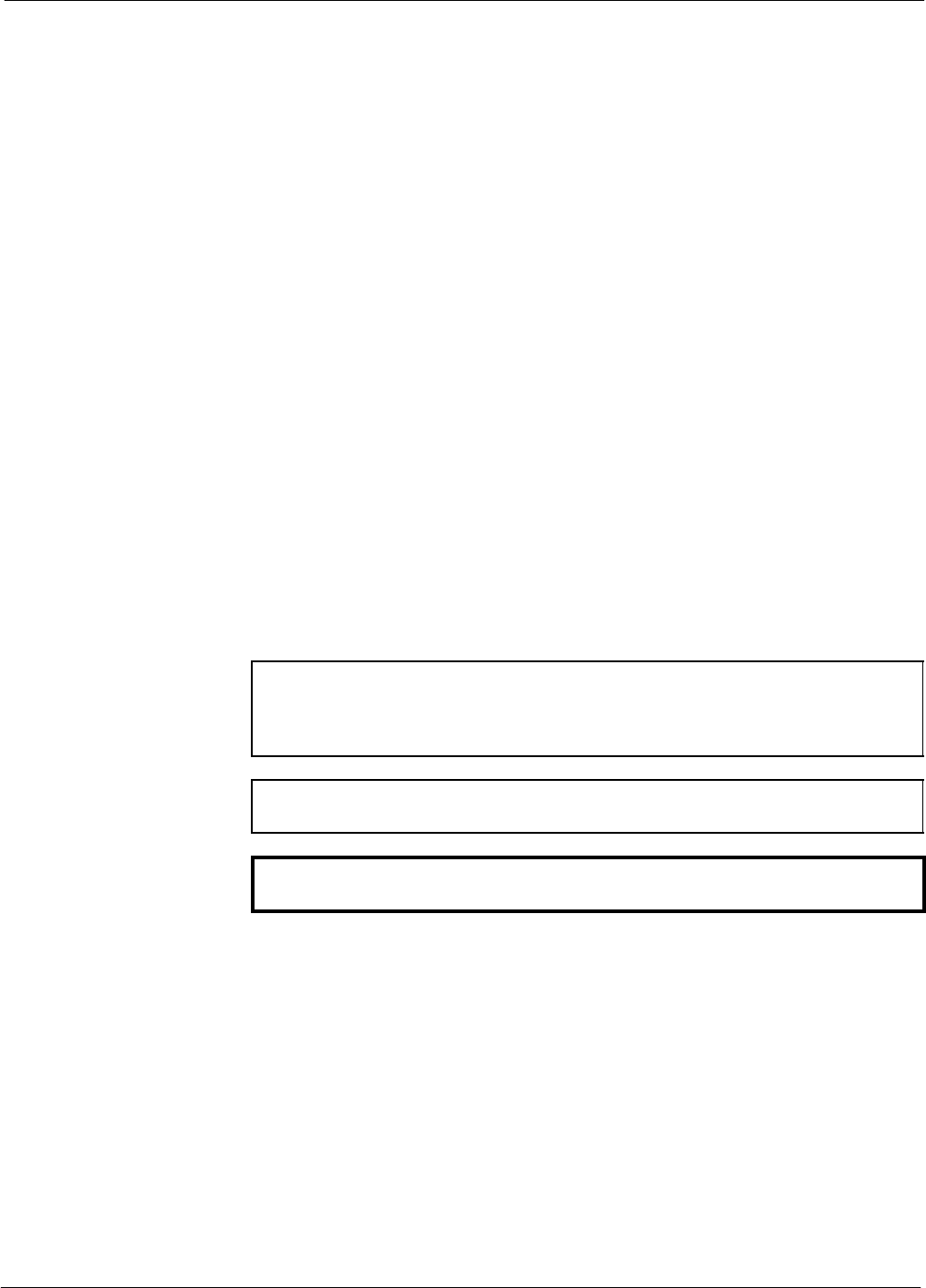
Foreword
68P09258A31–A
1X SCt 4812T BTS Optimization/ATP xxi
Oct 2003
Foreword
Scope of manual
This manual is intended for use by cellular telephone system
craftspersons in the day-to-day operation of Motorola cellular system
equipment and ancillary devices.
This manual is not intended to replace the system and equipment
training offered by Motorola, although it can be used to supplement or
enhance the knowledge gained through such training.
Obtaining Manuals
To view, download, order manuals (original or revised), visit the
Motorola Lifecycles Customer web page at http://services.motorola.com,
or contact your Motorola account representative.
If Motorola changes the content of a manual after the original printing
date, Motorola publishes a new version with the same part number but a
different revision character.
Text conventions
The following special paragraphs are used in this manual to point out
information that must be read. This information may be set-off from the
surrounding text, but is always preceded by a bold title in capital letters.
The three categories of these special paragraphs are:
NOTE Presents additional, helpful, non-critical information that you can
use. Bold-text notes indicate information to help you avoid
an undesirable situation or provides additional information
to help you understand a topic or concept.
CAUTION Presents information to identify a situation in which equipment
damage could occur, thus avoiding damage to equipment.
WARNING Presents information to warn you of a potentially hazardous
situation in which there is a possibility of personal injury.
The following typographical conventions are used for the presentation of
software information:
SIn text, sans serif BOLDFACE CAPITAL characters (a type style
without angular strokes: i.e., SERIF versus SANS SERIF) are used to
name a command.
SIn text, typewriter style characters represent prompts and the
system output as displayed on an operator terminal or printer.
SIn command definitions, sans serif boldface characters represent those
parts of the command string that must be entered exactly as shown and
typewriter style characters represent command output responses
as displayed on an operator terminal or printer.
SIn the command format of the command definition, typewriter
style characters represent the command parameters.

Foreword 68P09258A31–A
1X SCt 4812T BTS Optimization/ATP
xxii Oct 2003
Reporting manual errors
To report a documentation error, call the CNRC (Customer Network
Resolution Center) and provide the following information to enable
CNRC to open an MR (Modification Request):
– the document type
– the manual title, part number, and revision character
– the page number(s) with the error
– a detailed description of the error and if possible the proposed solution
Motorola appreciates feedback from the users of our manuals.
Contact us
Send questions and comments regarding user documentation to the email
address below:
cdma.documentation@motorola.com
Motorola appreciates feedback from the users of our information.
Manual banner definitions
A banner (oversized text on the bottom of the page, for example,
PRELIMINARY) indicates that some information contained in the
manual is not yet approved for general customer use.
24-hour support service
If you have problems regarding the operation of your equipment, please
contact the Customer Network Resolution Center for immediate
assistance. The 24 hour telephone numbers are:
NA CNRC +1–800–433–5202
EMEA CNRC +44– (0) 1793–565444
ASPAC CNRC +86–10–88417733
Japan & Korea CNRC +81–3–5463–3550
LAC CNRC +51–1–212–4020
For further CNRC contact information, contact your Motorola account
representative.

General Safety
68P09258A31–A
1X SCt 4812T BTS Optimization/ATP xxiii
Oct 2003
General Safety
Remember! . . . Safety
depends on you!!
The following general safety precautions must be observed during all
phases of operation, service, and repair of the equipment described in
this manual. Failure to comply with these precautions or with specific
warnings elsewhere in this manual violates safety standards of design,
manufacture, and intended use of the equipment. Motorola, Inc. assumes
no liability for the customer’s failure to comply with these requirements.
The safety precautions listed below represent warnings of certain dangers
of which we are aware. You, as the user of this product, should follow
these warnings and all other safety precautions necessary for the safe
operation of the equipment in your operating environment.
Ground the instrument
To minimize shock hazard, the equipment chassis and enclosure must be
connected to an electrical ground. If the equipment is supplied with a
three-conductor ac power cable, the power cable must be either plugged
into an approved three-contact electrical outlet or used with a
three-contact to two-contact adapter. The three-contact to two-contact
adapter must have the grounding wire (green) firmly connected to an
electrical ground (safety ground) at the power outlet. The power jack and
mating plug of the power cable must meet International Electrotechnical
Commission (IEC) safety standards.
NOTE Refer to Grounding Guideline for Cellular Radio Installations –
68P81150E62.
Do not operate in an explosive
atmosphere
Do not operate the equipment in the presence of flammable gases or
fumes. Operation of any electrical equipment in such an environment
constitutes a definite safety hazard.
Keep away from live circuits
Operating personnel must:
Snot remove equipment covers. Only Factory Authorized Service
Personnel or other qualified maintenance personnel may remove
equipment covers for internal subassembly, or component
replacement, or any internal adjustment.
Snot replace components with power cable connected. Under certain
conditions, dangerous voltages may exist even with the power cable
removed.
Salways disconnect power and discharge circuits before touching them.
Do not service or adjust alone
Do not attempt internal service or adjustment, unless another person,
capable of rendering first aid and resuscitation, is present.

General Safety 68P09258A31–A
1X SCt 4812T BTS Optimization/ATP
xxiv Oct 2003
Use caution when exposing or
handling the CRT
Breakage of the Cathode–Ray Tube (CRT) causes a high-velocity
scattering of glass fragments (implosion). To prevent CRT implosion,
avoid rough handling or jarring of the equipment. The CRT should be
handled only by qualified maintenance personnel, using approved safety
mask and gloves.
Do not substitute parts or
modify equipment
Because of the danger of introducing additional hazards, do not install
substitute parts or perform any unauthorized modification of equipment.
Contact Motorola Warranty and Repair for service and repair to ensure
that safety features are maintained.
Dangerous procedure
warnings
Warnings, such as the example below, precede potentially dangerous
procedures throughout this manual. Instructions contained in the
warnings must be followed. You should also employ all other safety
precautions that you deem necessary for the operation of the equipment
in your operating environment.
WARNING Dangerous voltages, capable of causing death, are present in this
equipment. Use extreme caution when handling, testing, and
adjusting.
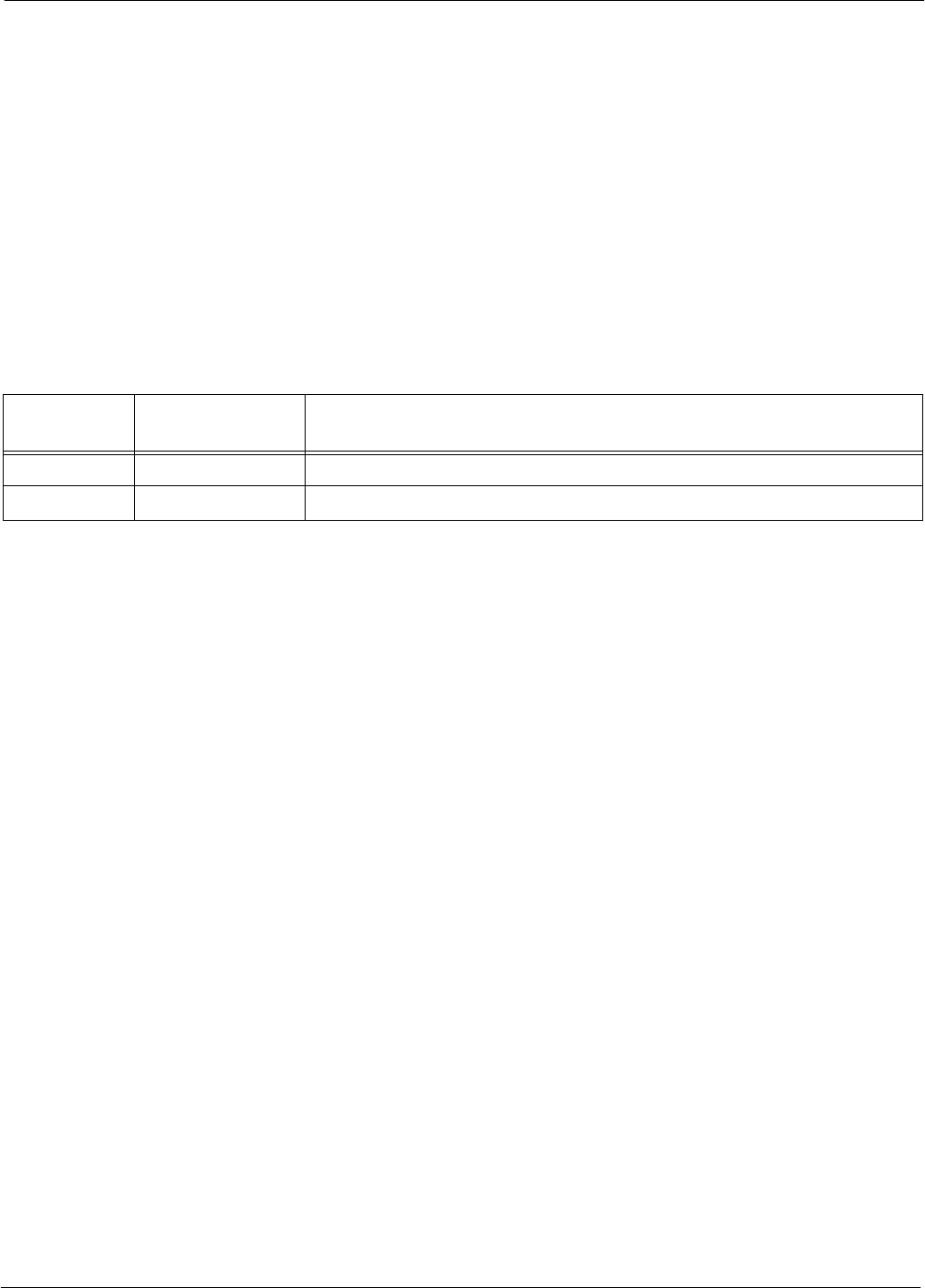
Revision History
68P09258A31–A
1X SCt 4812T BTS Optimization/ATP xxv
Oct 2003
Revision History
Manual Number
68P09258A31–A
Manual Title
1X SCt 4812T BTS Optimization/ATP
Version Information
The following table lists the manual version, date of version, and
remarks on the version. Revision bars printed in page margins (as shown
to the side) identify material which has changed from the previous
release of this publication.
Version
Level
Date of Issue Remarks
1Aug 2003 FOA
AOct 2003 General Availability

Revision History 68P09258A31–A
1X SCt 4812T BTS Optimization/ATP
xxvi Oct 2003
Notes

Oct 2003 1X SCt 4812T BTS Optimization/ATP 1-1
Chapter 1
Introduction
1

Optimization Manual: Scope and Layout 68P09258A31–A
Oct 2003
1X SCt 4812T BTS Optimization/ATP
1-2
Optimization Manual: Scope and Layout
Manual Scope and Layout
This document provides information pertaining to the optimization and
audit tests of Motorola SC 4812T Base Transceiver Subsystem (BTS)
equipment frames equipped with trunked high–power Power Amplifiers
(PAs) and their associated internal and external interfaces.
Also covered is Software Release R2.16.3.x which supports the
following versions of SC 4812T BTS sites:
– 1X Circuit BTS
– 1X Packet backhaul BTS
The 1X packet BTS has a packet backhaul network interface which is
provided via a pair of routers together with a GLI upgrade (GLI3) that
can handle voice (IS-95A/B, 1X) and data (IS-95B, 1X).
This BTS equipment is configured with all 1X cards (BBX–1X
andMCC1X) or a mix of 1X cards and non–1X cards (BBX2 and
MCC8E/24E). This configuration is compliant with all applicable
cdma2000 1X specifications. It provides the forward link and reverse
link RF functions to support 2G features and 3G-1X features (i.e., high
capacity voice and high bit rate data).
The 1X circuit BTS has a split backhaul (circuit/packet pipe) network
interface that can handle circuit based voice (IS-95A/B, 1X) and data
(IS-95B) as well as packet based data (1X).
Assumptions and Prerequisites
This document assumes the following prerequisites: The BTS frames
and cabling have been installed per the SC Product Family Frame
Mounting Guide manual, which covers the physical “bolt down” of all
SC series equipment frames, and the 1X SC 4812T BTS Hardware
Installation manual, which covers BTS specific cabling configurations.
In most applications the same test procedure is used for all equipment
variations. However, decision break points are provided throughout the
procedure when equipment specific tests are required.
NOTE As the Code Division Multiple Access (CDMA) Local
Maintenance Facility (LMF) capability comes on–line,
applicable LMF based procedures will be incorporated.
Eventually, only the CDMA LMF platform will be supported as
the recommended customer method of interfacing with and
servicing the SC series BTS equipment.
We at Motorola Technical Information Products and Services have
strived to incorporate into this document the many suggestions and
inputs received from you, the customer, since the inception of the SC
product line. At the same time, we have tried to insure that the scope of
the document targets both the novice and expert site technician and
engineer with the information required to successfully perform the
task at hand.
1

Optimization Manual: Scope and Layout68P09258A31–A
Oct 2003 1X SCt 4812T BTS Optimization/ATP 1-3
Document Composition
This document covers the following major areas.
SIntroduction, consisting of preliminary background information (such
as component and subassembly locations and frame layouts) to be
considered by the Cellular Field Engineer (CFE) before optimization
or tests are performed.
SPreliminary Operations, consisting of pre–power up tests, jumper
configuration of BTS sub–assemblies, and initial application of power
to the BTS equipment frames. Download of all BTS processor boards,
and PAs.
SOptimization/Calibration, consisting of downloading all BTS
processor boards, PA verification, radio frequency (RF) path
verification, Bay Level Offset (BLO) calibration, and Radio
Frequency Diagnostic System (RFDS) functions and calibration
SAcceptance Test Procedures (ATP), consisting of automated ATP
scripts executed by the LMF and used to verify all major transmit
(TX) and receive (RX) performance characteristics on all BTS
equipment. Also generates an ATP report.
SOptional manual performance tests used to verify specific areas of site
operation or to verify regulation compliance. These tests are typically
used to isolate faults down to the module level and information
necessary to better understand equipment operation.
SSite turnover after ATP is completed.
SAppendices include:
– Data sheets for CFE’s recording at the site
– Pseudorandom Noise (PN) Offset information
– Optimization/ATP matrix
– BBX Gain set point vs BTS output
– CDMA operating frequency programming information
– Manual test setup information
– Downloading ROM and RAM code
– In–service calibration procedures
– GPIB addresses
– Procedures for verifying that the Voltage Standing Wave Ratio
(VSWR) of all antennas and associated feed lines fall within
acceptable limits
1

Purpose of the Optimization 68P09258A31–A
Oct 2003
1X SCt 4812T BTS Optimization/ATP
1-4
Purpose of the Optimization
Why Optimize?
Proper optimization and calibration assures:
SAccurate downlink RF power levels are transmitted from the site.
SAccurate uplink signal strength determinations are made by the site.
What Is Optimization?
Optimization compensates for the site-specific cabling and normal
equipment variations. Cables that interconnect the BTS and Duplexer
assemblies (if used), for example, are cut and installed at the time of the
BTS frame installation at the site. Site optimization guarantees that the
combined losses of the new cables and the gain/loss characteristics and
built-in tolerances of each BTS frame do not accumulate, causing
improper site operation.
What Happens During Optimization?
Overview – During optimization, the accumulated path loss or gain is
first determined for each RF transmit path in the BTS. These transmit
path loss or gain values are then stored in a database along with RF
receive path default values.
RF path definitions – For definitions of the BTS transmit (TX) and
receive (RX) paths, see “Bay Level Offset Calibration” in Chapter 3.
RF paths and transceiver optimization – Six of the seven Broad Band
Transceiver (BBX) boards in each CCP shelf are optimized to specific
RX and TX antenna connectors. The seventh BBX board acts in a
redundant capacity for BBX boards 1 through 6, and is optimized to all
antenna connectors. A single optimization value is generated for each
complete path. This eliminates the accumulation of error that would
occur from individually measuring and summing the gain and loss of
each element in the path.
Using RF path gain/loss values – BTS equipment factors in the derived
optimization values internally to adjust transceiver power levels, leaving
only site–specific antenna feedline loss and antenna gain characteristics
to be factored in by the CFE when determining required site Effective
Radiated Power (ERP) output power levels.
1

When to Optimize68P09258A31–A
Oct 2003 1X SCt 4812T BTS Optimization/ATP 1-5
When to Optimize
New Installations
The following operations and optimization/test actions should be
accomplished for a new BTS or frame installation:
1. After the initial site installation, it must be prepared for operation.
This preparation includes verifying hardware installation, initial
power–up, download of operating code, and Clock Synchronization
Module (CSM) verification.
2. Next, the optimization is performed. Optimization includes
performance verification and calibration of all transmit and receive
RF paths, and download of accumulated calibration data.
3. A calibration audit of all RF transmit paths may be performed any
time after optimization to verify BTS calibration.
4. After optimization, a series of manual pre–Acceptance Test
Procedure (ATP) verification tests are performed to verify
alarm/redundancy performance.
5. After manual pre–ATP verification tests, an ATP is performed to
verify BTS performance. An ATP is also required to demonstrate
regulation compliance before the site can be placed in service.
Site Expansion
Optimization is required after expansion of a site with additional BTS
frames.
Periodic Optimization
Periodic optimization of a site may also be required, depending on the
requirements of the overall system.
Repaired Sites
Refer to Appendix C for a detailed FRU Optimization/ATP Test Matrix
outlining the minimum tests that must be performed any time a BTS RF
subassembly or cable associated with an RF path is replaced.
1

Required Test Equipment and Software 68P09258A31–A
Oct 2003
1X SCt 4812T BTS Optimization/ATP
1-6
Required Test Equipment and Software
Overview
Test equipment and software described in this section is required for the
optimization procedure. Common assorted tools such as screwdrivers
and frame keys are also needed. Read the owner’s manual for all of the
test equipment to understand its individual operation before using the
tool in the optimization.
Policy
To ensure consistent, reliable, and repeatable optimization test results,
test equipment and software meeting the following technical criteria
should be used to optimize the BTS equipment. Test equipment can, of
course, be substituted with other test equipment models if the equipment
meets the same technical specifications.
NOTE During manual testing, you can, of course, substitute test
equipment with other test equipment models not supported by
the LMF, but those models must meet the same technical
specifications.
It is the responsibility of the customer to account for any measurement
variances and/or additional losses/inaccuracies that can be introduced
as a result of these substitutions. Before beginning optimization or
troubleshooting, make sure that the test equipment needed is on–hand
and operating properly.
Test Equipment Calibration
Optimum system performance and capacity depend on regular equipment
service, calibration prior to BTS optimization. Follow the original
equipment manufacturer (OEM) recommended maintenance and
calibration schedules closely.
Test Cable Calibration
Test cables can make critical differences in optimization accuracy. It is
recommended that cable calibration be run at every BTS with the
complete test equipment set. This method compensates for test cable
insertion loss within the test equipment itself. No other allowance for
test cable insertion loss needs to be made during the performance of
tests.
Another method to account for cable loss is by entering it into the LMF
during the optimization procedure. This method requires accurate test
cable characterization using shop test equipment. Characterized cables
should be tagged with the characterization information, and the
measured losses entered into the LMF before field optimization.
1

Required Test Equipment and Software68P09258A31–A
Oct 2003 1X SCt 4812T BTS Optimization/ATP 1-7
Equipment Warm–up
After arriving at a site, test equipment should be plugged in and turned
on immediately to provide the longest possible time for warm up and
stabilization. The following pieces of test equipment must be
warmed–up for a minimum of 60 minutes prior to using for BTS
optimization or RFDS calibration procedures.
SCommunications Test Set (Agilent E7495A requires only 30 minutes).
SRubidium Time Base.
SPower Meter.
LMF computer and software
LMF Hardware Requirements
An LMF computer platform that meets the following requirements (or
better) is recommended:
SNotebook computer
S266 MHz (32–bit CPU) Pentium processor
SMSr Windows 98R Second Edition (SE) or Windows 2000 operating
system
S4 GB internal hard disk drive
SSVGA 12.1–inch active matrix color display with 1024 x 768
(recommended) or 800 x 600 pixel resolution and capability to display
more than 265 colors
NOTE If 800 x 600 pixel resolution is used, the LMF window must be
maximized after it is displayed.
SMemory requirements:
– Minimum required RAM: 96 MB
– Recommended RAM:
–– 128 MB for Windows 98 SE
–– 256 MB for Windows 2000
S20X CD ROM drive
S3 1/2 inch floppy drive
S56kbps V.90 modem
SSerial port (COM 1)
SParallel port (LPT 1)
SPCMCIA Ethernet interface card (for example, 3COM Etherlink III)
with a 10Base–T–to–coax adapter
1
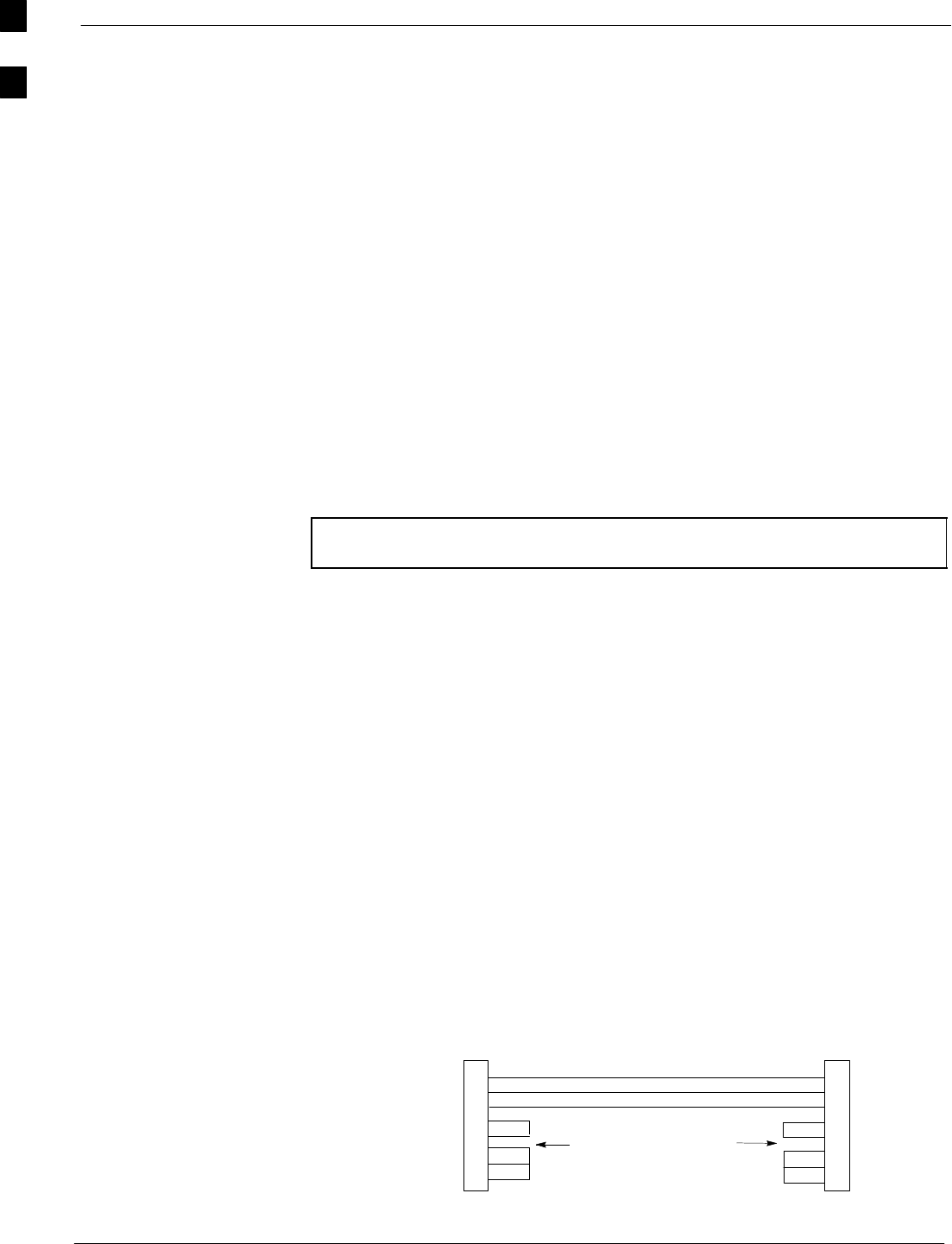
Required Test Equipment and Software 68P09258A31–A
Oct 2003
1X SCt 4812T BTS Optimization/ATP
1-8
LMF Software
The Local Maintenance Facility (LMF) application program is a
graphical user interface (GUI)–based software tool. This product is
specifically designed to provide cellular communications field personnel
with the capability to support the following CDMA Base Transceiver
Station (BTS) operations:
SInstallation
SMaintenance
SCalibration
SOptimization
Ethernet LAN Transceiver
SPCMCIA Ethernet Adpater + Ethernet UTP Adapter
3COM Model – Etherlink III 3C589B
10BaseT/10Base2 Converter
STransition Engineering Model E–CX–TBT–03 10BaseT/10Base2
Converter
NOTE Xircom Model PE3–10B2 or equivalent can also be used to
interface the LMF Ethernet connection to the frame.
3C–PC–COMBO CBL
SConnects to the 3COM PCMCIA card and eliminates the need for a
10BaseT/10base2 Converter.
RS–232 to GPIB Interface
SNational Instruments GPIB–232–CT with Motorola CGDSEDN04X
RS232 serial null modem cable or equivalent; used to interface the
LMF to the test equipment.
SStandard RS–232 cable can be used with the following modifications
(see Figure 1-1):
– This solution passes only the 3 minimum electrical connections
between the LMF and the General Purpose Information Bus (GPIB)
interface. The control signals are jumpered as enabled on both ends
of the RS–232 cable (9–pin D). TX and RX signals are crossed as
Null Modem effect. Pin 5 is the ground reference.
– Short pins 7 and 8 together, and short pins 1, 4, and 6 together on
each connector.
Figure 1-1: Null Modem Cable Detail
5
3
2
7
8
1
4
6
GND
RX
TX
RTS
CTS
RSD/DCD
DTR
DSR
GND
TX
RX
RTS
CTS
RSD/DCD
DTR
DSR
ON BOTH CONNECTORS
SHORT PINS 7, 8;
SHORT PINS 1, 4, & 6
9–PIN D–FEMALE 9–PIN D–FEMALE
5
2
3
7
8
1
4
6
FW00362
1
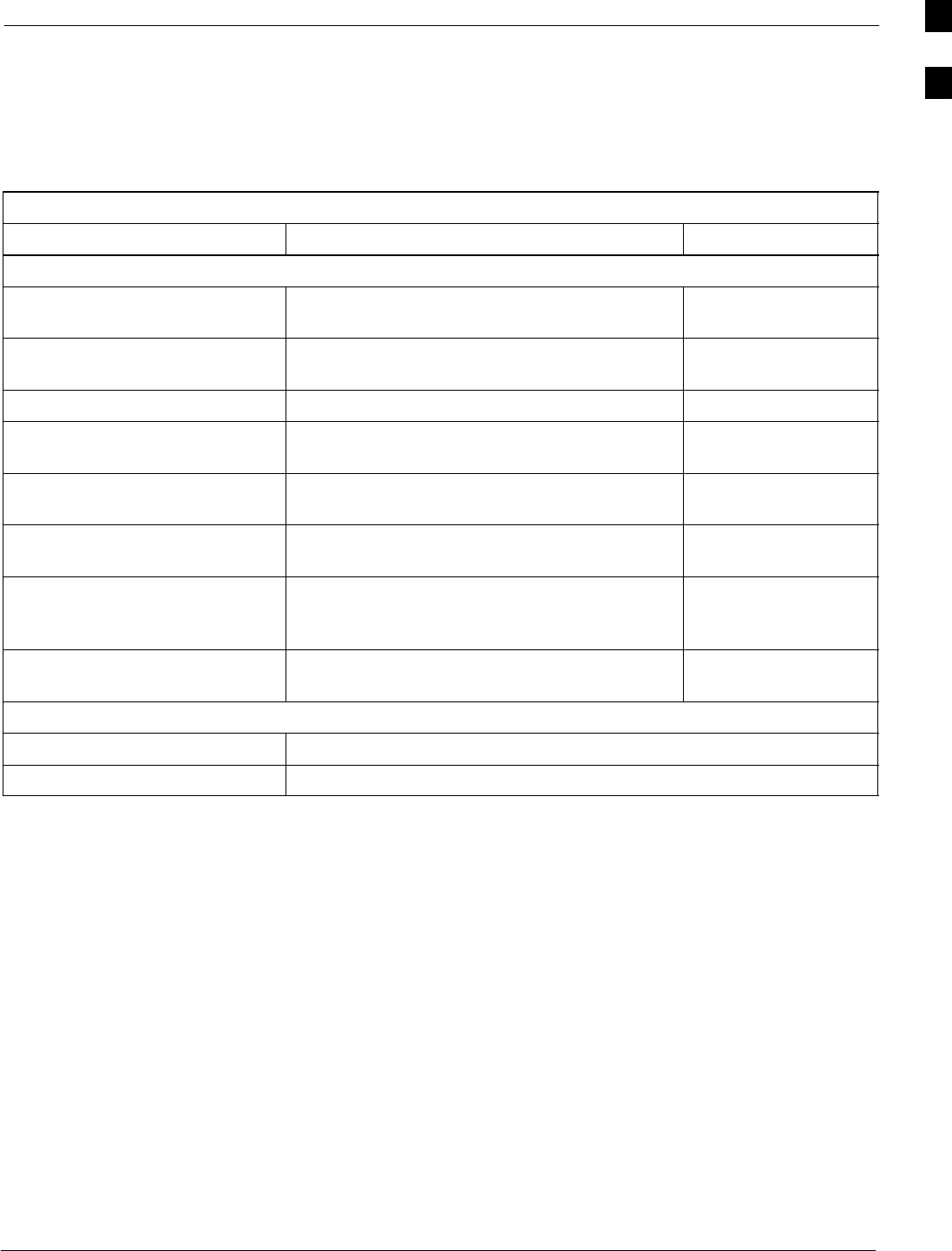
Required Test Equipment and Software68P09258A31–A
Oct 2003 1X SCt 4812T BTS Optimization/ATP 1-9
MMI Interface Kit
Motorola cable part number CGDSMMICABLE219112 is used to
connect the LMF to the BTS.
Communications system analyzer CDMA/analog
Table 1-1: CDMA LMF Test Equipment Support Table
Item Description Test Capability
Test Sets
Hewlett Packard, model
HP 8921A (with 83203B)
Communications analyzer (includes 83203B
CDMA interface option)
IS–95A/B only
Hewlett Packard, model
HP 83236A
PCS interface for PCS band IS–95A/B only
Motorola CyberTest Communications analyzer IS–95A/B only
Advantest R3465 (with 3561L) Communications analyzer (with 3561 CDMA
option)
IS–95A/B only
Agilent E4406A (with E4432B) Communications analyzer (with Generator) IS–95A/B and
CDMA 2000 testing
Advantest R3267 Analyzer (with
R3562)
Communciations Analyzer with Advantest
R3562 Generator
IS–95A/B and
CDMA 2000 testing
Agilent 8935 series E6380A
(formerly HP 8935) with option
200 or R2K
Communications test set IS–95A/B and
CDMA 2000 testing
Agilent E7495A Communications test set IS–95A/B and
CDMA 2000 testing
Power Meters
Gigatronix 8541C Power meter
HP437B (with HP8481A sensor) Power meter with sensor – capable of measuring –30 dBm to 20 dBm
A combination of test equipment supported by the LMF may also be
used during optimization and testing of the RF communications portion
of BTS equipment when the communications system analyzer does not
perform all of the following functions:
SFrequency counter
SDeviation meter
SRF power meter (average and code domain)
SRF signal generator (capable of DSAT/CDMA modulation)
SAudio signal generator
SAC voltmeter (with 600–ohm balanced audio input and high
impedance input mode)
SNoise measurement meter
SC–Message filter
SSpectrum analyzer
SCDMA code domain analyzer
1

Required Test Equipment and Software 68P09258A31–A
Oct 2003
1X SCt 4812T BTS Optimization/ATP
1-10
GPIB Cables
SHewlett Packard 10833A or equivalent; 1 to 2 meters (3 to 6 feet) long
used to interconnect test equipment and LMF terminal.
Timing Reference Cables
STwo BNC-male to BNC-male RG316 cables; 3.05 m (10 ft.) long.
Used to connect the communications analyzer to the front timing
reference of the CSM cards in the BTS frame.
Digital Multimeter
SFluke Model 8062A with Y8134 test lead kit or equivalent; used for
precision dc and ac measurements, requiring 4–1/2 digits.
Directional Coupler
SNarda Model 30661 30 dB (Motorola part no. 58D09732W01)
1900 MHz coupler terminated with two Narda Model 375BN–M
loads, or equivalent.
SNarda Model 30445 30 dB (Motorola Part No. 58D09643T01 )
800 MHz coupler terminated with two Narda Model 375BN–M loads,
or equivalent.
RF Attenuator
S20 dB fixed attenuator, 20 W (Narda 768–20); used with 1.7/1.9 GHz
test cable calibrations or during general troubleshooting procedures.
RF Terminations/Loads
SAt least three 100–Watt (or larger) non–radiating RF
terminations/loads.
Miscellaneous RF Adapters, Loads, etc
SAs required to interface test cables and BTS equipment and for
various test set ups. Should include at least two 50 Ohm loads (type
N) for calibration and one RF short, two N–Type Female–to–Female
Adapters.
LAN Cable
SBNC–to BNC 50 ohm coaxial cable [.91 m (3 ft) maximum] with an
F–to–F adapter, used to connect the 10BaseT–to–coaxial adapter to
the BTS LAN connector.
High–impedance Conductive Wrist Strap
SMotorola Model 42–80385A59; used to prevent damage from
Electrostatic Discharge (ESD) when handling or working with
modules.
1

Required Test Equipment and Software68P09258A31–A
Oct 2003 1X SCt 4812T BTS Optimization/ATP 1-11
Optional Equipment
NOTE Not all optional equipment specified here will be supported by
the LMF in automated tests or when executing various measure
type command line interface (CLI) commands. It is meant to
serve as a list of additional equipment that might be required
during maintenance and troubleshooting operations.
Frequency Counter
SStanford Research Systems SR620 or equivalent. If direct
measurement of the 3 MHz or 19.6608 MHz references is required.
Spectrum Analyzer
SSpectrum Analyzer (HP8594E with CDMA personality card) or
equivalent; required for manual tests.
Local Area Network (LAN) Tester
SModel NETcat 800 LAN troubleshooter (or equivalent); used to
supplement LAN tests using the ohmmeter.
Span Line (T1/E1) Verification Equipment
SAs required for local application
Oscilloscope
STektronics Model 2445 or equivalent; for waveform viewing, timing,
and measurements or during general troubleshooting procedure.
2–way Splitter
SMini–Circuits Model ZFSC–2–2500 or equivalent; provides the
diversity receive input to the BTS
High Stability 10 MHz Rubidium Standard
SStanford Research Systems SR625 or equivalent – required for CSM
and Low Frequency Receiver/High Stability Oscillator (LFR/HSO)
frequency verification.
Itasca Alarms Test Box
SItasca CGDSCMIS00014 – This test box may be used as a tool to
assist in the testing of customer alarms.
1

Required Documentation 68P09258A31–A
Oct 2003
1X SCt 4812T BTS Optimization/ATP
1-12
Required Documentation
Required Documents
The following documents are required to perform optimization of the
cell site equipment:
SSite Document (generated by Motorola Systems Engineering), which
includes:
– General Site Information
– Floor Plan
– RF Power Levels
– Frequency Plan (includes Site PN and Operating Frequencies)
– Channel Allocation (Paging, Traffic, etc.)
– Board Placement
– Site Wiring List
– CDF or NECF files (bts–#.cdf or bts–#.necf and cbsc–#.cdf)
SDemarcation Document (Scope of Work Agreement)
SEquipment manuals for non-Motorola test equipment
Related Publications
Additional, detailed information about the installation, operation, and
maintenance of the SC4812T BTS and its components is included in the
following publications:
SBTS Frame Installation Manual; 68P09226A18
S1X SC 4812T BTS Hardware Installation ; 68P09258A55
S1X SC 4812T BTS FRU Guide ; 68P09258A64
SCDMA LMF Operator’s Guide; 68P64114A78
SCDMA RFDS Hardware Installation manual; 68P64113A93
SCDMA RFDS User’s Guide, 68P64113A37
SLMF CLI Commands, R16, 68P09253A56
1
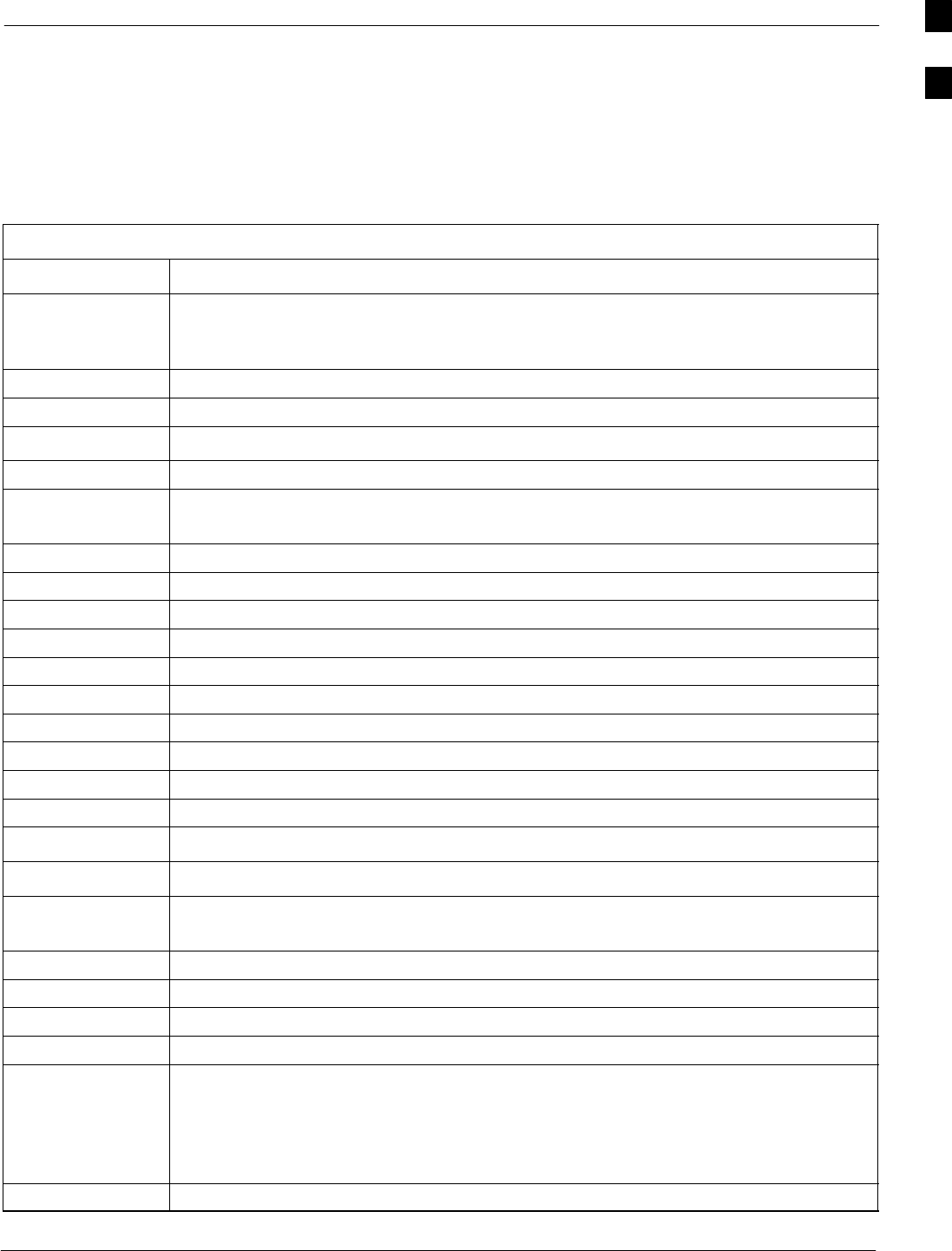
Terms and Abbreviations68P09258A31–A
Oct 2003 1X SCt 4812T BTS Optimization/ATP 1-13
Terms and Abbreviations
Standard and Non–standard Terms and Abbreviations
Standard terms and abbreviations used in this manual are defined in
Cellular Glossary of Terms and Acronyms; 68P09213A95. Any
non–standard terms or abbreviations included in this manual are listed in
Table 1-2.
Table 1-2: Abbreviations and Acronyms
Acronym Definition
1X One of two bandwidths currently defined in the IS–2000 CDMA specification, which
extends the capability of the IS–95A and B specifications. 1X bandwidth provides
wireless packet voice and data transmission capability at up to 144 Mbps.
BBX–1X Broadband Transceiver, 3rd Generation supports IS–95A/B and cdma2000 1X
BBX2 Broadband Transceiver, 2nd Generation supports IS–95A/B
BBXR Redundant BBX for a CCP shelf or cage.
C–CCP Combined CDMA Channel Processor
CCD Clock Combining and Distribution. CCP shelf module which accepts timing signals from
the active source and distributes them to other CCP shelf modules.
CIO Combiner Input/Output
DRDC Duplexer/RX Filter/Directional Coupler
EMPC Expansion Multicoupler Preselector Card
FWTIC Fixed Wireless Terminal Interface Card
GLI2 Group Line Interface, 2nd Generation card hardware version
GLI3 Group Line Interface, 3rd Generation card hardware version for packet backhaul
HSO High Stability Oscillator
HSOX High Stability Oscillator Expansion
LIF Load Information File
LORAN LOng RAnge Navigational
MCC8E Multichannel CDMA Card supporting 8 IS–95A/B channels.
MCC24E Multichannel CDMA Card supporting 24 IS–95A/B channels.
MCC–1X Multichannel CDMA Card supporting 16 or 48 CDMA2000 1X or (with Software
Release 2.16.0.84.3 and higher) IS–95A/B channels.
MPC Multicoupler Preselector Card
NECB Network Element Configuration Baseline
NECF Network Element Configuration File
NECJ Network Element Configuration Journal
OLF Object List File. File containing a list of the ROM and RAM code versions which should
be operating on every device installed in a BTS. The file is resident on the Central Base
Station Controller (CBSC) Mobility Manager (MM) and is passed to the GLI after a
DLM job is invoked. The GLI uses the OLF to determine which devices require code
download to meet the OLF–specified version.
PDA Power Distribution Assembly
. . . continued on next page
1
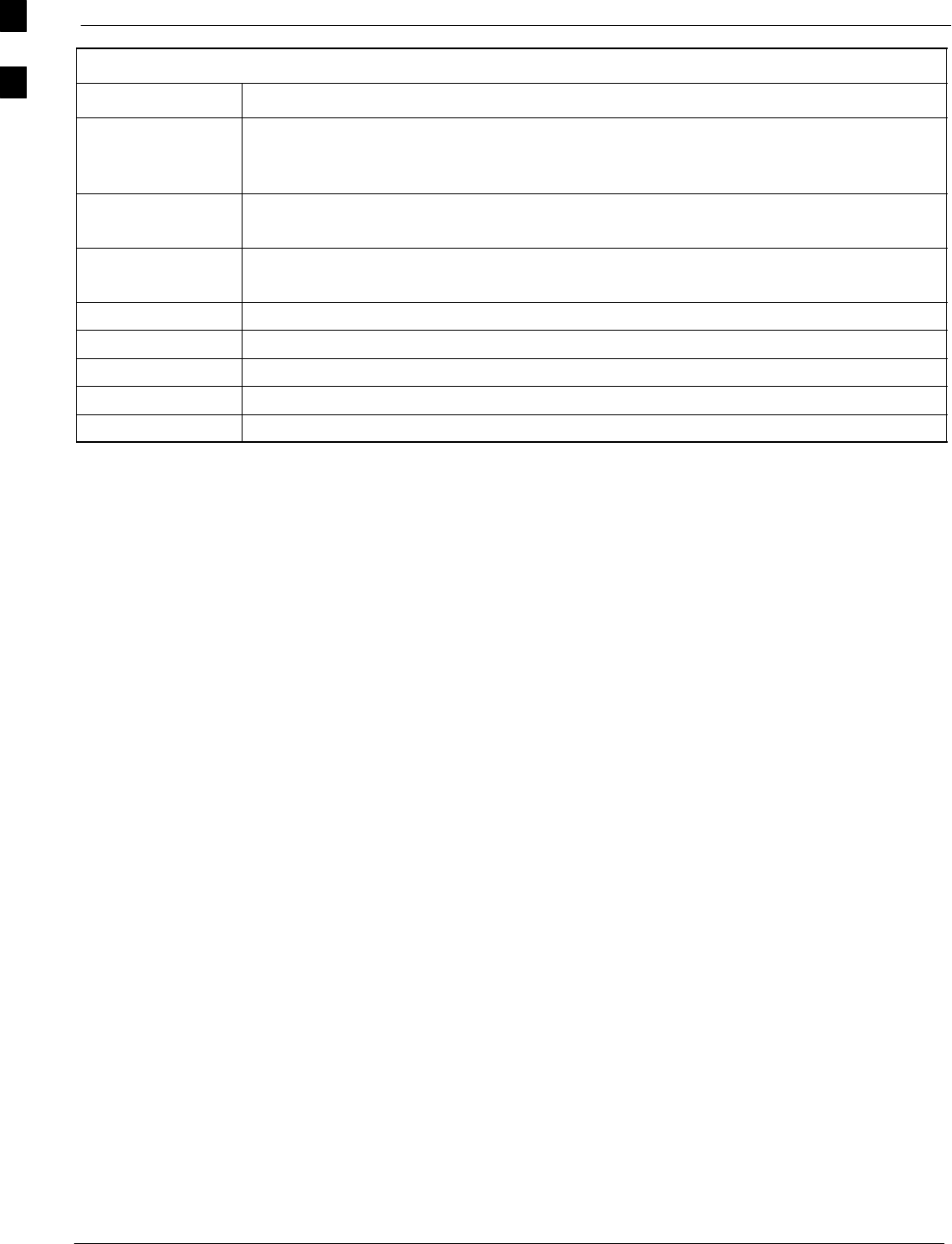
Terms and Abbreviations 68P09258A31–A
Oct 2003
1X SCt 4812T BTS Optimization/ATP
1-14
Table 1-2: Abbreviations and Acronyms
Acronym Definition
RGD Remote Global Positioning System (GPS) Distribution. Module which provides
distribution of digital timing information to up to four BTS RF modem frames (RFMFs)
from a single Remote GPS receiver.
RGPS Remote Global Positioning System. GPS receiver and signal distribution subsystem
which provides digital timing information for up to four BTS RFMFs at a cell site.
RHSO Remote High–Stability Oscillator. Subsystem which generates and distributes
synchronization signals from a single HSO to up to four RF modem frames.
SBPF Single Bandpass Filter
SNMP Simple Network Management Protocol
SUA Subscriber Unit Assembly
TRDC Transmit Receive filter/Directional Coupler
UTC Universal Time Coordinates
1

BTS Equipment Identification68P09258A31–A
Oct 2003 1X SCt 4812T BTS Optimization/ATP 1-15
BTS Equipment Identification
Equipment Overview
The Motorola SC 4812T BTS can consist of the following equipment
frames:
SAt least one BTS starter frame
– +27 V BTS (see Figure 1-2)
– –48 V BTS (see Figure 1-3)
SAncillary equipment frame (or wall mounted equipment)
SExpansion frames
– +27 V BTS (see Figure 1-4)
– –48 V BTS (see Figure 1-5)
Ancillary Equipment Frame Identification
NOTE Equipment listed below can be wall mounted or mounted in a
standard 19 inch frame. The description assumes that all
equipment is mounted in a frame for clarity.
If equipped with the RFDS option, the RFDS and directional couplers
are the interface between the site antennas and the BTS or Modem
frame. The RFDS equipment includes:
SDirectional couplers
SSite receive bandpass/bandreject filters
SRFDS
Logical BTS
The BTS software implements the logical BTS capability. Previously, all
BTS frames co–located at a single site had to be identified in the
network with separate and distinct BTS ID numbers. In the Logical BTS
feature, all frames located at a single BTS site are identified with unique
Frame ID numbers (Frame ID Numbers 1, 101, 201, 301) under a single
(site) BTS ID number. A logical BTS can consist of up to four
SC 4812T frames.When the LMF is connected to frame 1 of a logical
BTS, you can access all devices in all of the frames that make up the
logical BTS. A logical BTS requires a CDF/NECF file that includes
equipage information for all of the logical BTS frames and their devices
and a CBSC file that includes channel data for all of the logical BTS
frames.
1
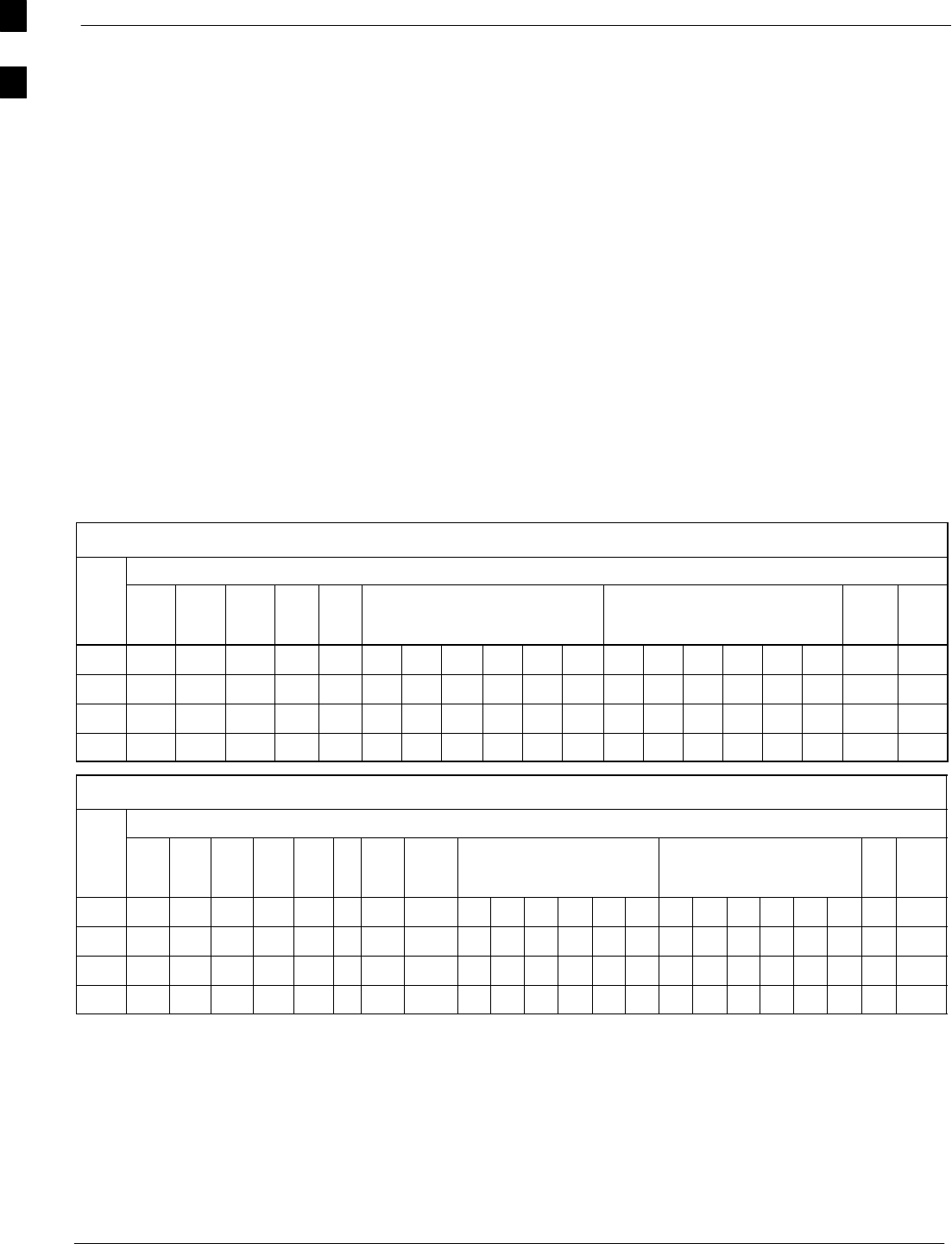
BTS Equipment Identification 68P09258A31–A
Oct 2003
1X SCt 4812T BTS Optimization/ATP
1-16
Logical BTS Numbering
The first frame of a logical BTS has a –1 suffix (e.g., BTS–812–1).
Other frames of the logical BTS are numbered with suffixes, –101, –201,
and –301 (e. g. BTS–812–201). When you log into a BTS, a FRAME
tab is displayed for each frame. If there is only one frame for the BTS,
there is only one tab (e.g., FRAME–282–1) for BTS–282. If a logical
BTS has more than one frame, there is a separate FRAME tab for each
frame (e.g. FRAME–438–1, FRAME–438–101, and FRAME–438–201
for a BTS–438 that has three frames). If an RFDS is included in the
CDF/NECF file, an RFDS tab (e.g., RFDS–438–1) is displayed.
Actions (e.g., ATP tests) can be initiated for selected devices in one or
more frames of a logical BTS. Refer to the Select devices help screen for
information on how to select devices.
C–CCP Shelf Card/Module Device ID Numbers
All cards/modules/boards in the frames at a single site, assigned to a
single BTS number, are also identified with unique Device ID numbers
dependent upon the Frame ID number in which they are located. Refer to
Table 1-3 and Table 1-4 for specific C–CCP Shelf Device ID numbers.
Table 1-3: C–CCP Shelf/Cage Card/Module Device ID Numbers (Top Shelf)
Frame
#
Card/Module ID Number (Left to Right)
#Power
(PS–1)
Power
(PS–2)
Power
(PS–3)
AMR
–1
GLI2
–1
MCC BBX BBX–
R
MPC/
EMPC
–1
1 – – – 1 1 1 2 3 4 5 6 1 2 3 4 5 6 R1 –
101 –––101 101 101 102 103 104 105 106 101 102 103 104 105 106 R101 –
201 –––201 201 201 202 203 204 205 206 201 202 203 204 205 206 R201 –
301 –––301 301 301 302 303 304 305 306 301 302 303 304 305 306 R301 –
Table 1-4: C–CCP Shelf/Cage Card/Module Device ID Numbers (Bottom Shelf)
Frame
#
Card/Module ID Number (Left to Right)
#HSO/
LFR
CSM
–1
CSM
–2
CCD
A
CCD
B
AMR
–2
GLI2–
2
MCC BBX SW MPC/
EMPC
–2
1 – 1 2 – – – 2 2 7 8 9 10 11 12 7 8 9 10 11 12 – –
101 –101 102 – – – 102 102 107 108 109 110 111 112 107 108 109 110 111 112 – –
201 –201 202 – – – 202 202 207 208 209 210 211 212 207 208 209 210 211 212 – –
301 –301 302 – – – 302 302 307 308 309 310 311 312 307 308 309 310 311 312 – –
1
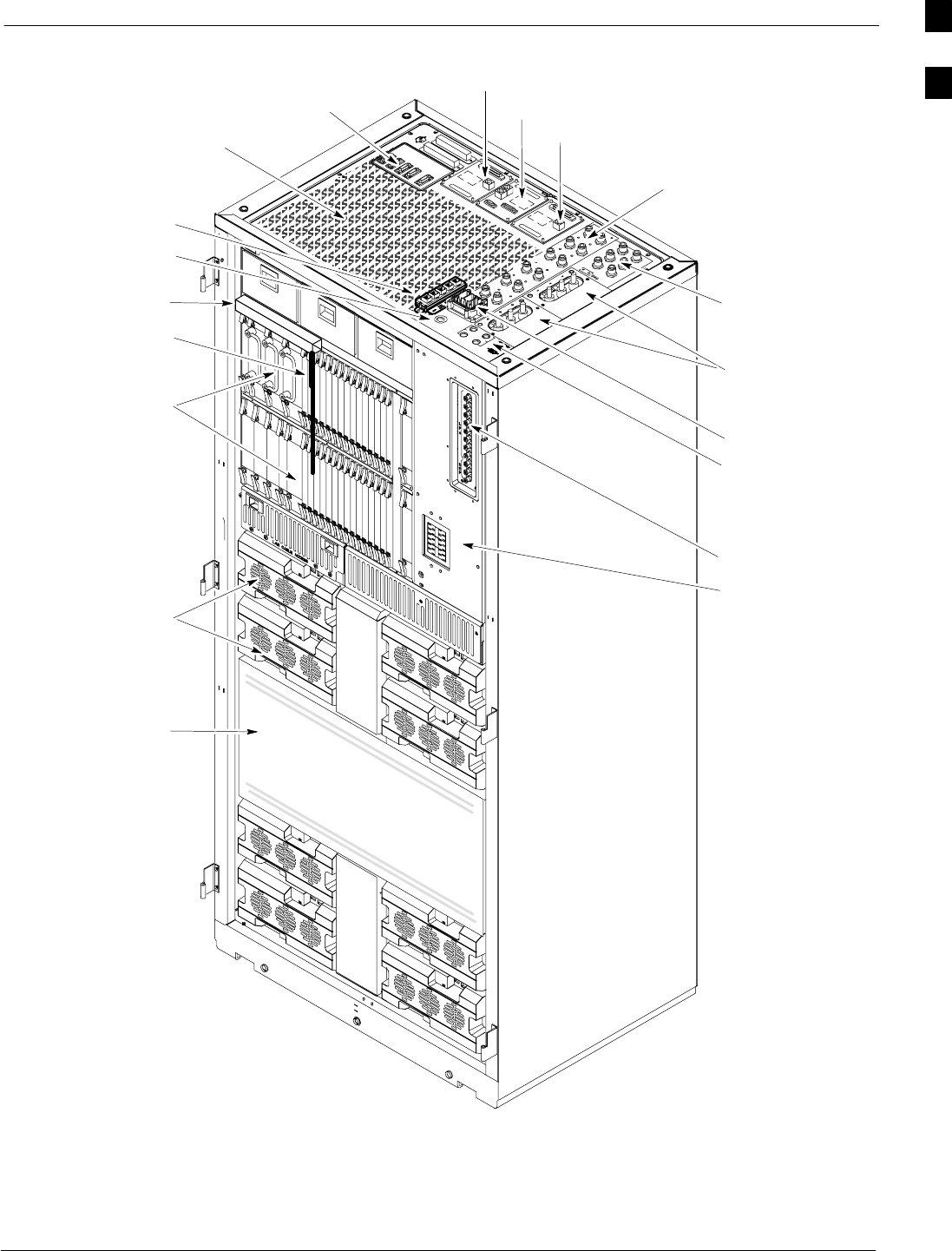
BTS Equipment Identification68P09258A31–A
Oct 2003 1X SCt 4812T BTS Optimization/ATP 1-17
Figure 1-2: +27 V SC 4812T BTS Starter Frame
Expansion I/O
Housing
For clarity, doors are not shown.
Front Cosmetic
Panel
Power Input
Connection
TX Out (1 – 6)
Span I/O B
Span I/O A
Site I/O
RX In (1A – 6A
and 1B – 6B)
Exhaust Region
C–CCP Cage
Breakers
Combiner
Section
RGD (Needed for
Expansion only)
Powr
Amplifier
Cage
ti-CDMA-WP-00098-v01-ildoc-ftw
BPR to GLI
Interconnect Panel
FE Cable Tray
FE Cables
(BPR to GLI)
GPS IN
F F LAN OUT
A B
F F LAN IN
1
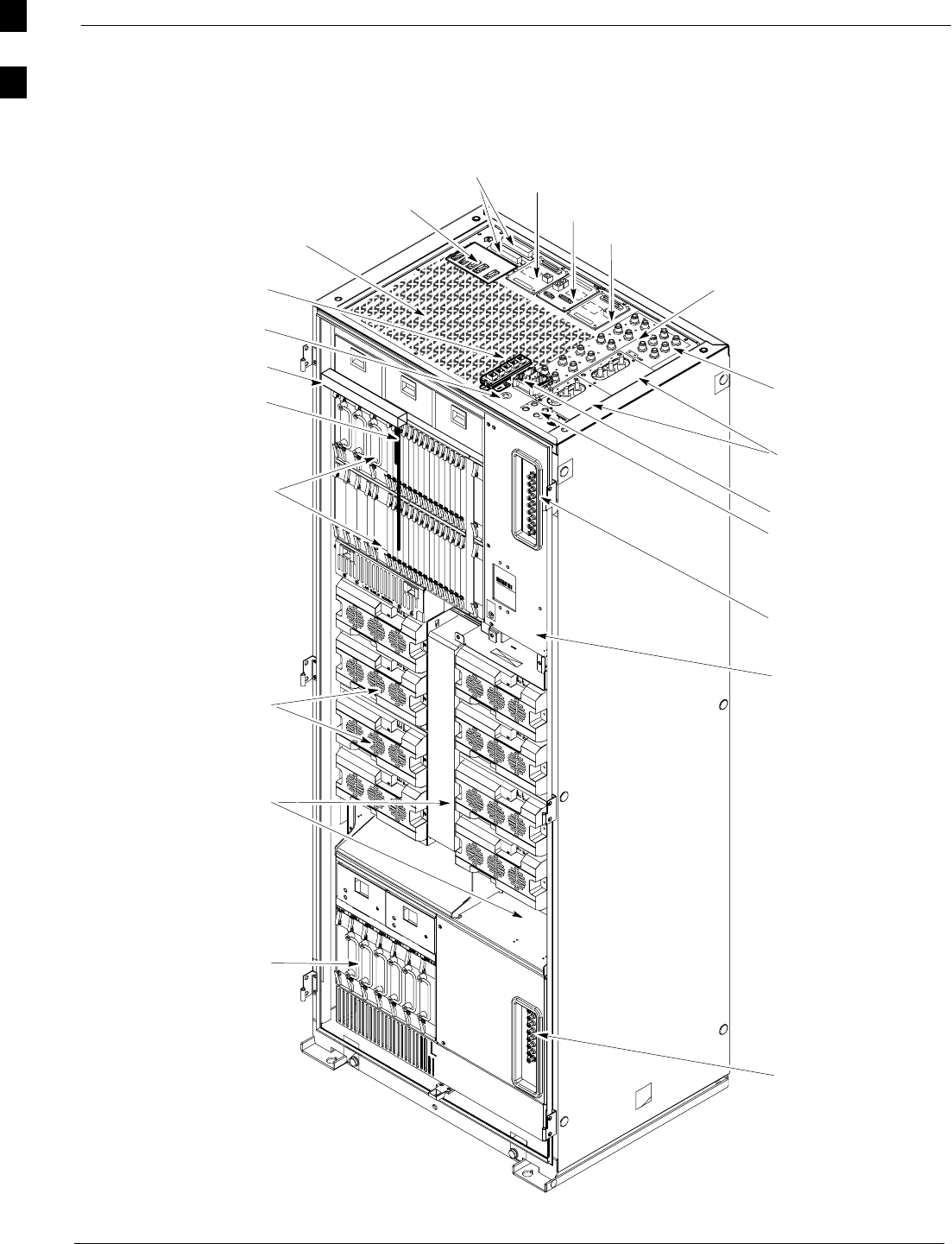
BTS Equipment Identification 68P09258A31–A
Oct 2003
1X SCt 4812T BTS Optimization/ATP
1-18
Figure 1-3: –48 V SC 4812T BTS Starter Frame (2100 mm)
For clarity, doors are not shown.
Front Cosmetic
Panel
Power Input
Connection
TX Out (1 – 6)
Span I/O B
Span I/O A
Site I/O
RX In (1A – 6A
and 1B – 6B)
Exhaust Region
–48Vdc
Power Supply
Breakers
RGD (Needed for
Expansion only)
Breakers
Alarms
ti-CDMA-WP-00097-v01-ildoc-ftw
BPR to GLI
Interconnect Panel
FE Cable Tray
FE Cables
(BPR to GLI)
C–CCP Cage
Combiner
Section
Power
Amplifier
Cage
Power
Conversion
Shelf
Expansion I/O
Housing
F F LAN OUT
A B
F F LAN IN
GPS IN
1
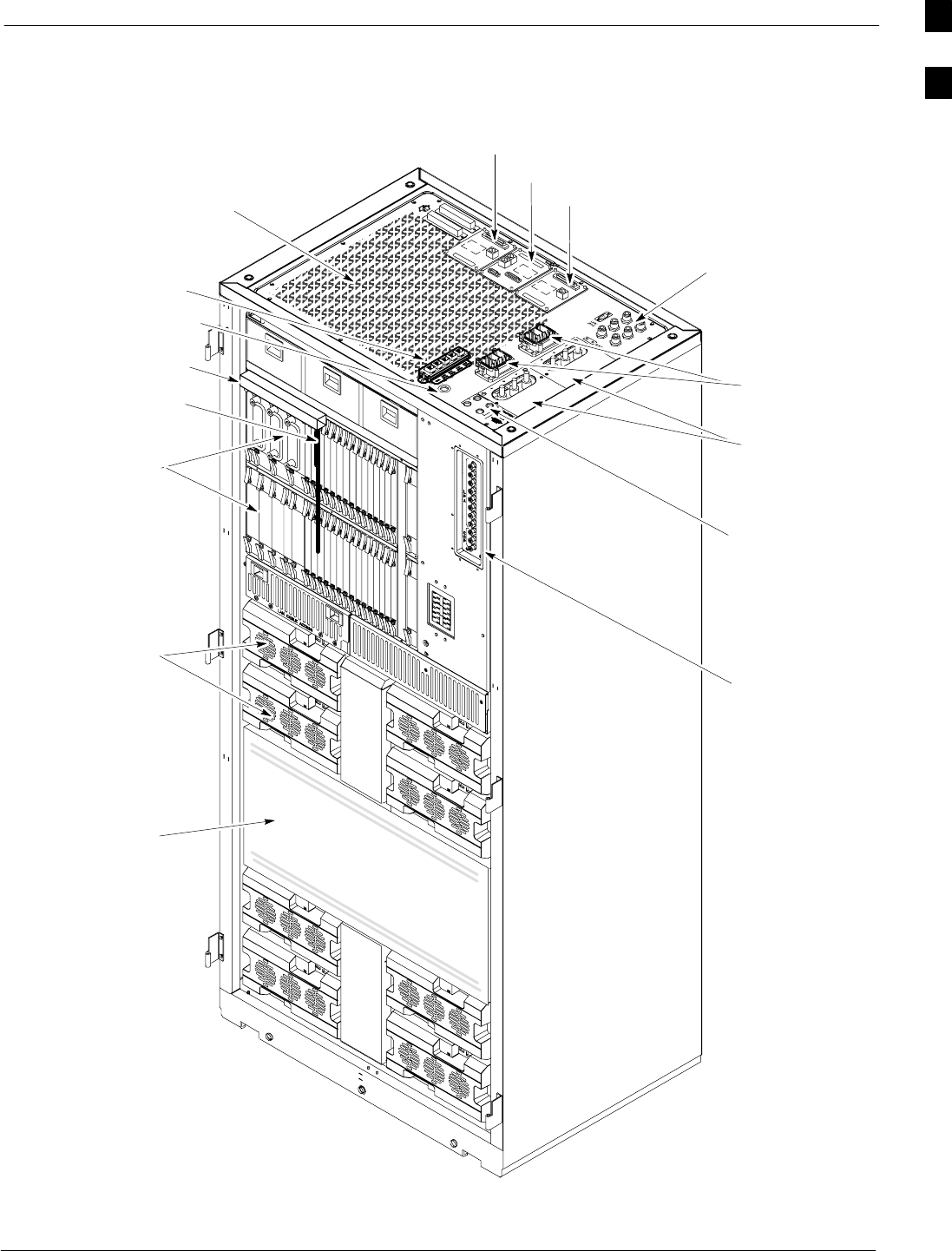
BTS Equipment Identification68P09258A31–A
Oct 2003 1X SCt 4812T BTS Optimization/ATP 1-19
Figure 1-4: +27 V SC 4812T BTS Expansion Frame
Power Input
Connection
TX Out (1 – 6)
Span I/O B
Span I/O A
Site I/O
Expansion Port
to another BTS
Exhaust Region
C–CCP Cage
Breakers
Power
Amplifier
Cage
For clarity, doors are not shown.
ti-CDMA-WP-00110-v01-ildoc-ftw
Combiner
Section
BPR to GLI
Interconnect Panel
FE Cable Tray
FE Cables
(BPR to GLI)
F F LAN OUT
A B
F F LAN IN
GPS IN
1
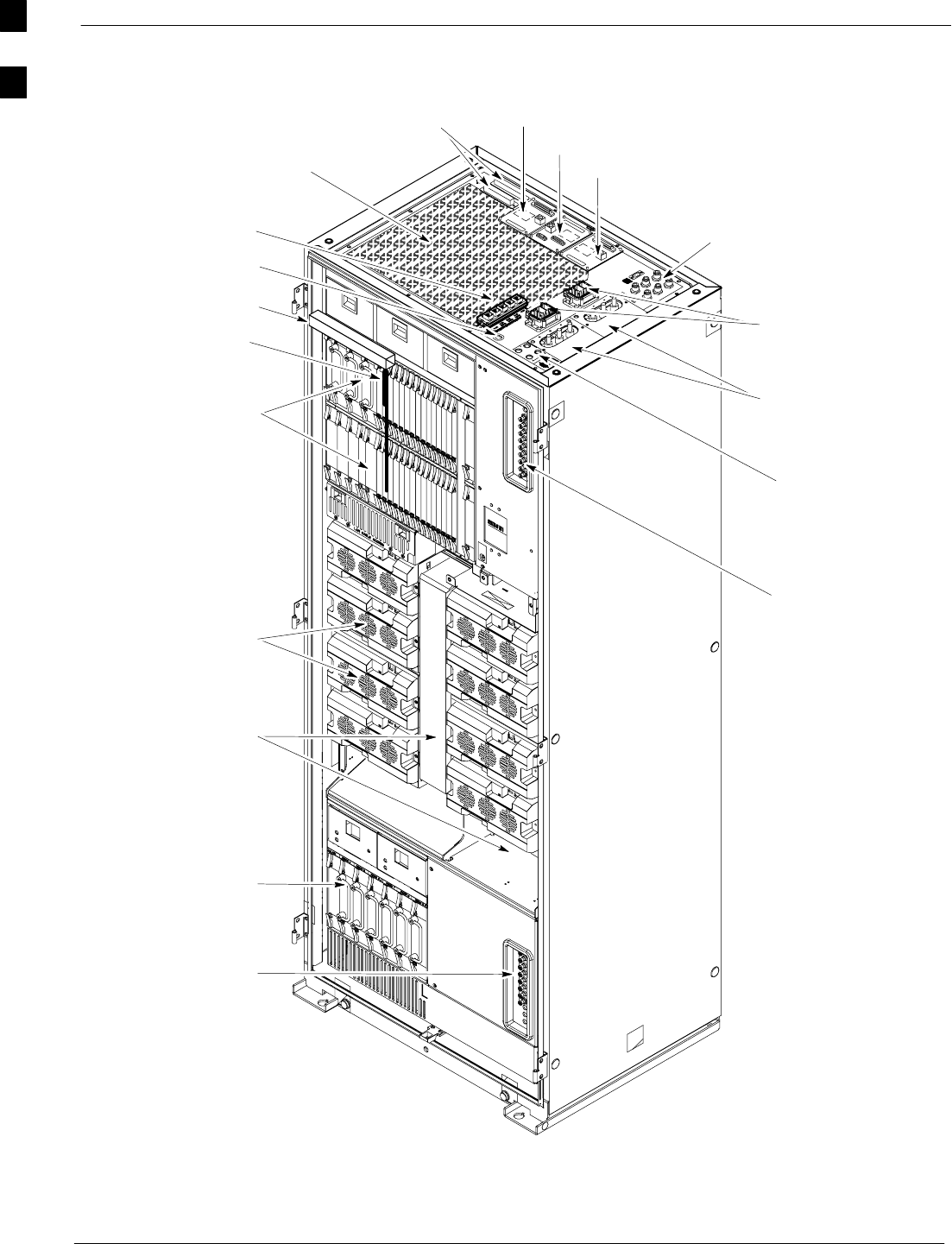
BTS Equipment Identification 68P09258A31–A
Oct 2003
1X SCt 4812T BTS Optimization/ATP
1-20
Figure 1-5: –48 V SC 4812T BTS Expansion Frame (2100 mm)
FW00478
Expansion Port
to another BTS
For clarity, doors are not shown.
Power Input
Connection
TX Out (1 – 6)
Span I/O B
Span I/O A
Site I/O
Exhaust Region
C–CCP Cage
Combiner
Section
Power
Amplifier
Cage
Power
Conversion
Shelf
Breakers
Alarms
BPR to GLI
Interconnect Panel
FE Cable Tray
FE Cables
(BPR to GLI)
Breakers
F F LAN OUT
A B
F F LAN IN
GPS IN
1

BTS Equipment Identification68P09258A31–A
Oct 2003 1X SCt 4812T BTS Optimization/ATP 1-21
BTS Frame Description
The BTS is the interface between the span lines to/from the Cellsite Base
Station Controller (CBSC) and the site antennas. This frame is described
in three sections:
SThe top interconnect plate where all connections are made.
SThe upper portion of the frame which houses circuit breakers, cooling
fans, and the C–CCP shelf.
SThe lower portion of the frame which houses the PA fans, PAs, and
TX filter/combiners.
SThe –48 V version of the BTS also has a section below the PAs
containing a power conversion shelf that supplies power to the PAs.
Use the illustrations that follow to visually identify the major
components, that make up the Motorola SC 4812T BTS frame.
Top Interconnect Plate (see Figure 1-6 or Figure 1-7)
All cabling to and from the BTS equipment frames is via the
interconnect panel on the top of each frame. Connections made here
include:
SSpan lines
SRX antennas
STX antenna
SAlarm connections
SPower input
SLAN connections
SGPS input or Remote Global Positioning System (RGPS) on the Site
I/O Board
SRemote Global Positioning System Distribution (RGD)
SLORAN–C Low Frequency Receiver (LFR) input
SExpansion frame connection
SGround connections
SRJ–45 Pass–through Connectors
C–CCP Shelf (see Figure 1-10)
SC–CCP backplane and cage
SPower supply modules
SCDMA clock distribution (CCD) boards
SCSM and HSO/LFR boards
SAlarm Monitoring and Reporting (AMR) boards
SGLI cards (may be GLI2 or GLI3)
SMPC/EMPC boards
– MPC – starter frame only
– EMPC – expansion frames
SSwitch card
SMCC boards (may be MCC8E, MCC24, or MCC–1X)
SBBX boards (may be BBX2 or BBX–1X)
SCIO boards
1

BTS Equipment Identification 68P09258A31–A
Oct 2003
1X SCt 4812T BTS Optimization/ATP
1-22
PA Shelves (see Figure 1-11 or Figure 1-12)
SPA cages
SPA trunking backplanes
SSingle Tone Linear Power Amplifier (STLPA, or more commonly
referred to as “PA”) modules
SPA fan modules
SPA Combiner Cage (+27 V BTS)
STX filter combiners or bandpass filters
–48 V Power Conversion Shelf (see Figure 1-15)
SPower conversion backplane and shelf
SPower conversion boards
SPower conversion alarm card
SFan modules
SPower distribution assembly
SAir plenum
1
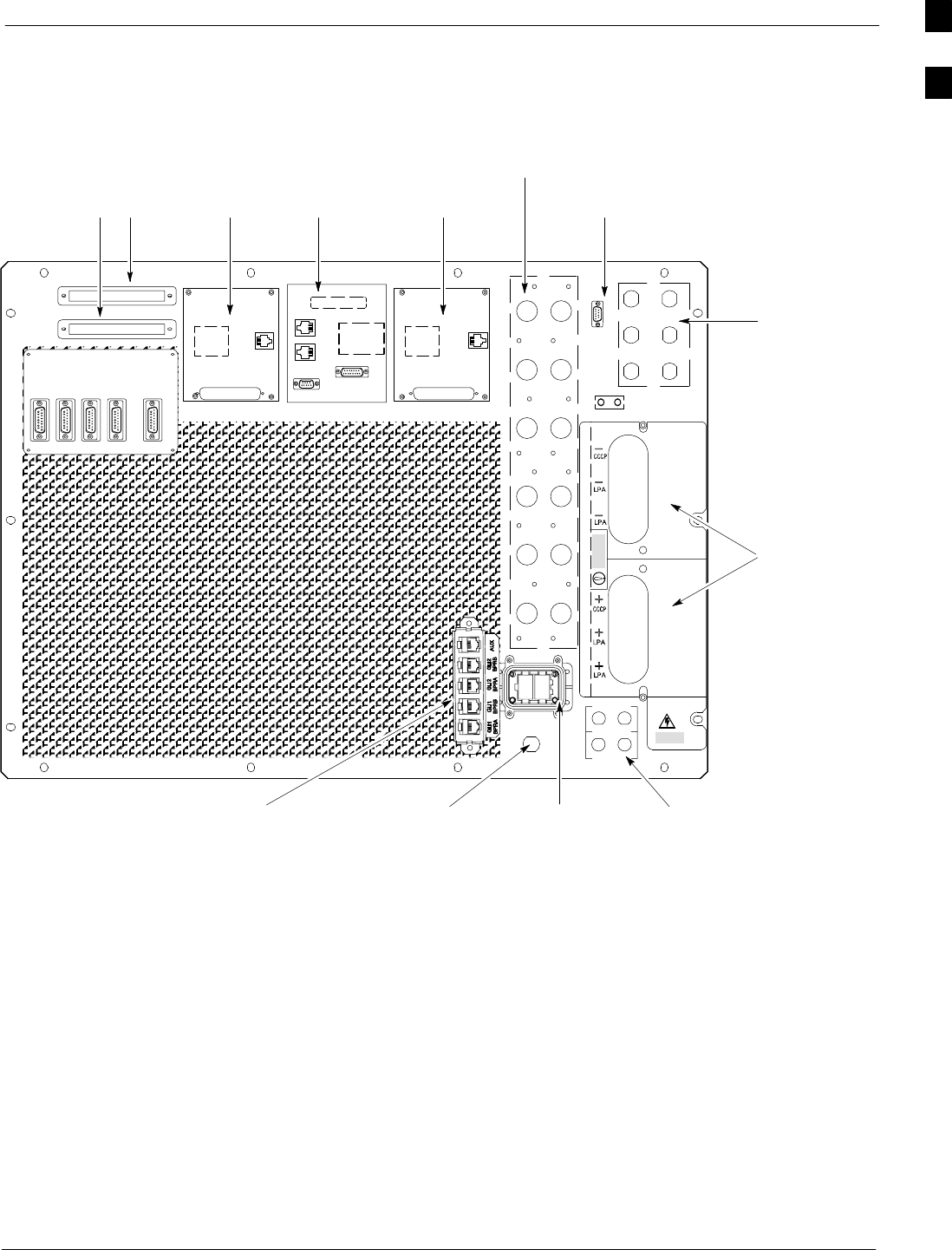
BTS Equipment Identification68P09258A31–A
Oct 2003 1X SCt 4812T BTS Optimization/ATP 1-23
I/O Interconnect Plates
Figure 1-6: +27 V SC 4812T Starter Frame I/O Interconnect Plate
OUT
LAN
IN
LAN
GPS
AB
AB
SPAN I/O A SITE I/O SPAN I/O B
LFR/
ALARM B 4
3A
2A
1A
6A
5A
4A
3B
2B
1B
6B
5B
4B
GND
5
6
1
2
3
TX OUT
FRONT
REAR
SPAN I/O ASPAN I/O B
CAUTION
LIVE TERMINALSLIVE TERMINALS +27 VDC
HSO
RX
ALARM A
EXP I/O
RGD
ti-CDMA-WP-00114-v01-ildoc-ftw
LOW FREQUENCY
RECEIVER / HSO
SPAN I/O
RF EXPANSION PORT
(TO ANOTHER BTS)
TRANSMIT
ANTENNA
CONNECTORS
POWER INPUT
RECEIVE ANTENNA
CONNECTORS
SITE I/OSPAN I/O
GPS IN LAN CONNECTIONS
ALARM
CONNECTORS
BPR–TO–GLI
INTERCONNECT PANEL
(OPTIONAL)
1
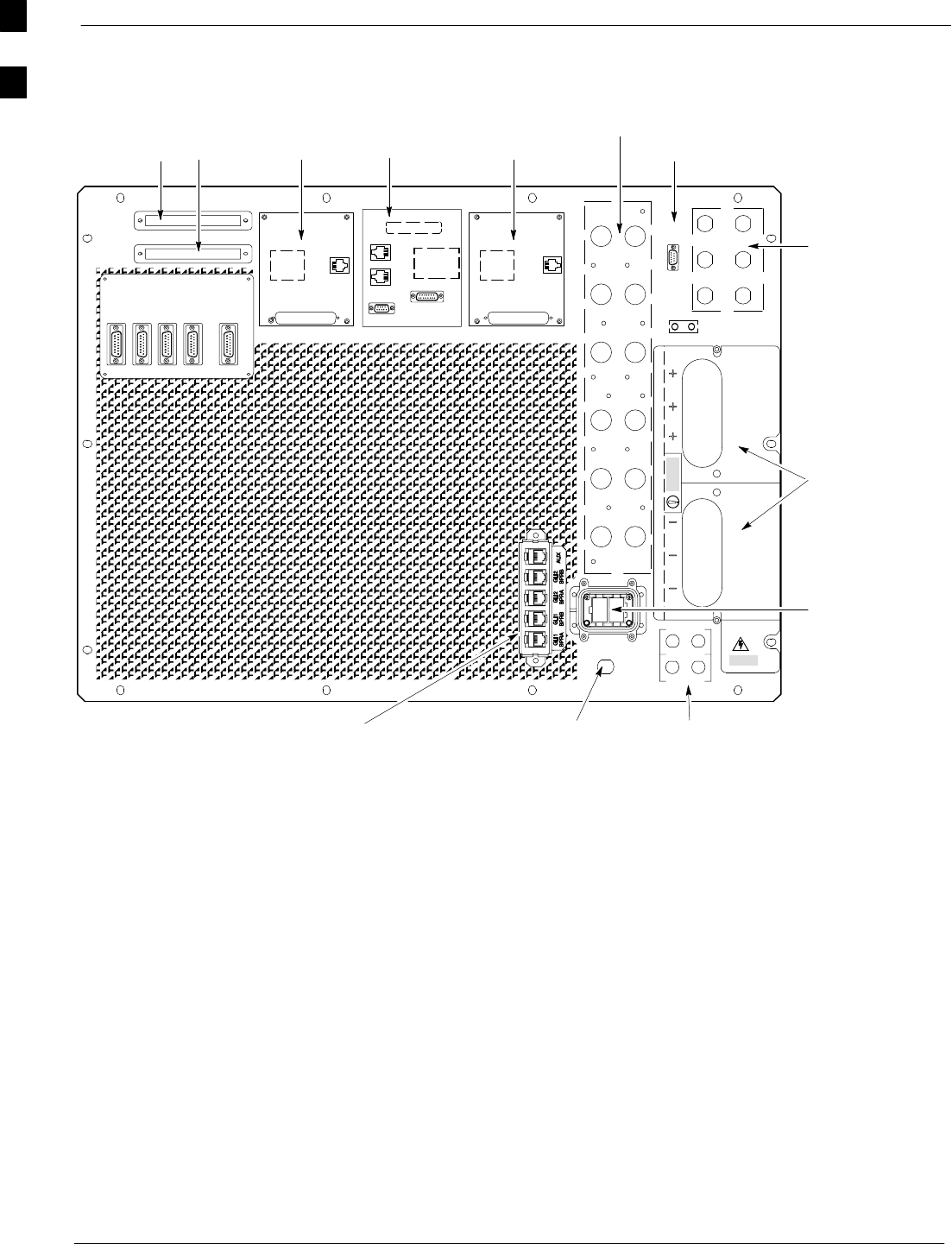
BTS Equipment Identification 68P09258A31–A
Oct 2003
1X SCt 4812T BTS Optimization/ATP
1-24
Figure 1-7: –48 V SC 4812T Starter Frame I/O Interconnect Plate
OUT
LAN
IN
LAN
GPS
AB
AB
SPAN I/O A SITE I/O SPAN I/O B
LFR
ALARM B 4
3A
2A
1A
6A
5A
4A
3B
2B
1B
6B
5B
4B
GND
5
6
1
2
3
TX OUT
SPAN I/O ASPAN I/O B
CAUTION
LIVE TERMINALSLIVE TERMINALS WIRED FOR –48VDC
HSO/
RX
ALARM A
EXP I/O
RGD
HSO/LFR
FRONT
REAR
SPAN I/O
RF EXPANSION
PORT (TO
ANOTHER BTS)
TRANSMIT
ANTENNA
CONNECTORS
POWER INPUT
RECEIVE ANTENNA
CONNECTORS
SITE I/OSPAN I/O
SITE I/O
ALARM
CONNECTORS
RX
3
2
1
1
2
3
AB
LAN
CONNECTIONS
GPS IN
ti-CDMA-WP-00099-v01-ildoc-ftw
BPR–TO–GLI
INTERCONNECT PANEL
(OPTIONAL)
1
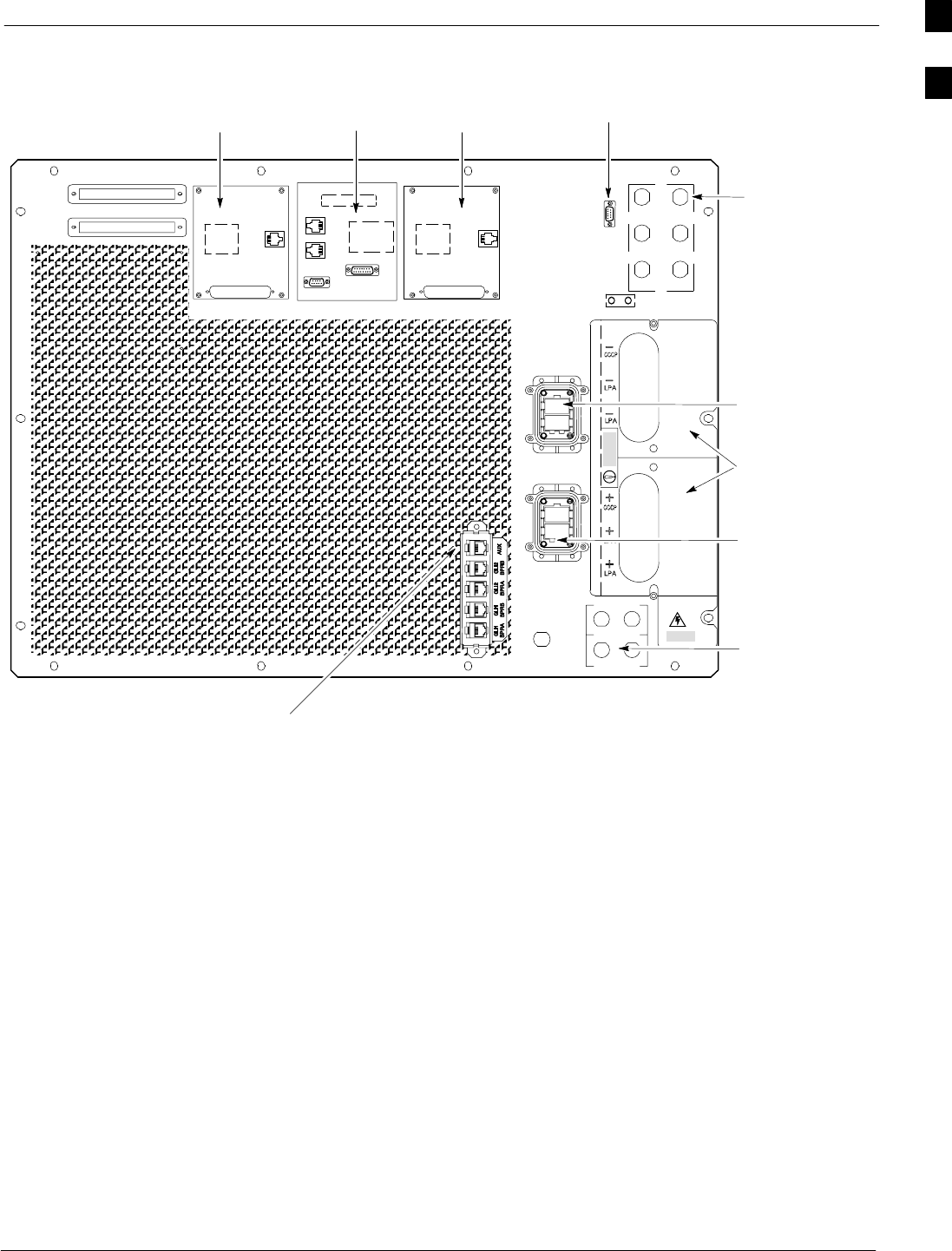
BTS Equipment Identification68P09258A31–A
Oct 2003 1X SCt 4812T BTS Optimization/ATP 1-25
Figure 1-8: +27 V SC 4812T Expansion Frame I/O Interconnect Plate
OUT
LAN
IN
LAN
AB
AB
GPS
EXP IN
SPAN I/O A SITE I/O SPAN I/O B
LFR/
ALARM B
4
GND
5
6
1
2
3
TX OUT
FRONT
REAR
SPAN I/O ASPAN I/O B
AB
CAUTION
LIVE TERMINALSLIVE TERMINALS +27 VDC
HSO
EXP OUT
AB
ALARM A
EXP IN
HOUSING
TRANSMIT
ANTENNA
CONNECTORS
EXP OUT
HOUSING (ADDED
ONLY WHEN
USING SECOND
EXPANSION
FRAME)
SITE I/O LFR/HSO
RGD
POWER
INPUT
LAN
SPAN I/O SPAN I/O
ti-CDMA-WP-00102-v01-ildoc-ftw
RJ–45 PASS–THROUGH
CONNECTORS
1
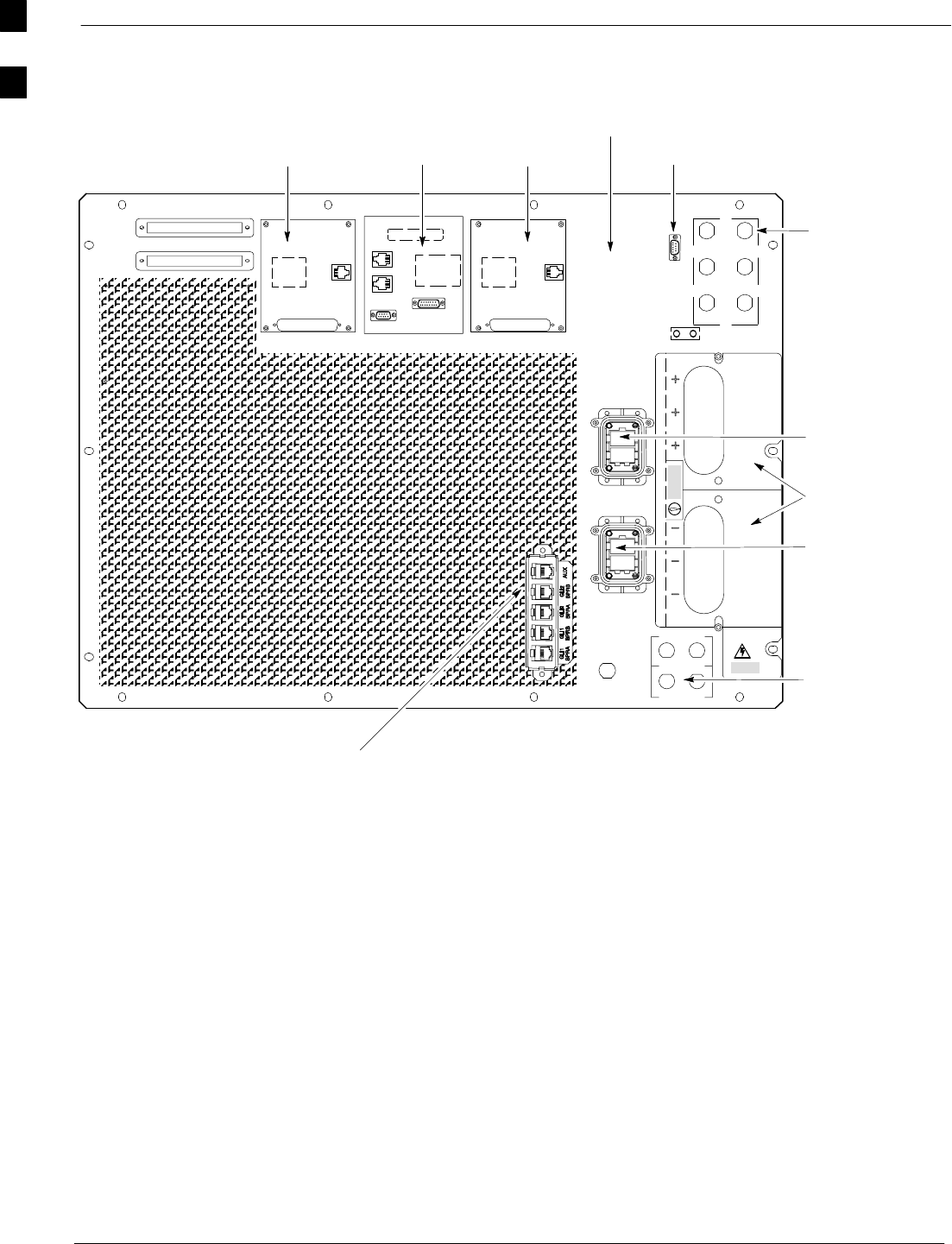
BTS Equipment Identification 68P09258A31–A
Oct 2003
1X SCt 4812T BTS Optimization/ATP
1-26
Figure 1-9: –48 V SC 4812T Expansion Frame I/O Interconnect Plate
OUT
LAN
IN
LAN
AB
AB
GPS
EXP IN
SPAN I/O A SITE I/O SPAN I/O B
LFR
ALARM B
4
GND
5
6
1
2
3
TX OUT
FRONT
REAR
SPAN I/O ASPAN I/O B
AB
CAUTION
LIVE TERMINALS
HSO/
EXP OUT
AB
ALARM A
EXP IN
HOUSING
TRANSMIT
ANTENNA
CONNECTORS
EXP OUT
HOUSING (ADDED
ONLY WHEN
USING SECOND
EXPANSION
FRAME)
SITE I/O
RGD
POWER
INPUT
LAN
SPAN I/O SPAN I/O
1
2
3
1
2
3
LIVE TERMINALS WIRED FOR –48 VDC
SITE I/O
HSO/LFR
RF FILTER PORTS NOT USED
IN EXPANSION FRAME
ti-CDMA-WP-00100-v01-ildoc-ftw
RJ–45 PASS–THROUGH
CONNECTORS
1
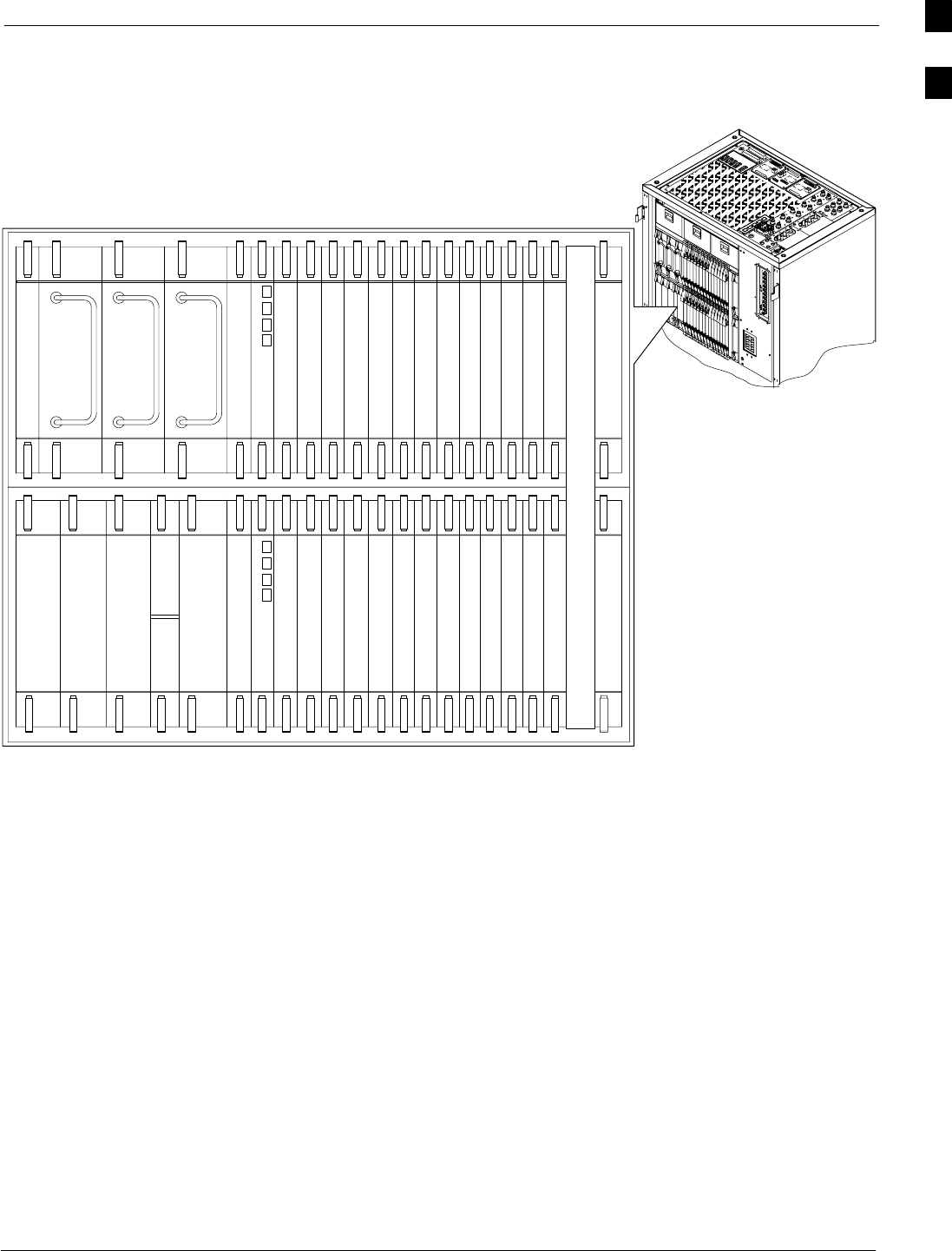
BTS Equipment Identification68P09258A31–A
Oct 2003 1X SCt 4812T BTS Optimization/ATP 1-27
Combined CDMA Channel Processor Shelf
Figure 1-10: SC 4812T Combined CDMA Channel Processor (C–CCP) Shelf
19 mm Filler Panel
PS–3
AMR–1
CSM–1
CSM–2
38 mm Filler Panel
AMR–2
GLI–1GLI–2
MCC–6
BBX–1
BBX–2
BBX–3
BBX–4
BBX–5
BBX–6
BBX–RSwitch
MPC/EMPC–1MPC/EMPC–2
CIO
BBX–7
BBX–8
BBX–9
BBX–10
BBX–11
BBX–12
MCC–5
MCC–4
MCC–3
MCC–2
MCC–1
MCC–12
MCC–11
MCC–10
MCC–9
MCC–8
MCC–7
PS–2
PS–1
CCD–2 CCD–1
NOTE: MCCs may be
MCC8Es, MCC24s, or
MCC–1Xs. BBXs may
be BBX2s or BBX–1Xs.
GLIs may be GLI2s or
GLI3s.
HSO/LFR
FW00295
REF
BBX–1X and BBX2 Interchangeability
In a BSS operating with R16.0 software, BBX–1X cards can be used as
direct replacements for BBX2 cards; however, different types of BBXs
should not be mixed on the same carrier. Therefore, if a BBX2 card is
replaced with a BBX–1X, all remaining BBX2 cards for the carrier
supported by the replaced card must also be replaced with BBX–1X
cards.
1
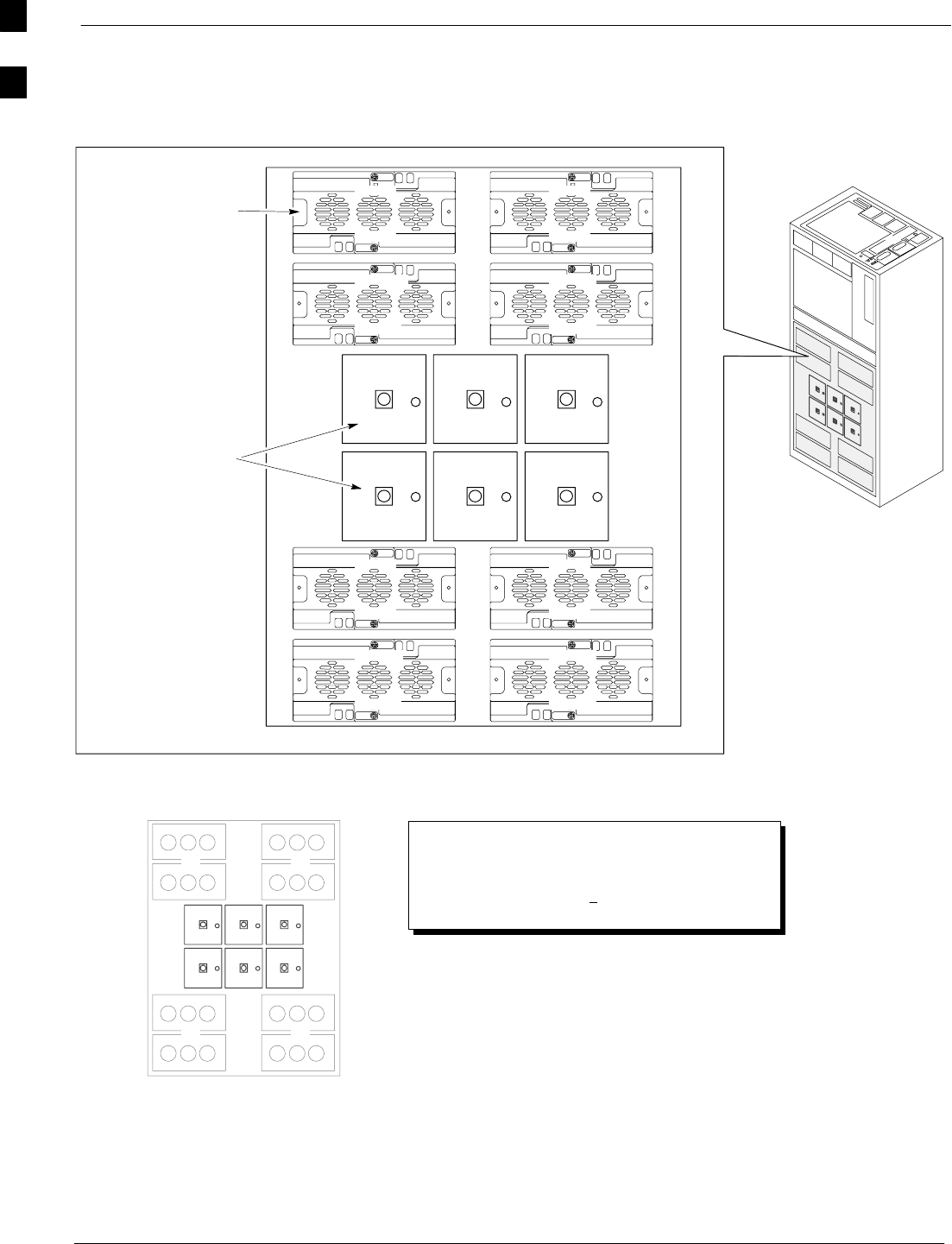
BTS Equipment Identification 68P09258A31–A
Oct 2003
1X SCt 4812T BTS Optimization/ATP
1-28
Linear Power Amplifier Shelf
Figure 1-11: +27 V SC 4812T PA Configuration – 4 Carrier with 2:1 Combiners
PA1A
PA1B
PA1C
PA1D
PA3A
PA3B
PA3C
PA3D
PA2A
PA2B
PA2C
PA2D
PA4A
PA4B
PA4C
PA4D
FAN
MODULE
(TYPICAL)
FILTERS /
COMBINERS
(2 TO 1 COMBINER
SHOWN)
Note
No adjacent carriers may exist within the same TX filter
combiner. “Adjacent” is defined as fc1 and fc2 being
1.25 MHz apart (center–to–center). “Non–adjacent” is
defined as fc1 and fc2 being >2.50 MHz apart
(center–to–center).
123
456
4–CARRIER CONFIGURATION
CARRIER
1
3
CARRIER
2
4
123
456
FW00296
1
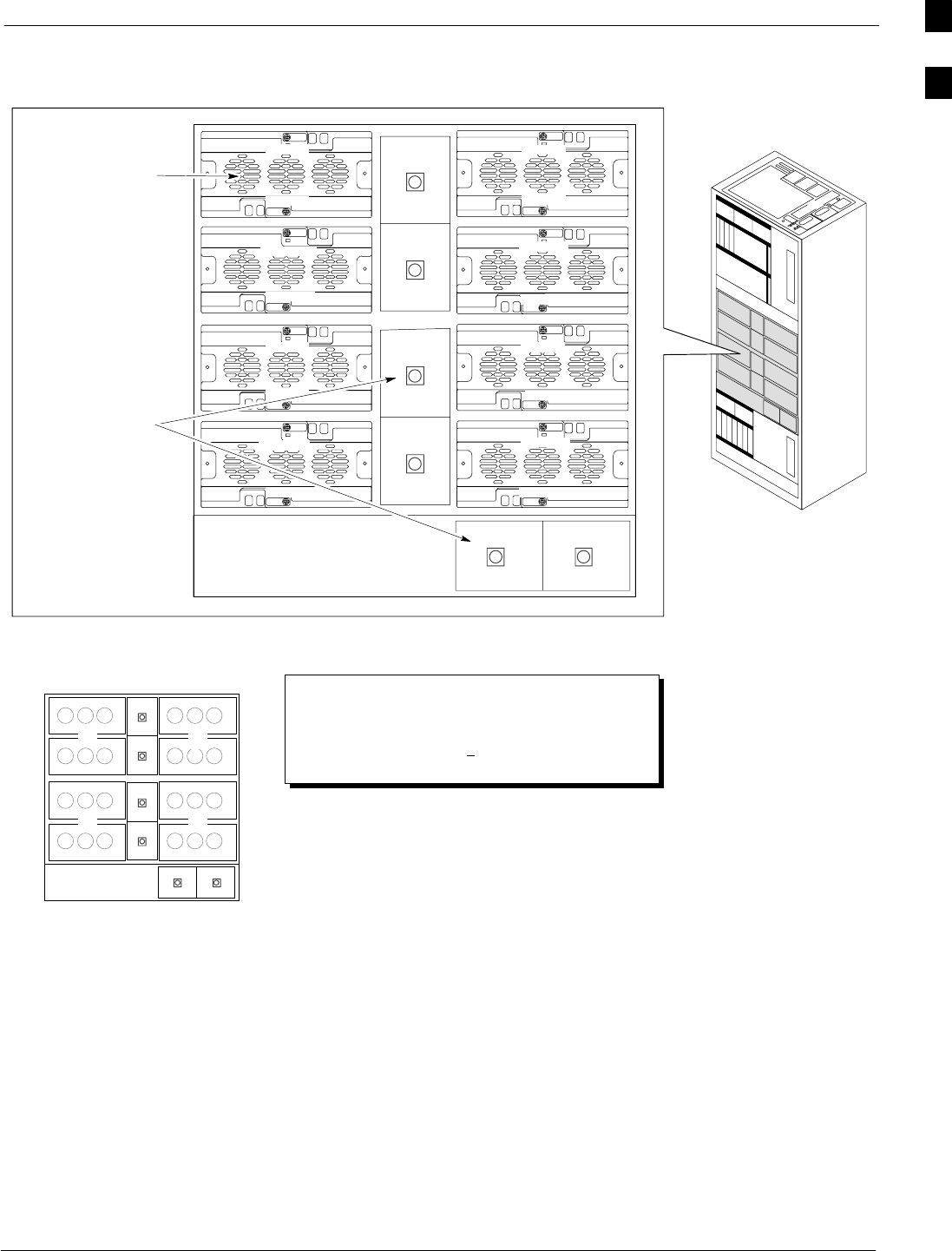
BTS Equipment Identification68P09258A31–A
Oct 2003 1X SCt 4812T BTS Optimization/ATP 1-29
Figure 1-12: –48 V SC 4812T PA Configuration – 4 Carrier, 3–Sector with 2:1 Combiners
PA1A
PA1B
Note
No adjacent carriers may exist within the same TX filter
combiner. “Adjacent” is defined as fc1 and fc2 being
1.25 MHz apart (center–to–center). “Non–adjacent” is
defined as fc1 and fc2 being >2.50 MHz apart
(center–to–center).
4–CARRIER CONFIGURATION
CARRIER CARRIER
PA1C
PA1D
PA3C
PA3D
PA2A
PA2B
PA2C
PA2D
PA4C
PA4D
FW00481
1
2
3
4
5
6
12
3 4
1
2
3
4
5
6
PA3A
PA3B
PA4A
PA4B
FAN
MODULE
(TYPICAL)
FILTERS /
COMBINERS
(2 TO 1 COMBINER
SHOWN)
–48 Volt
SC 4812T
1
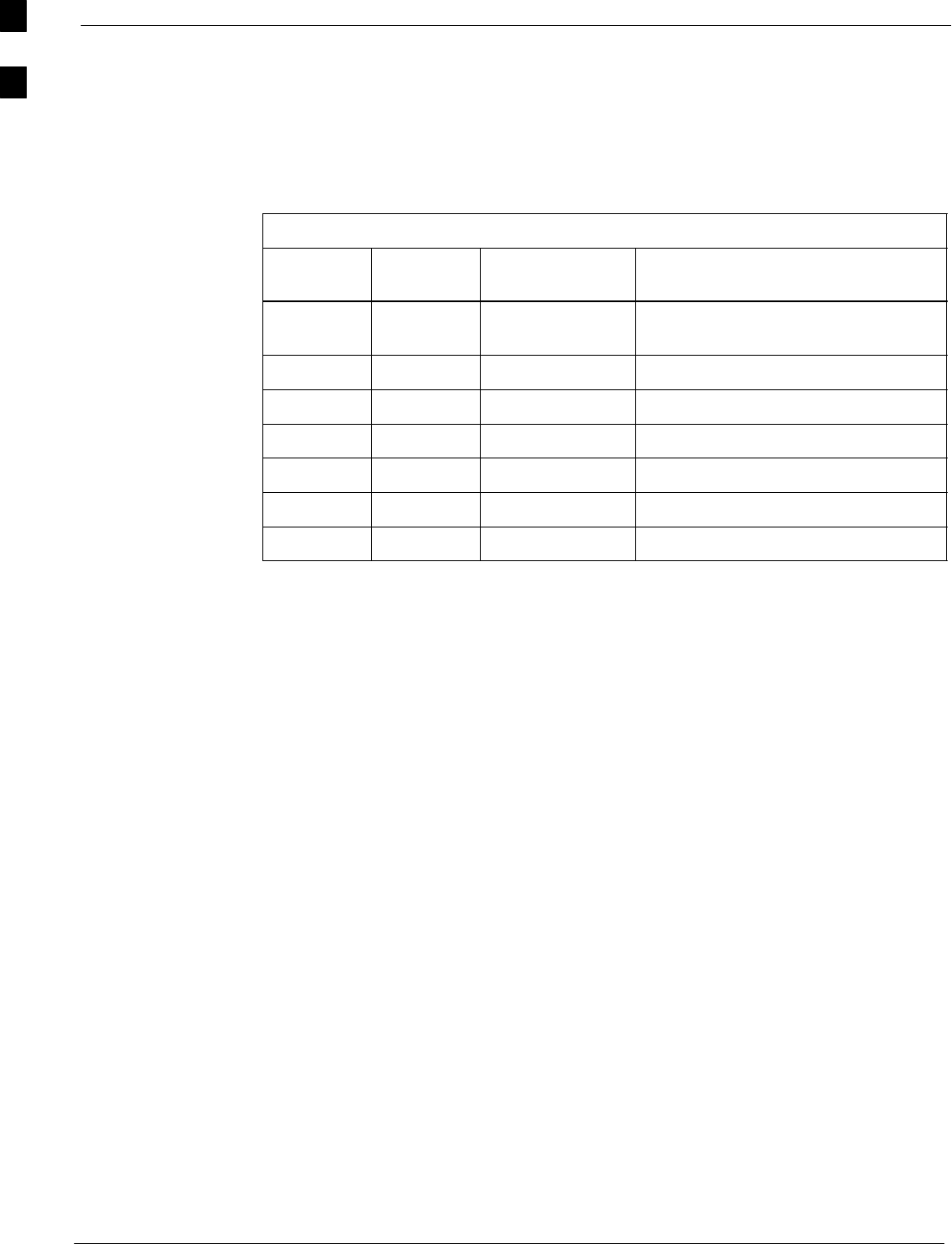
BTS Sector Configuration 68P09258A31–A
Oct 2003
1X SCt 4812T BTS Optimization/ATP
1-30
BTS Sector Configuration
There are a number of ways to configure the BTS frame. Table 1-5
outlines the basic requirements. When carrier capacity is greater than
two, a 2:1 or 4:1 cavity combiner must be used. For one or two carriers,
bandpass filters or cavity combiners may be used, depending on
sectorization and channel sequencing.
Table 1-5: BTS Sector Configuration
Number
of carriers
Number
of sectors
Channel
spacing
Filter requirements
13 or 6 N/A Bandpass Filter, Cavity Combiner
(2:1 or 4:1)
2 6 Non–adjacent Cavity Combiner (2:1 Only)
2 6 Adjacent Not supported in single frame
2 3 Non–adjacent Cavity Combiner (2:1 or 4:1)
2 3 Adjacent Bandpass Filter
3,4 3 Non–adjacent Cavity Combiner (2:1 or 4:1)
3,4 3 Adjacent Cavity Combiner (2:1 Only)
1
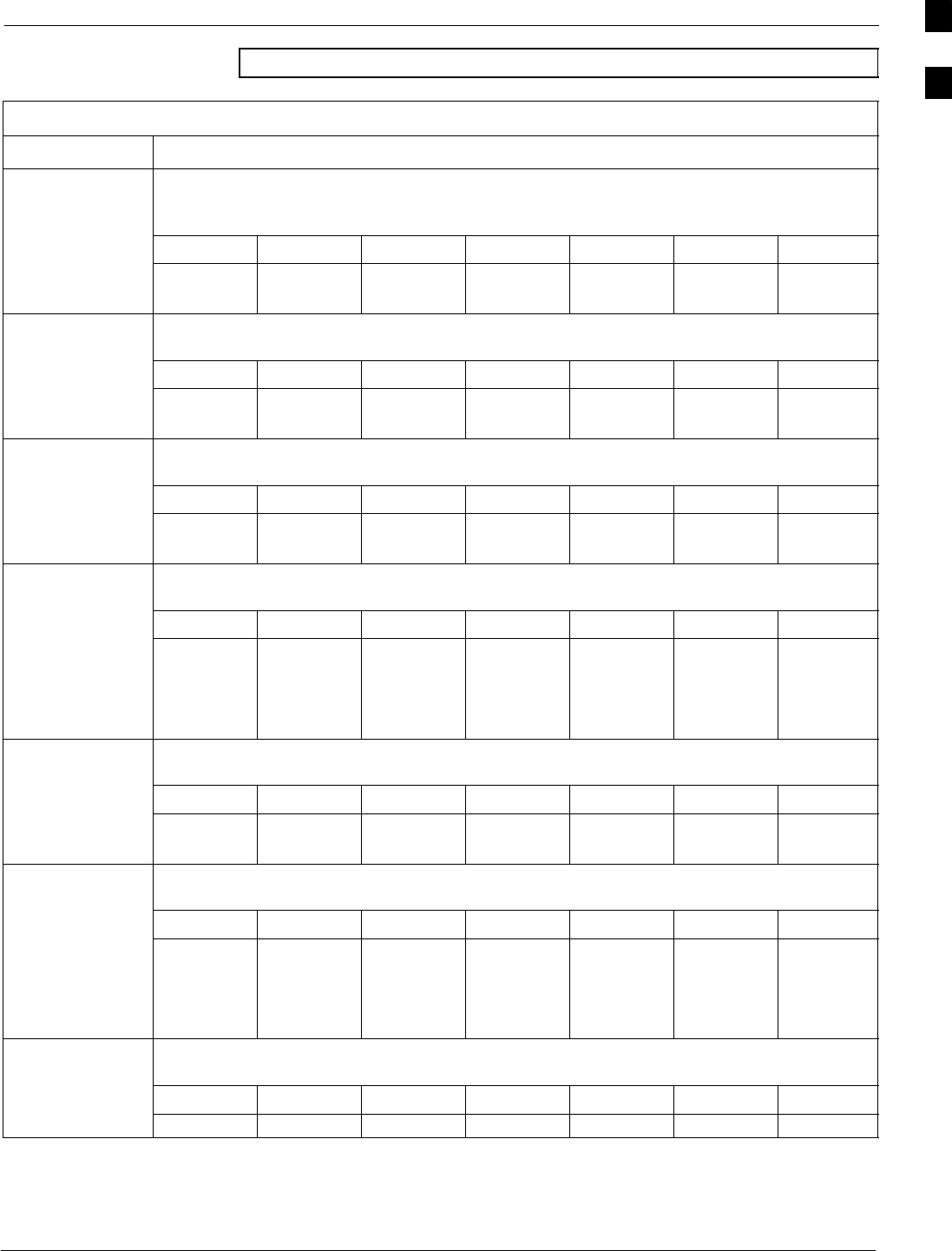
BTS Sector Configuration68P09258A31–A
Oct 2003 1X SCt 4812T BTS Optimization/ATP 1-31
NOTE In Table 1-6, BBXs may be BBX2s or BBX–1Xs.
Table 1-6: Sector Configurations
Config Ref. No. Description
1
3–Sector/2–ADJACENT Carriers – The configuration below maps TX with optional 2:1 cavity
combiners for 3 sectors/2 carriers for adjacent channels. Note that 2:1 cavity combiners are used (6
total).
1TX1 TX2 TX3 TX4 TX5 TX6 Carrier#
BBX–1 BBX–2 BBX–3 N/A N/A N/A 1
N/A N/A N/A BBX–7 BBX–8 BBX–9 2
6–Sector/2–NON–ADJACENT Carriers – The configuration below maps TX with 2:1 cavity
combiners for 6 sectors/2 carriers for non–adjacent channels.
2TX1 TX2 TX3 TX4 TX5 TX6 Carrier#
BBX–1 BBX–2 BBX–3 BBX–4 BBX–5 BBX–6 1
BBX–7 BBX–8 BBX–9 BBX–10 BBX–11 BBX–12 2
3–Sector/2–NON–ADJACENT Carriers – The configuration below maps TX with 2:1 cavity
combiners for 3 sectors/2 carriers for non–adjacent channels.
3TX1 TX2 TX3 TX4 TX5 TX6 Carrier#
BBX–1 BBX–2 BBX–3 N/A N/A N/A 1
BBX–7 BBX–8 BBX–9 N/A N/A N/A 2
3–Sector/4–ADJACENT Carriers – The configuration below maps TX with 2:1 cavity combiners
for 3 sector/4 carriers for adjacent channels.
TX1 TX2 TX3 TX4 TX5 TX6 Carrier#
4BBX–1 BBX–2 BBX–3 N/A N/A N/A 1
N/A N/A N/A BBX–7 BBX–8 BBX–9 2
BBX–4 BBX–5 BBX–6 N/A N/A N/A 3
N/A N/A N/A BBX–10 BBX–11 BBX–12 4
3–Sector / 2–ADJACENT Carriers – The configuration below maps TX with bandpass filters for
3 sectors/2 carriers for adjacent channels.
5TX1 TX2 TX3 TX4 TX5 TX6 Carrier#
BBX–1 BBX–2 BBX–3 N/A N/A N/A 1
N/A N/A N/A BBX–7 BBX–8 BBX–9 2
3–Sector/3 or 4–NON–ADJACENT Carriers – The configuration below maps TX with 4:1
cavity combiners for 3 sectors/3 or 4 carriers for non–adjacent channels.
TX1 TX2 TX3 TX4 TX5 TX6 Carrier#
6BBX–1 BBX–2 BBX–3 N/A N/A N/A 1
BBX–7 BBX–8 BBX–9 N/A N/A N/A 2
BBX–4 BBX–5 BBX–6 N/A N/A N/A 3
BBX–10 BBX–11 BBX–12 N/A N/A N/A 4
7
6–Sector/1–Carrier – The configuration below maps TX with either bandpass filters or 2:1 cavity
combiners for 6 sector/1 carrier.
7
TX1 TX2 TX3 TX4 TX5 TX6 Carrier#
BBX–1 BBX–2 BBX–3 BBX–4 BBX–5 BBX–6 1
1
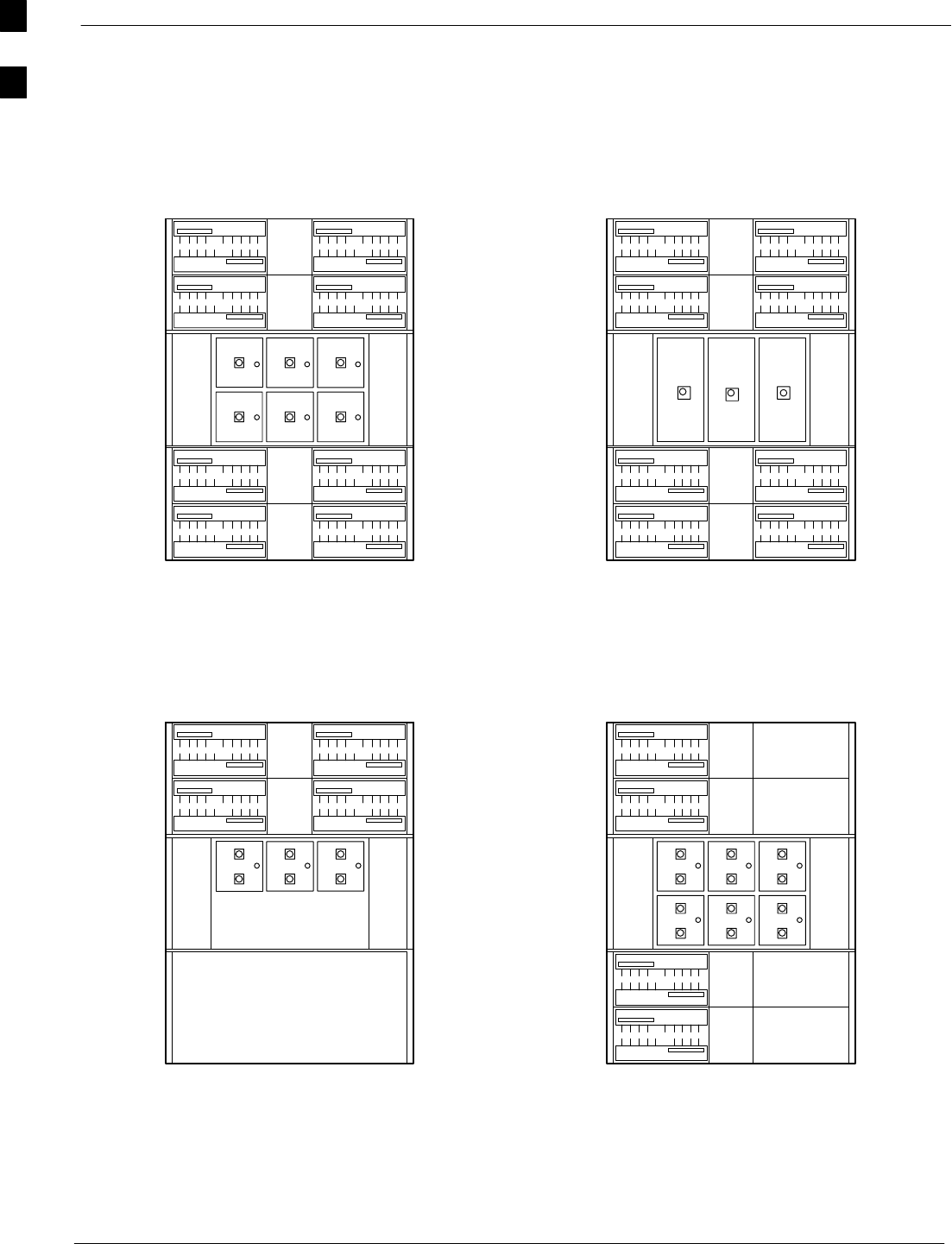
BTS Sector Configuration 68P09258A31–A
Oct 2003
1X SCt 4812T BTS Optimization/ATP
1-32
Figure 1-13: +27 V SC4812T PA Configuration with Combiners/Filters
Numbering
456
LPA 1A
LPA 1B
LPA 1C
LPA 1D
LPA 3C
LPA 3A
LPA 3B
LPA 3D
LPA 2D
LPA 2C
LPA 2B
LPA 2A
LPA 4B
LPA 4A
LPA 4C
LPA 4D
Sector
3 Sector
Sector
3 Sector
(6 Sector)
Numbering
2 to 1 Combiner
3 Sector or 6 Sector
C1, S1–3
(C1, S1–3)
C2, S1–3
(C2, S1–3)
C3, S1–3
(C1, S4–6)
C4, S1–3
(C2, S4–6)
(6 Sector)
123
456
LPA 1A
LPA 1B
LPA 1C
LPA 1D
LPA 3C
LPA 3A
LPA 3B
LPA 3D
LPA 2D
LPA 2C
LPA 2B
LPA 2A
LPA 4B
LPA 4A
LPA 4C
LPA 4D
Sector
Numbering
Sector
Numbering
4 to 1 Combiner
3 Sector
C1, S1–3 C2, S1–3
C3, S1–3 C4, S1–3
123
LPA 1A
LPA 1B
LPA 1C
LPA 1D LPA 2D
LPA 2C
LPA 2B
LPA 2A
Sector
3 Sector
Numbering Sector
3 Sector
Numbering
Dual Bandpass Filter
3 Sector Only
C1, S1–3 C2, S1–3
123
456
LPA 1A
LPA 1B
LPA 1C
LPA 1D
LPA 3C
LPA 3A
LPA 3B
LPA 3D
Sector
Numbering Dual Bandpass Filter
6 Sector
C1, S1–3
C1, S4–6
2 Carrier Maximum 1 Carrier Only
6 Sector
123
Note: See Table 1-6 Configuration
Reference Numbers 1, 2, 3, 4. Note: See Table 1-6 Configuration
Reference Number 6.
Note: See Table 1-6 Configuration
Reference Number 5.
Note: See Table 1-6 Configuration
Reference Number 7.
FW00297
1
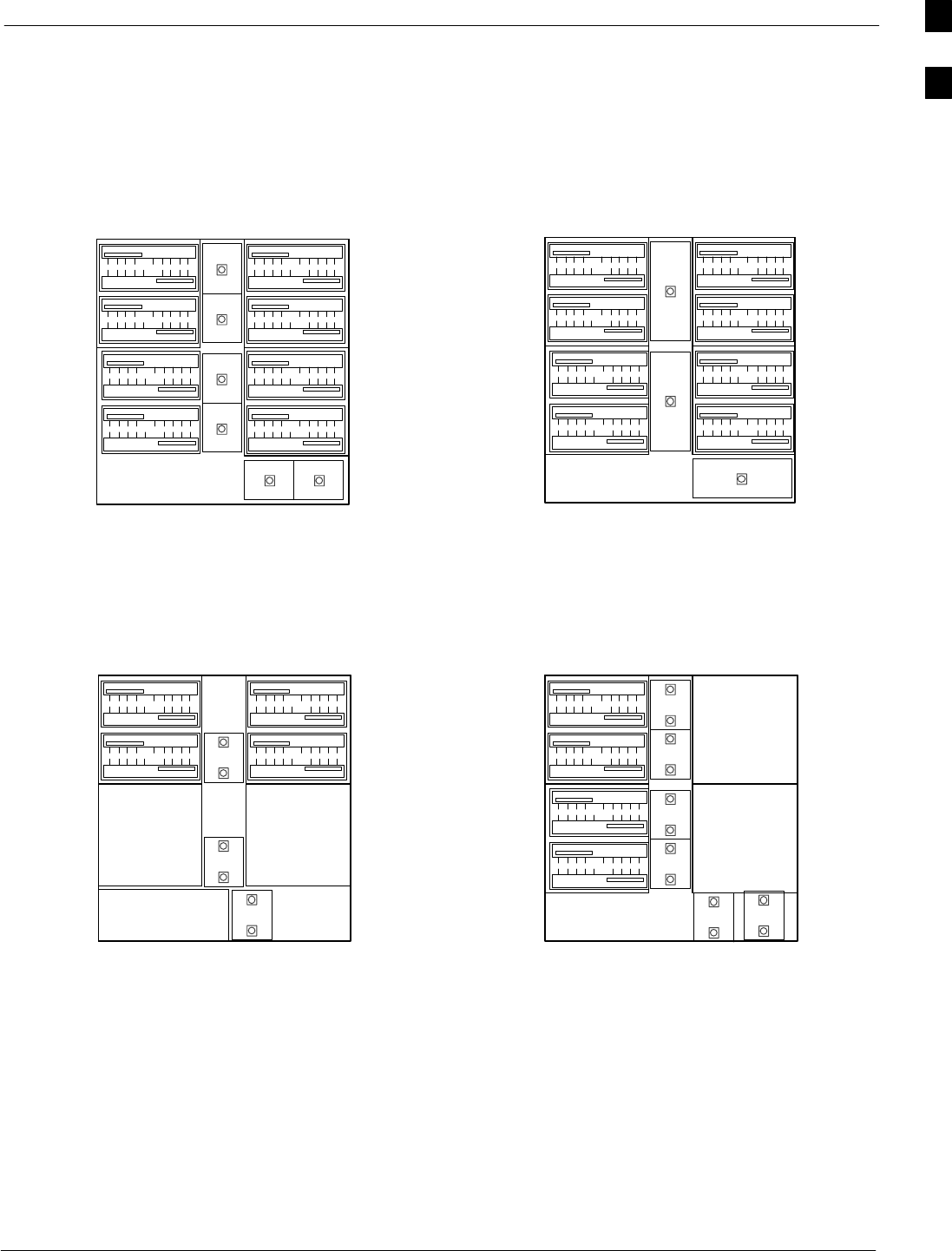
BTS Sector Configuration68P09258A31–A
Oct 2003 1X SCt 4812T BTS Optimization/ATP 1-33
Figure 1-14: –48 V SC4812T PA Configuration with Combiners/Filters
Note: See Table 1-6 Configuration
Reference Numbers 1, 2, 3, 4. Note: See Table 1-6 Configuration
Reference Number 6.
Note: See Table 1-6 Configuration
Reference Number 5.
Note: See Table 1-6 Configuration
Reference Number 7.
REF FW00482
4
1
5
2
36
Numbering
Sector
3 Sector
Sector
3 Sector
(6 Sector)
Numbering
2 to 1 Combiner
3 Sector or 6 Sector
C1, S1–3
(C1, S1–3)
C2, S1–3
(C2, S1–3)
C3, S1–3
(C1, S4–6)
C4, S1–3
(C2, S4–6)
(6 Sector)
LPA 1A
LPA 1B
LPA 1C
LPA 1D
LPA 3C
LPA 3A
LPA 3B
LPA 3D
LPA 2D
LPA 2C
LPA 2B
LPA 2A
LPA 4B
LPA 4A
LPA 4C
LPA 4D
Sector
Numbering
Sector
Numbering
4 to 1 Combiner
3 Sector
C1, S1–3 C2, S1–3
C3, S1–3 C4, S1–3
LPA 1A
LPA 1B 1
3
LPA 1C
LPA 1D
LPA 3C
LPA 3A
LPA 3B
LPA 3D
LPA 2D
LPA 2C
LPA 2B
LPA 2A
LPA 4B
LPA 4A
LPA 4C
LPA 4D
2
LPA 1A
LPA 1B
LPA 1C
LPA 1D LPA 2D
LPA 2C
LPA 2B
LPA 2A
4
5
Sector
3 Sector
Numbering
Sector
3 Sector
Numbering
Dual Bandpass Filter
3 Sector Only
C1, S1–3 C2, S1–3
2 Carrier Maximum
2
1
3
6
1
5
2
4
LPA 1A
LPA 1B
LPA 1C
LPA 1D
LPA 3C
LPA 3A
LPA 3B
LPA 3D
Sector
Numbering
Dual Bandpass Filter
6 Sector
C1, S1–3
C1, S4–6
1 Carrier Only
6 Sector
3 Sector
3 Sector
36
1
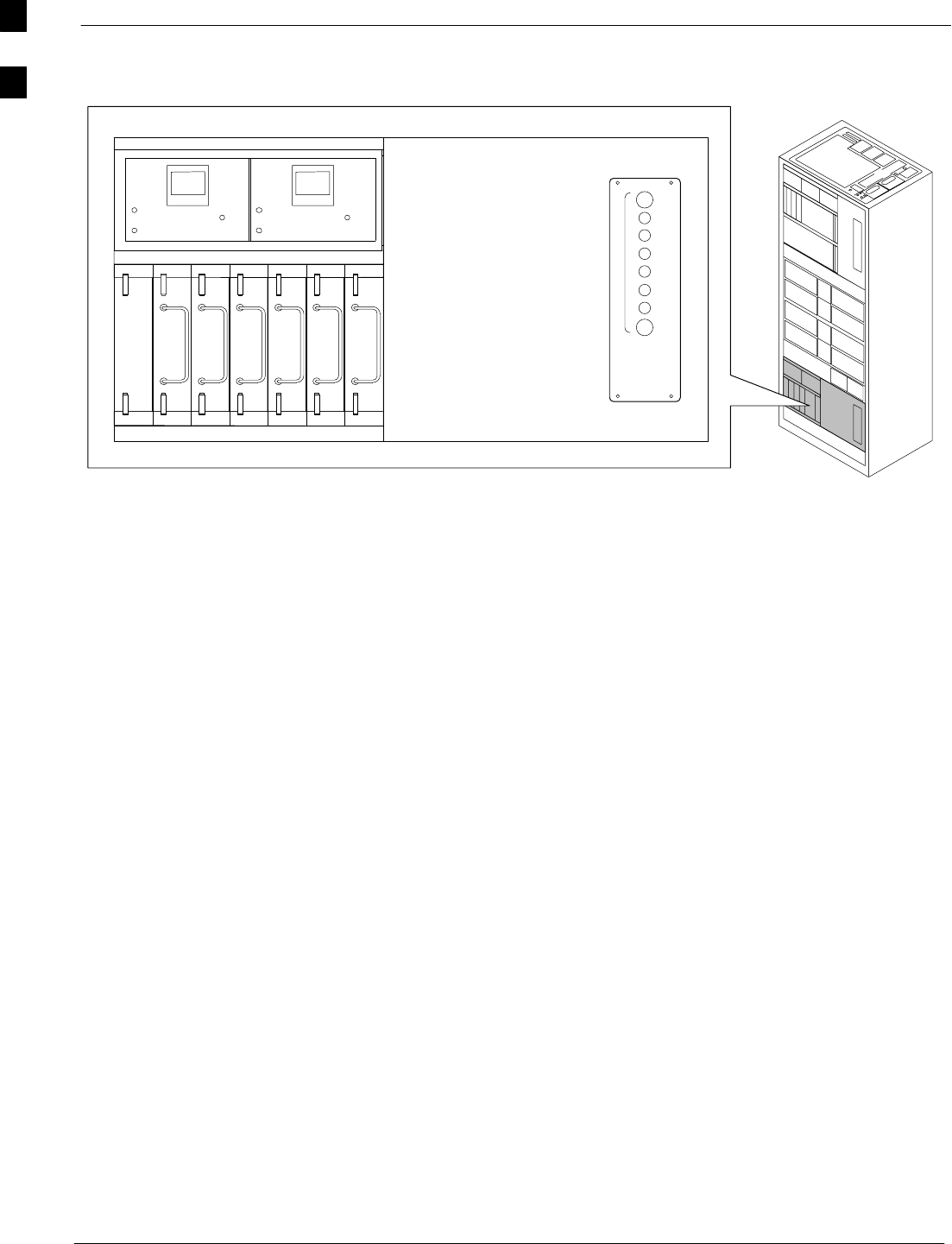
BTS Sector Configuration 68P09258A31–A
Oct 2003
1X SCt 4812T BTS Optimization/ATP
1-34
Figure 1-15: –48 V BTS Power Conversion Shelf
FW00501
PS–6
AMR
PS–5
PS–4
PS–9
PS–8
PS–7
1C
1A
2A
2C
3C
3A
4A
4C
L
P
A
1D
1B
2B
2D
3D
3B
4B
4D
30
30
30
30
30
30
30
30
FAN
MODULE
PWR/ALM
REAR
FRONT
FAN
MODULE
PWR/ALM
REAR
FRONT
1
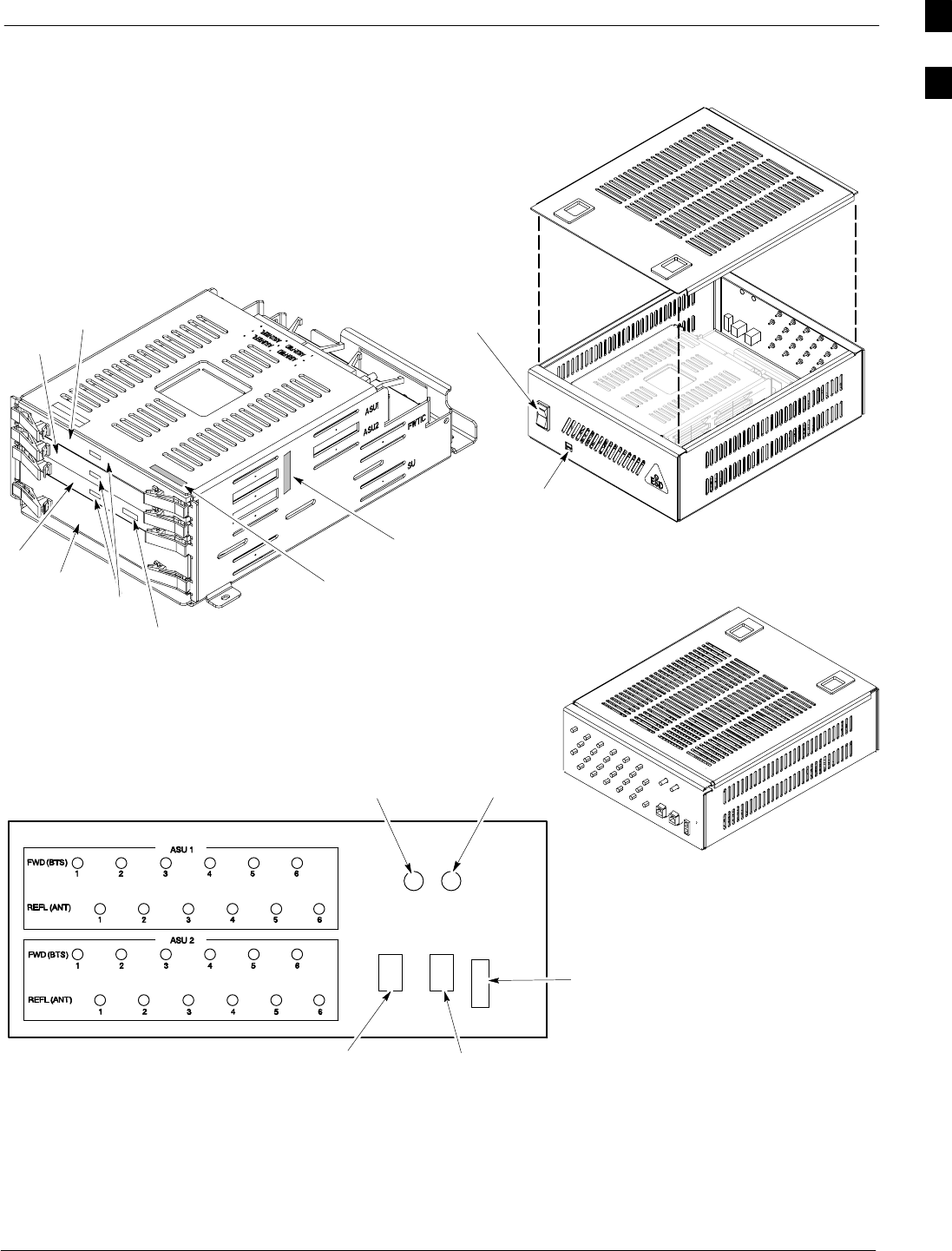
BTS Sector Configuration68P09258A31–A
Oct 2003 1X SCt 4812T BTS Optimization/ATP 1-35
Figure 1-16: CDMA (COBRA) RFDS Layout
AMR–B
(RS–485 SERIAL)
AMR–A
(RS–485 SERIAL)
Cobra RFDS external housing
(Shown With Cover off)
POWER SUPPLY
ON/OFF ROCKER
SWITCH
MMI PORT AND
PWR/ALARM LED
Cobra RFDS Field Replaceable Unit (FRU)
(shown removed from external housing)
CHASSIS GND
POWER
CONNECTOR
Cobra RFDS RF connector
panel detail
(shown from rear)
ELECTRICAL GND
FRONT VIEW
CASU 1
CASU 2
FWTIC
SUA
ESN LABEL
(FOR SC XXXX SERIES BTS)
MMI
LEDS
ESN LABEL
(FOR SC 6XX SERIES BTS)
FW00138
1

BTS Sector Configuration 68P09258A31–A
Oct 2003
1X SCt 4812T BTS Optimization/ATP
1-36
Notes
1

Oct 2003 1X SCt 4812T BTS Optimization/ATP 2-1
Chapter 2
Preliminary Operations
2

Preliminary Operations: Overview 68P09258A31–A
Oct 2003
1X SCt 4812T BTS Optimization/ATP
2-2
Preliminary Operations: Overview
Introduction
This section first verifies proper frame equipage. This includes verifying
module placement, jumper, and dual in–line package (DIP) switch
settings against the site-specific documentation supplied for each BTS
application. Next, pre-power up and initial power-up procedures are
presented.
Cell Site Types
Sites are configured as Omni, 3–sectored with a maximum of 4 carriers,
and 6–sectored with a maximum of 2 carriers. Each type has unique
characteristics and must be optimized accordingly. For more information
on the differences in site types, please refer to the BTS/Modem Frame
Hardware Installation manual.
CDF/NECF
The Configuration Data File (CDF) or Network Element Configuration
File (NECF) contains site type and equipage data information and passes
it directly to the LMF during optimization. The number of modem
frames, C–CCP shelves, BBX boards, MCC boards (per cage), and
linear power amplifier assignments are some of the equipage data
included in the CDF/NECF.
NOTE Be sure that the correct bts–#.cdf (or bts–#.necf) and cbsc–#.cdf
files are used for the BTS. These should be the CDF/NECF files
that are provided for the BTS by the CBSC. Failure to use the
correct CDF/NECF files can cause system errors. Failure to use
the correct CDF/NECF files to log into a live (traffic
carrying) site can shut down the site.
Site Equipage Verification
Review the site documentation. Match the site engineering equipage data
to the actual boards and modules shipped to the site. Physically inspect
and verify the equipment provided for the BTS or Modem frame and
ancillary equipment frame.
CAUTION Always wear a conductive, high impedance wrist strap while
handling any circuit card/module to prevent damage by ESD.
After removal, the card/module should be placed on a conductive
surface or back into the anti–static shipping bag.
2
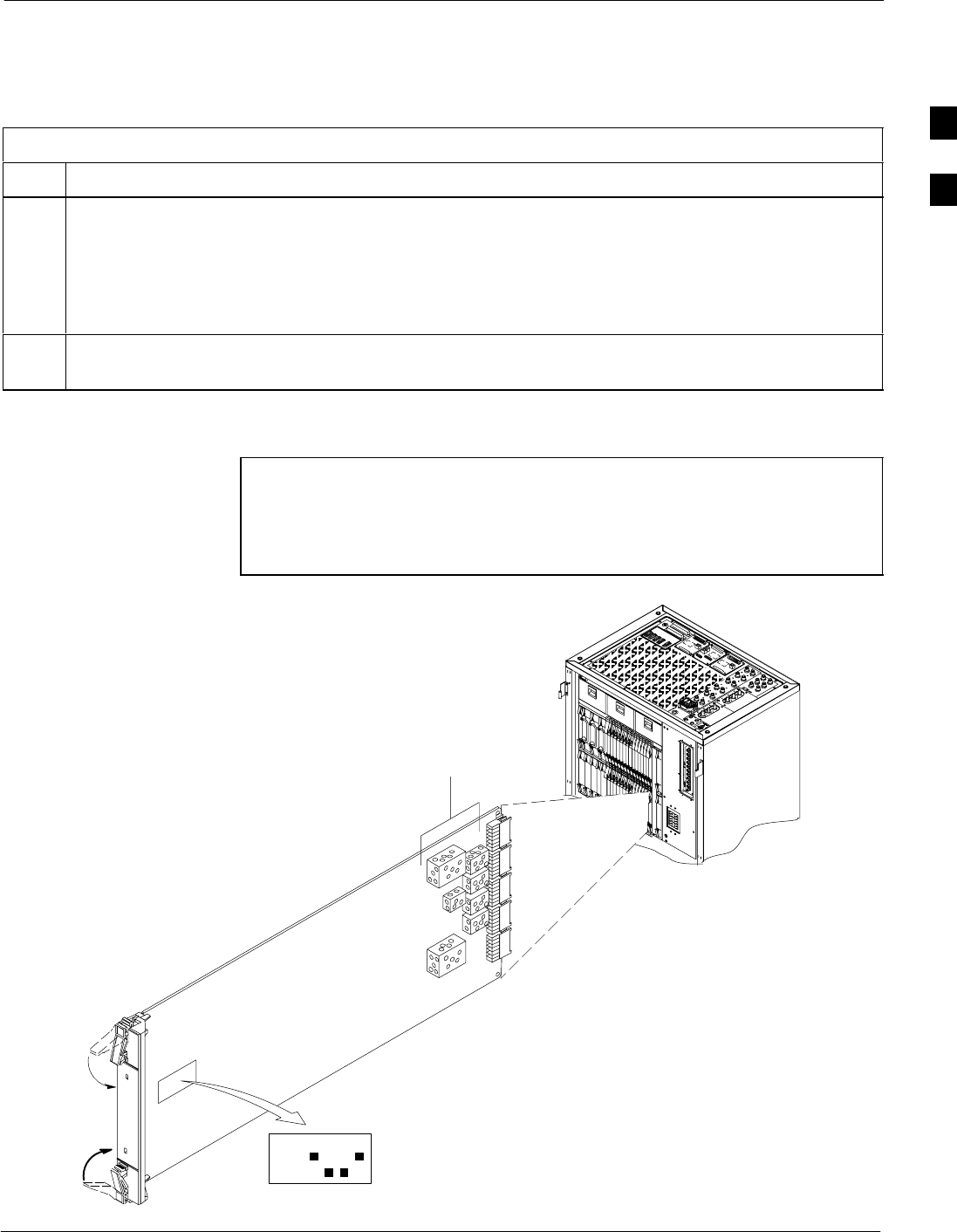
Preliminary Operations: Overview68P09258A31–A
Oct 2003 1X SCt 4812T BTS Optimization/ATP 2-3
Initial Installation of Boards/Modules
Follow the procedure in Table 2-1 to verify the initial installation of
boards/modules.
Table 2-1: Initial Installation of Boards/Modules
Step Action
1Refer to the site documentation and install all boards and modules into the appropriate shelves as
required. Verify they are NOT SEATED at this time.
NOTE
NOTE
On 800 MHz systems, the Switch Card has a configuration switch that must match the site
configuration (see Figure 2-1).
2As the actual site hardware is installed, record the serial number of each module on a “Serial Number
Checklist” in the site logbook.
Figure 2-1: 800 MHz Configuration Switch Card
NOTE Configuration Switch (shown in Figure 2-1) is a feature on the
newer versions of the 800 Mhz switch card (some earlier cards
do not have the switch). Configuration shown is for 3 Sector
BTS. Switch 1 chooses BTS or MF. Switch 4 chooses 3–sector
or 6 sector. Switches 2 & 3 are not used.
Switch Card
1234
ON
BTS
MF
3 Sector
6 Sector
J1
J2
J3
J4
J5
SHIELDS
Configuration
Switch
FW00379
2
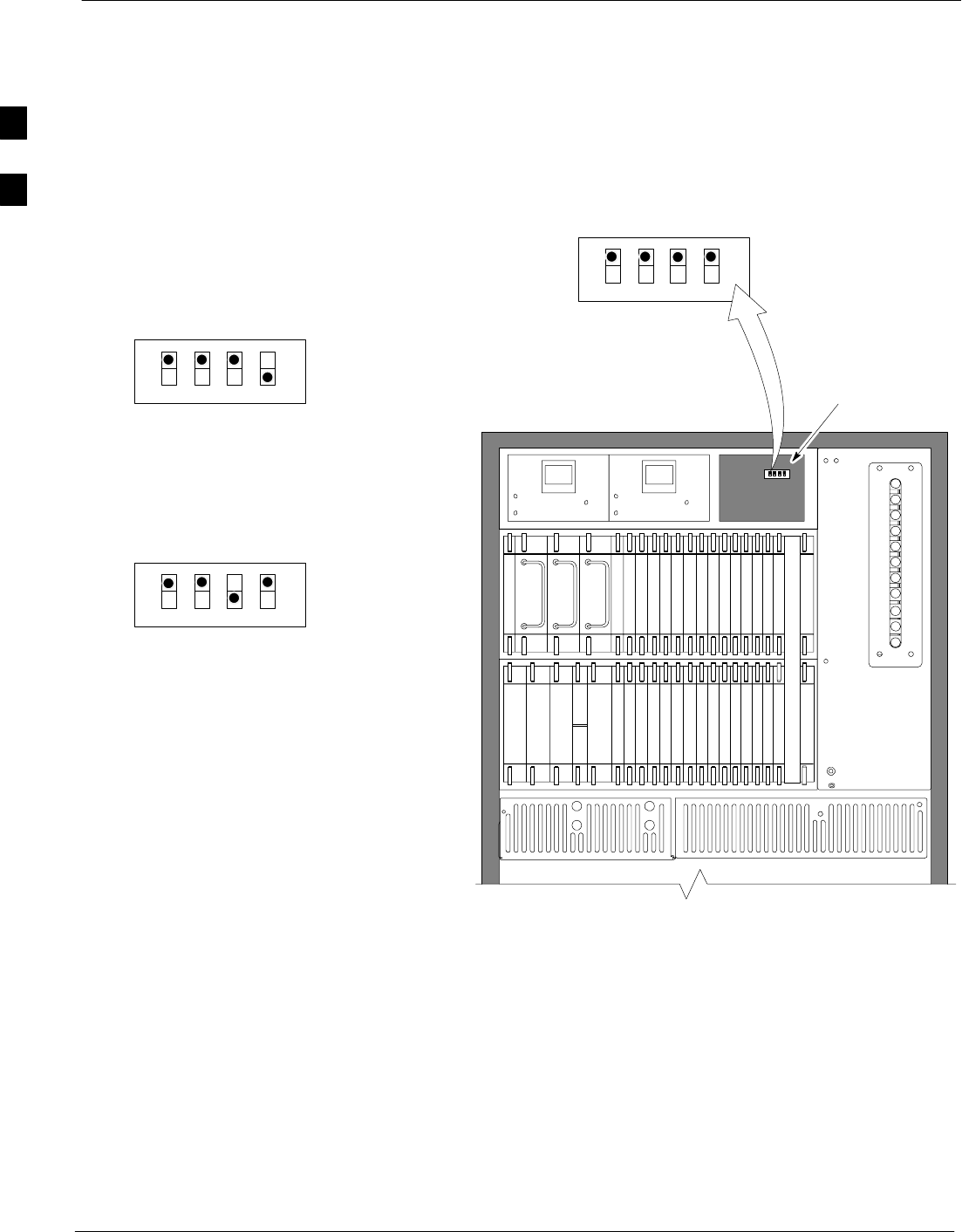
Preliminary Operations: Overview 68P09258A31–A
Oct 2003
1X SCt 4812T BTS Optimization/ATP
2-4
Setting Frame C–CCP Shelf Configuration Switch
The backplane switch settings behind the fan module nearest the breaker
panel should be set as shown in Figure 2-2.
The switch setting must be verified and set before power is applied to the
BTS equipment.
Figure 2-2: Backplane DIP Switch Settings – SC 4812T
19 mm Filter Panel
Power Supply
AMR / MACH
HSO
CSM
CSM
39 mm Filter Panel
AMR / MACH
GLI2GLI2
MCC–6
BBX–1
BBX–2
BBX–3
BBX–4
BBX–5
BBX–6
BBX–R
Switch
MPCMPC
CIO
BBX–7
BBX–8
BBX–9
BBX–10
BBX–11
BBX–12
MCC–5
MCC–4
MCC–3
MCC–2
MCC–1
MCC–12
MCC–11
MCC–10
MCC–9
MCC–8
MCC–7
Power Supply
Power Supply
CCD CCD
FAN
MODULE
PWR/ALM
REAR
FRONT
FAN
MODULE
PWR/ALM
REAR
FRONT
ON
OFF
SC 4812T C–CCP SHELF
FAN MODULE
REMOVED
STARTER
FRAME
SETTING
ON
OFF
EXPANSION
FRAME 1
SETTING
ON
OFF
EXPANSION
FRAME 2
SETTING
BOTTOM / TOP
RIGHT / LEFT
MODEM_FRAME_ID_1
MODEM_FRAME_ID_0
BOTTOM / TOP
RIGHT / LEFT
MODEM_FRAME_ID_1
MODEM_FRAME_ID_0
BOTTOM / TOP
RIGHT / LEFT
MODEM_FRAME_ID_1
MODEM_FRAME_ID_0
FW00151REF
2

Pre–Power–up Tests68P09258A31–A
Oct 2003 1X SCt 4812T BTS Optimization/ATP 2-5
Pre–Power–up Tests
Objective
This procedure checks for any electrical short circuits and verifies the
operation and tolerances of the cellsite and BTS power supply units prior
to applying power for the first time.
Test Equipment
The following test equipment is required to complete the pre–power–up
tests:
SDigital Multimeter (DMM)
CAUTION Always wear a conductive, high impedance wrist strap while
handling the any circuit card/module to prevent damage by ESD.
Cabling Inspection
Using the site-specific documentation generated by Motorola Systems
Engineering, verify that the following cable systems are properly
connected:
SReceive RF cabling – up to 12 RX cables
STransmit RF cabling – up to six TX cables
SGPS
SLFR
NOTE For positive power applications (+27 V):
SThe positive power cable is red.
SThe negative power cable (ground) is black.
For negative power applications (–48 V):
SThe negative power cable is red or blue.
SThe positive power cable (ground) is black.
In all cases, the black power cable is at ground potential.
2

Pre–Power–up Tests 68P09258A31–A
Oct 2003
1X SCt 4812T BTS Optimization/ATP
2-6
DC Power Pre-test (BTS Frame)
Before applying any power to the BTS frame, follow the procedure in
Table 2-2 while referring to Figure 2-3 and Figure 2-4 for +27 V
systems or to Figure 2-5 and Figure 2-6 for –48 V systems to verify
there are no shorts in the BTS frame DC distribution system.
Table 2-2: DC Power Pre–test (BTS Frame)
Step Action
1Physically verify that all DC power sources supplying power to the frame are OFF or disabled.
2On each frame:
SUnseat all circuit boards (except CCD and CIO cards) in the C–CCP shelf and LPA shelves, but
leave them in their associated slots.
SSet C–CCP shelf breakers to the OFF position by pulling out power distribution breakers (labeled
C–CCP 1, 2, 3 on the +27 V BTS C–CCP power distribution panel and labeled POWER
1,4,5,2,6,7,3,8,9 on the –48 V C–CCP power distribution panel).
SSet LPA breakers to the OFF position by pulling out the LPA breakers (8 breakers, labeled 1A–1B
through 4C–4D – located on the C–CCP power distribution panel in the +27 V BTS or on the
power conversion shelf power distribution panel in the –48 V BTS).
3Verify that the resistance from the power (+ or –) feed terminals with respect to the ground terminal on
the top of the frame measures > 500 Ω (see Figure 2-3).
SIf reading is < 500 Ω, a short may exist somewhere in the DC distribution path supplied by the
breaker. Isolate the problem before proceeding. A reading > 3 MΩ could indicate an open (or
missing) bleeder resistor (installed across the filter capacitors behind the breaker panel).
4Set the C–CCP (POWER) breakers to the ON position by pushing them IN one at a time. Repeat
Step 3 after turning on each breaker.
NOTE
NOTE
If the ohmmeter stays at 0 Ω after inserting any board/module, a short probably exists in that
board/module. Replace the suspect board/module and repeat the test. If test still fails, isolate the
problem before proceeding.
5Insert and lock the DC/DC converter modules for the C–CCP shelf and into their associated slots one
at a time. Repeat Step 3 after inserting each module.
SA typical response is that the ohmmeter steadily climbs in resistance as capacitors charge, finally
indicating approximately 500 Ω.
! CAUTION
! CAUTION
Verify the correct power/converter modules by observing the locking/retracting tabs appear as follows:
– (in +27 V BTS C–CCP shelf)
– (in –48 V BTS C–CCP shelf)
STPN4045A
PWR CONV CDMA RCVR
STPN4009
PWR CONV CDMA RCVR
6Insert and lock all remaining circuit boards and modules into their associated slots in the C–CCP shelf.
Repeat Step 3 after inserting and locking each board or module.
SA typical response is that the ohmmeter steadily climbs in resistance as capacitors charge, stopping
at approximately 500 Ω..
7Set the LPA breakers ON by pushing them IN one at a time.
Repeat Step 3 after turning on each breaker.
SA typical response is that the ohmmeter will steadily climb in resistance as capacitors charge,
stopping at approximately 500 Ω..
. . . continued on next page
2
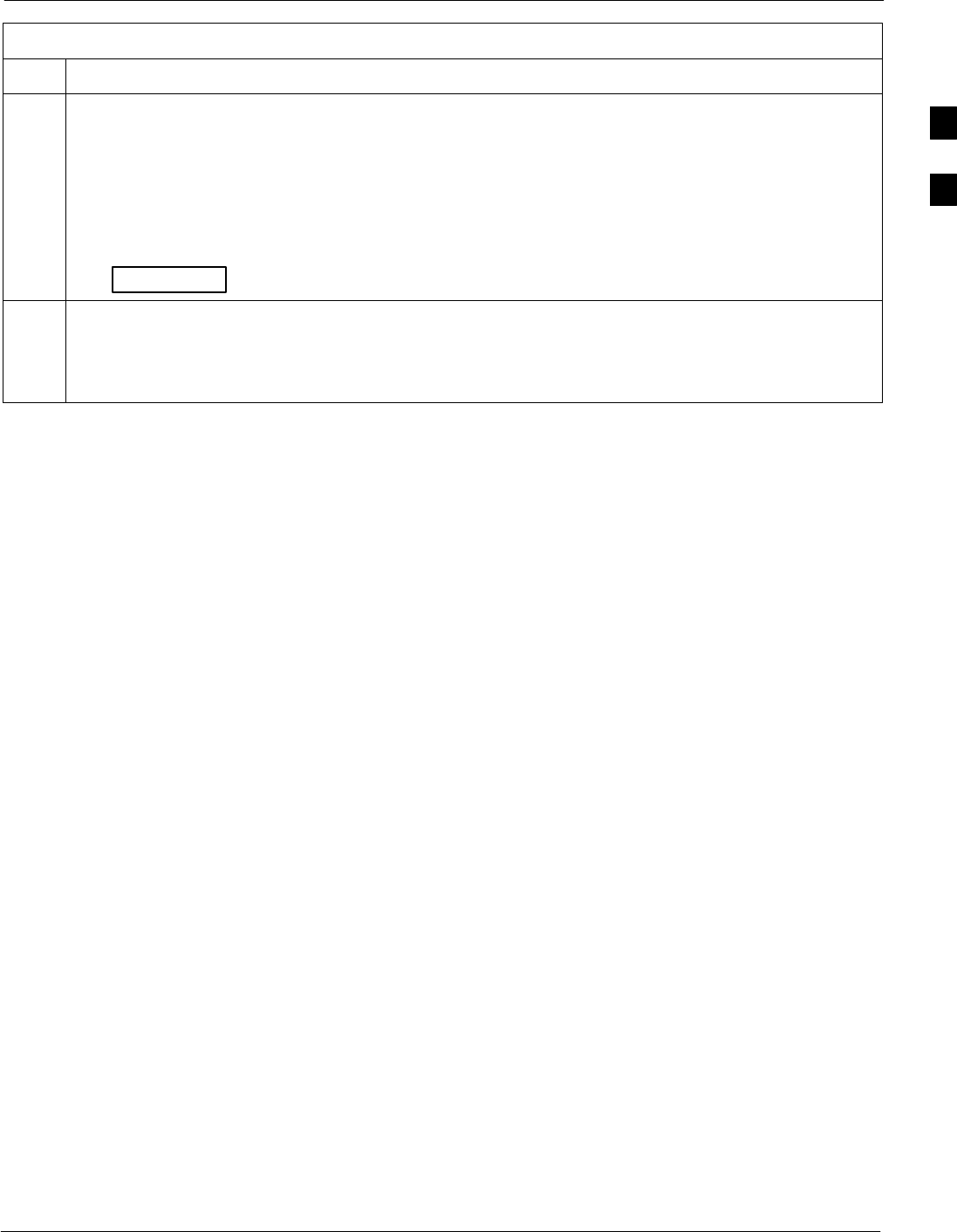
Pre–Power–up Tests68P09258A31–A
Oct 2003 1X SCt 4812T BTS Optimization/ATP 2-7
Table 2-2: DC Power Pre–test (BTS Frame)
Step Action
8In the –48 V BTS, insert and lock the DC/DC LPA converter modules into their associated slots one at
a time.
Repeat Step 3 after inserting each module.
SA typical response is that the ohmmeter steadily climbs in resistance as capacitors charge, finally
indicating approximately 500 Ω.
! CAUTION
Verify the correct power/converter modules by observing the locking/retracting tabs appear as follows:
– (in –48 V BTS power conversion shelf)
STPN4044A
PWR CONV LPA
9Seat all LPA and associated LPA fan modules into their associated slots in the shelves one at a time.
Repeat Step 3 after seating each LPA and associated LPA fan module.
SA typical response is that the ohmmeter will steadily climb in resistance as capacitors charge,
stopping at approximately 500 Ω..
2
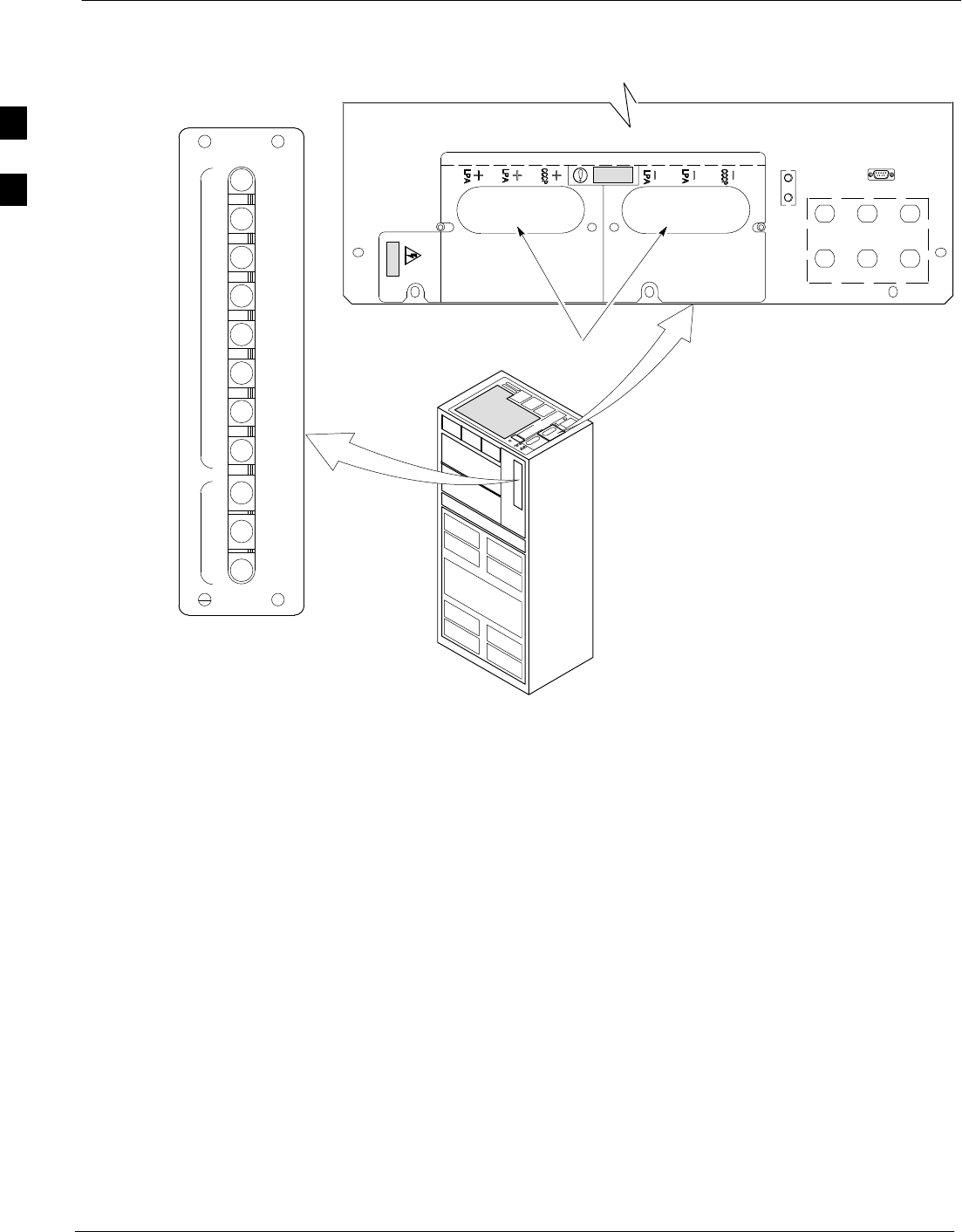
Pre–Power–up Tests 68P09258A31–A
Oct 2003
1X SCt 4812T BTS Optimization/ATP
2-8
Figure 2-3: +27 V BTS DC Distribution Pre-test
POWER INPUT
TOP OF FRAME
BREAKER PANEL
LPA
BREAKERS
C–CCP
BREAKERS
4
GND
5
6
1
2
3
TX OUT
CAUTION
LIVE TERMINALSLIVE TERMINALS +27 VDC
LFR/
HSO
Breakering:
S Two LPAs on each trunking backplane breakered together
S Designed for peak LPA current of 15 amps (30 amp breakers)
S Unused TX paths do not need to be terminated
S Single feed for C–CCP
S Dual feed for LPA
FW00298
1D
1B
2B
2D
1C
1A
2A
2C
30
30
30
30
30
30
30
30
3D
3B
4B
4D
3C
3A
4A
4C
50
50
50
1
2
3
C
C
P
L
P
A
C
2
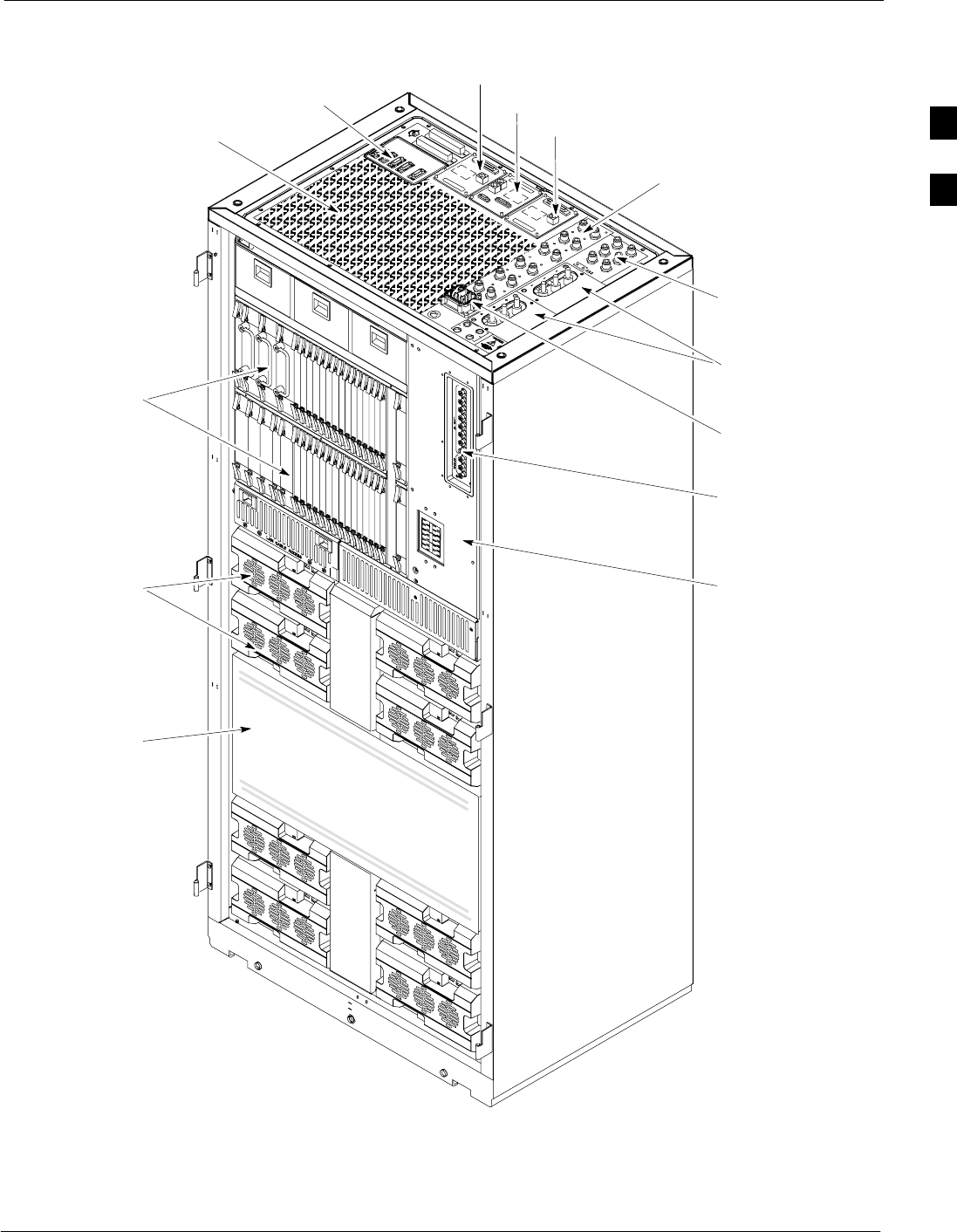
Pre–Power–up Tests68P09258A31–A
Oct 2003 1X SCt 4812T BTS Optimization/ATP 2-9
Figure 2-4: +27 V SC 4812T BTS Starter Frame
Expansion I/O
Housing
For clarity, doors are not shown. FW00214
Front Cosmetic
Panel
Power Input
Connection
TX Out (1 – 6)
Span I/O B
Span I/O A
Site I/O
RX In (1A – 6A
and 1B – 6B)
Exhaust Region
C–CCP Cage
Breakers
Combiner
Section
RGD (Needed for
Expansion only)
LPA Cage
2
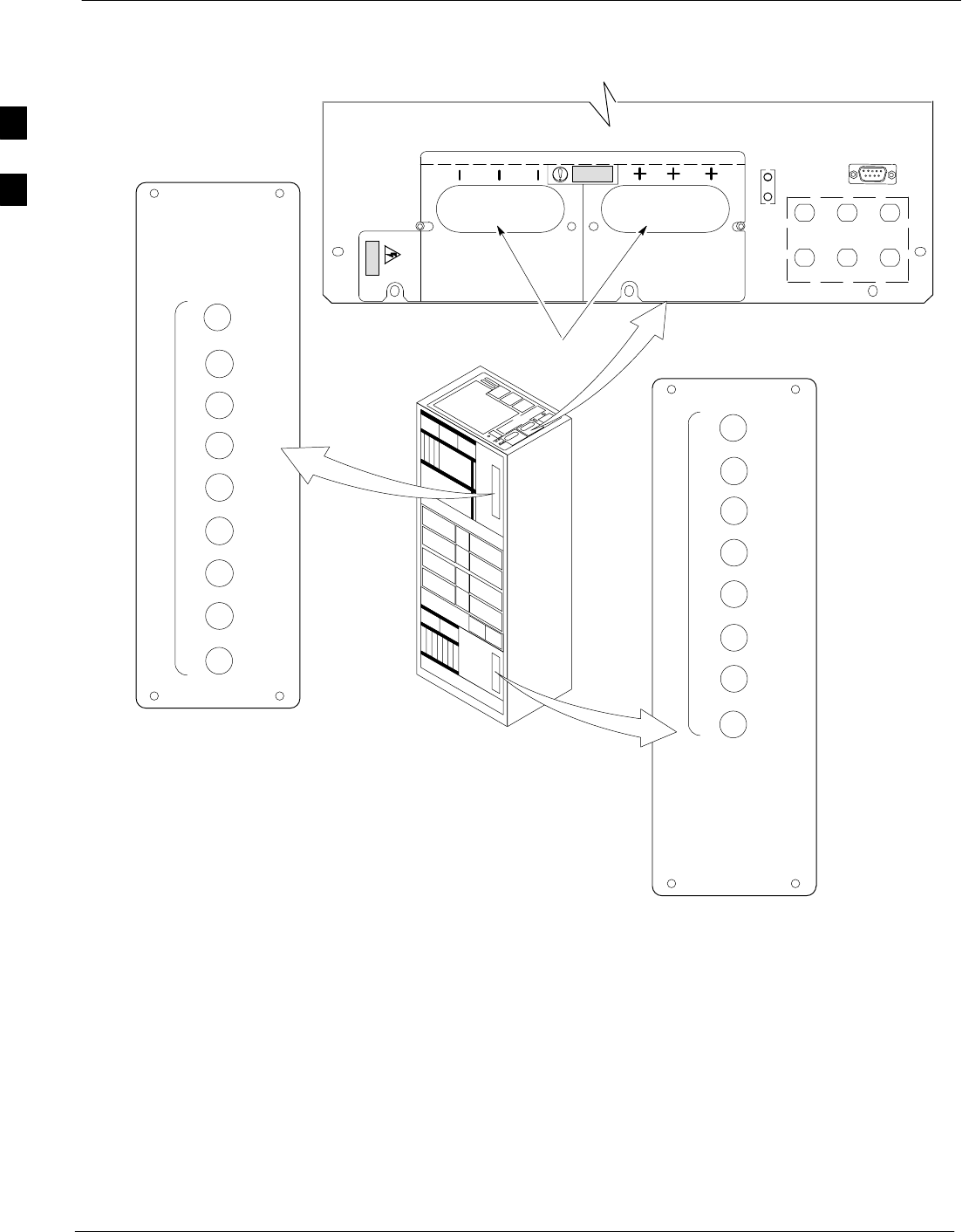
Pre–Power–up Tests 68P09258A31–A
Oct 2003
1X SCt 4812T BTS Optimization/ATP
2-10
Figure 2-5: –48 V BTS DC Distribution Pre-test
4
1
5
2
7
6
3
8
P
9
O
W
E
R
30
40
40
30
40
40
30
40
40
POWER INPUT
TOP OF FRAME
C–CCP BREAKER
LPA
BREAKER
4
GND
5
6
1
2
3
TX OUT
CAUTION
LIVE TERMINALSLIVE TERMINALS WIRED FOR –48 VDC
LFR
HSO/
Breakering:
S Two LPAs on each trunking backplane breakered together
S Designed for peak LPA current of 15 amps (30 A breakers)
S Unused TX paths do not need to be terminated
S Single feed for C–CCP
S Dual feed for LPA
FW00483
1
2
3
1
2
3
1C
1A
2A
2C
3C
3A
4A
4C
L
P
A
1D
1B
2B
2D
3D
3B
4B
4D
30
30
30
30
30
30
30
30
2
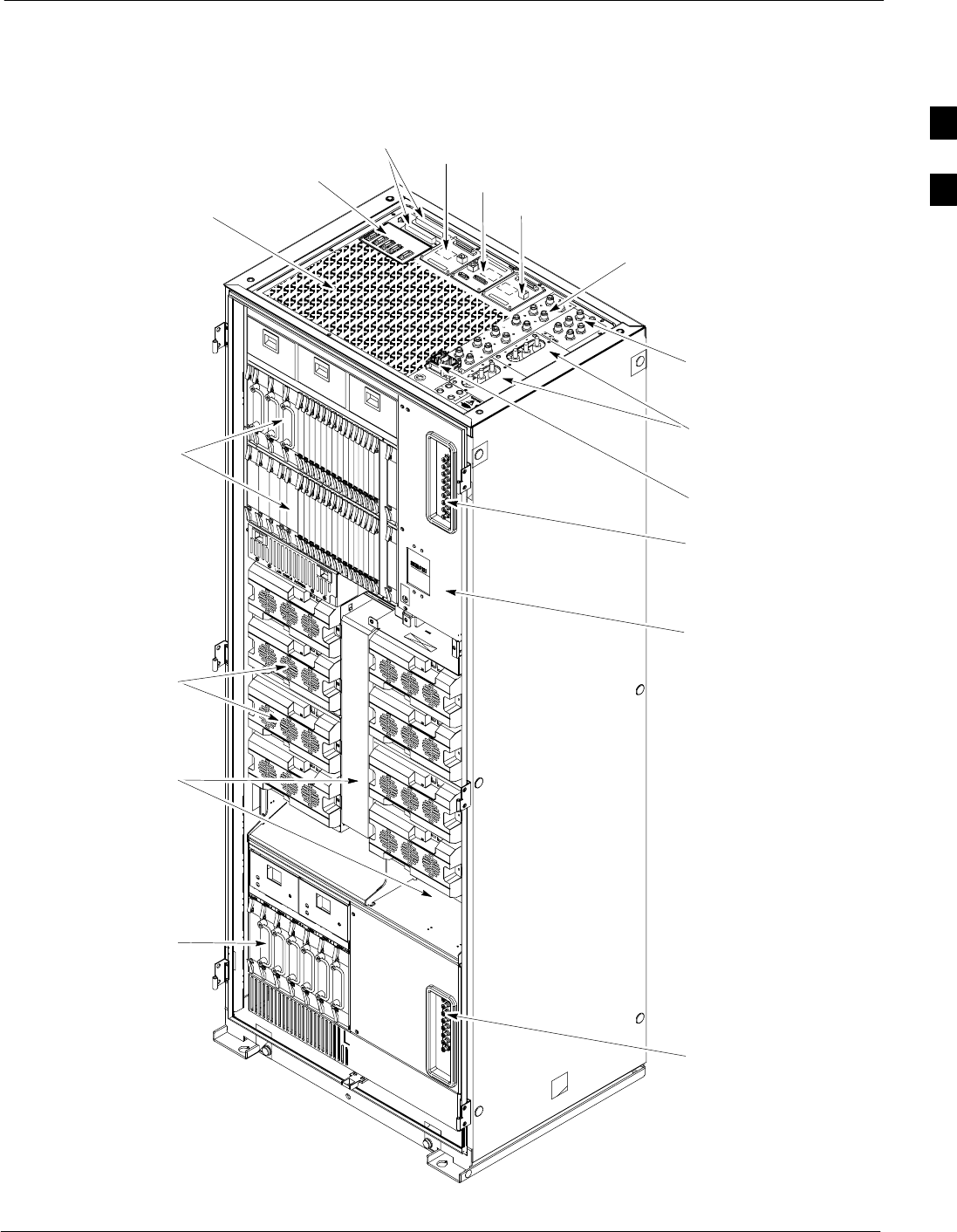
Pre–Power–up Tests68P09258A31–A
Oct 2003 1X SCt 4812T BTS Optimization/ATP 2-11
Figure 2-6: –48 V SC 4812T BTS Starter Frame
FW00477
Expansion I/O
Housing
For clarity, doors are not shown.
Front Cosmetic
Panel
Power Input
Connection
TX Out (1 – 6)
Span I/O B
Span I/O A
Site I/O
RX In (1A – 6A
and 1B – 6B)
Exhaust Region
C–CCP Cage
Breakers
Combiner
Section
RGD (Needed for
Expansion only)
LPA Cage
Power
Conversion
Shelf
Breakers
Alarms
2
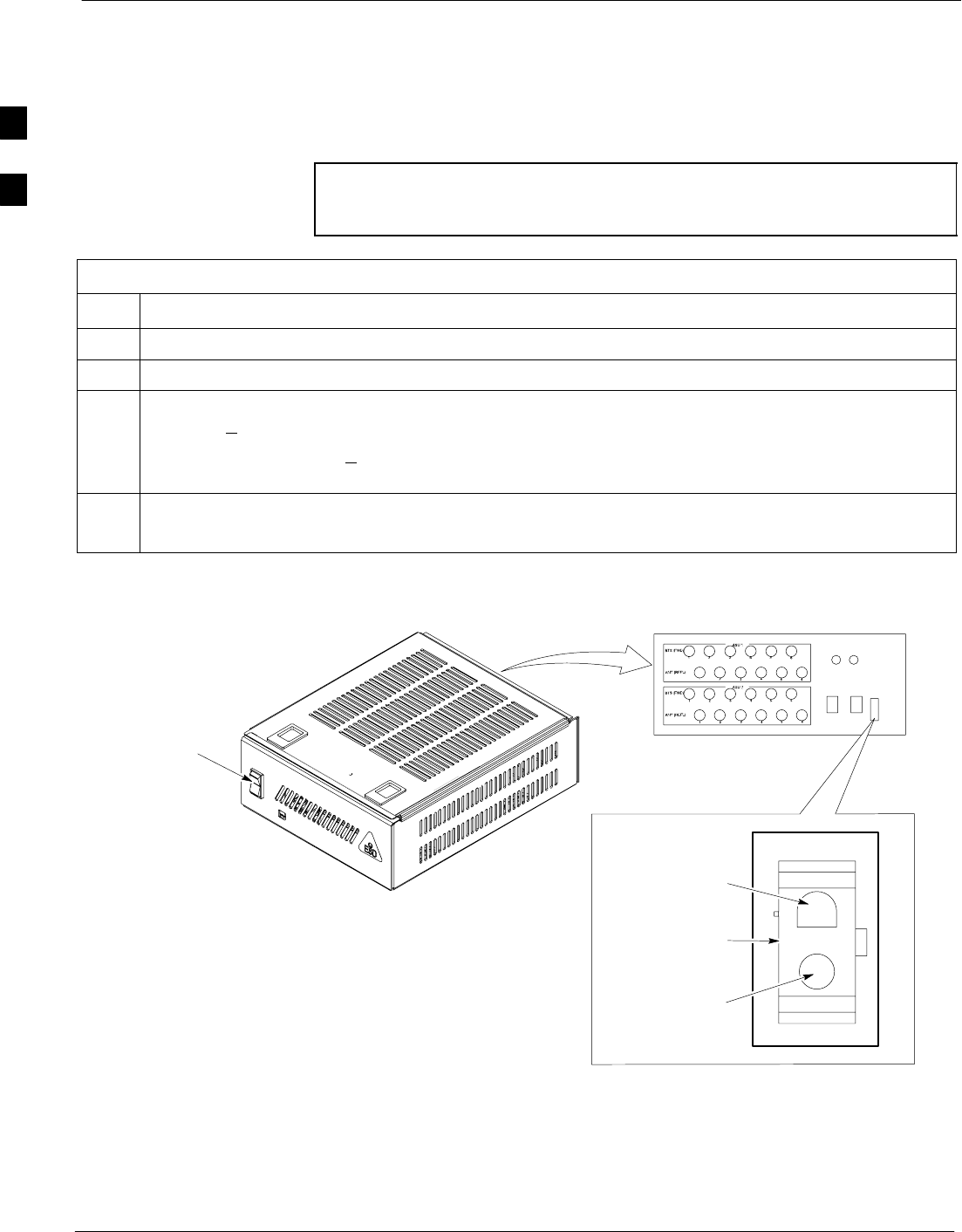
Pre–Power–up Tests 68P09258A31–A
Oct 2003
1X SCt 4812T BTS Optimization/ATP
2-12
DC Power Pre-test (RFDS)
Before applying power to the RFDS, follow the steps in Table 2-3, while
referring to Figure 2-7, to verify there are no shorts in the RFDS DC
distribution system, backplanes, or modules/boards. As of the date of
this publication, the RFDS is not used with the –48 V BTS.
NOTE Visual inspection of card placement and equipage for each frame
vs. site documentation must be completed, as covered in
Table 2-1 on page 2-3, before proceeding with this test.
Table 2-3: DC Power Pre-test (RFDS)
Step Action
1Physically verify that all DC/DC converters supplying the RFDS are OFF or disabled.
2Set the input power rocker switch P1 to the OFF position (see Figure 2-7).
3Verify the initial resistance from the power (+ or –) feed terminal with respect to ground terminal
measures > 5 kΩ , then slowly begins to increase.
SIf the initial reading is < 5 kΩ and remains constant, a short exists somewhere in the DC
distribution path supplied by the breaker. Isolate the problem before proceeding.
4Set the input power rocker switch P1 to the ON position.
Repeat Step 3.
Figure 2-7: DC Distribution Pre-test (COBRA RFDS Detail)
NOTE:
Set the input power switch ON while measuring the
resistance from the DC power – with respect to the
power + terminal on the rear of the COBRA RFDS.
INPUT POWER
SWITCH (P1)
FRONT OF COBRA RFDS
(cut away view shown for clarity)
RFDS REAR
INTERCONNECT PANEL
“–” CONNECTOR
PIN
“+” CONNECTOR
PIN
CONNECTOR (MADE
UP OF A HOUSING
AND TWO PINS)
FW00139
2

Initial Power–up Tests and Procedures68P09258A31–A
Oct 2003 1X SCt 4812T BTS Optimization/ATP 2-13
Initial Power–up Tests and Procedures
Power-up Procedures
WARNING Potentially lethal voltage and current levels are routed to the
BTS equipment. This test must be performed with a second
person present, acting in a safety role. Remove all rings, jewelry,
and wrist watches prior to beginning this test.
DC Input Power
In the tests to follow, power will first be verified at the input to each
BTS frame. After power is verified, cards and modules within the frame
itself will be powered up and verified one at a time.
Before applying any power, verify the correct power feed and return
cables are connected between the power supply breakers and the power
connectors at the top of each BTS frame. Verify correct cable position
referring to Figure 2-3 on page 2-8 for +27 V systems and Figure 2-5
on page 2-10 for –48 V systems.
CAUTION Always wear a conductive, high impedance wrist strap while
handling any circuit card/module to prevent damage by ESD.
Extreme care should be taken during the removal and installation
of any card/module. After removal, the card/module should be
placed on a conductive surface or back into the anti–static bag in
which it was shipped.
NOTE For positive power applications (+27 V):
SThe positive power cable is red.
SThe negative power cable (ground) is black.
For negative power applications (–48 V):
SThe negative power cable is red or blue.
SThe positive power cable (ground) is black.
In all cases, the black power cable is at ground potential.
Motorola recommends that the DC input power cable used to connect the
frame to the main DC power source conforms to the guidelines outlined
in Table 2-4.
Table 2-4: DC Input Power Cable Guidelines
Maximum Cable Length Wire Size
30.38 m (100 ft) 107 mm2 (AWG #4/0)
54.864 m (180 ft) 185 mm2 (350 kcmil)
Greater that 54.864 m (180 ft) Not recommended
NOTE If Anderson SB350 style power connectors are used, make sure
the connector adapters are securely attached to each of the BTS
power feeds and returns. Also, make sure the cables have been
properly installed into each connector.
2

Initial Power–up Tests and Procedures 68P09258A31–A
Oct 2003
1X SCt 4812T BTS Optimization/ATP
2-14
Common Power Supply Verification
The procedure in Table 2-5 must be performed on any BTS frame
connected to a common power supply at the site after the common power
supply has been installed and verified per the power supply OEM
suggested procedures.
Perform the following steps to verify the power input is within
specification before powering up the individual cards/modules with the
frames themselves.
Table 2-5: Common Power Supply Verification
Step Action
1Physically verify that all DC power sources supplying the frame are OFF or disabled.
2On the RFDS (for +27 V systems only), set the input power switch P1 to the OFF position (see
Figure 2-7).
3On each frame:
SUnseat all circuit boards (except CCD and CIO cards) in the C–CCP shelf and LPA shelves, but
leave them in their associated slots.
SSet breakers to the OFF position by pulling out C–CCP and LPA breakers (see Figure 2-3 on
page 2-8 or Figure 2-5 on page 2-10 for breaker panel layout if required).
– C–CCP shelf breakers are labeled CCCP–1, 2, 3 in the +27 V BTS and labeled POWER
1,4,5,2,6,7,3,8,9 in the –48 V BTS.
– LPA breakers are labeled 1A–1B through 4C–4D.
4Inspect input cables, verify correct input power polarity via decal on top of frame (+27 Vdc or
–48 Vdc).
5Apply power to BTS frames, one at a time, by setting the appropriate breaker in the power supply that
supplies the frame to the ON position.
6After power is applied to each frame, use a digital voltmeter to verify power supply output voltages at
the top of each BTS frame are within specifications: +27.0 Vdc or –48 Vdc nominal.
2
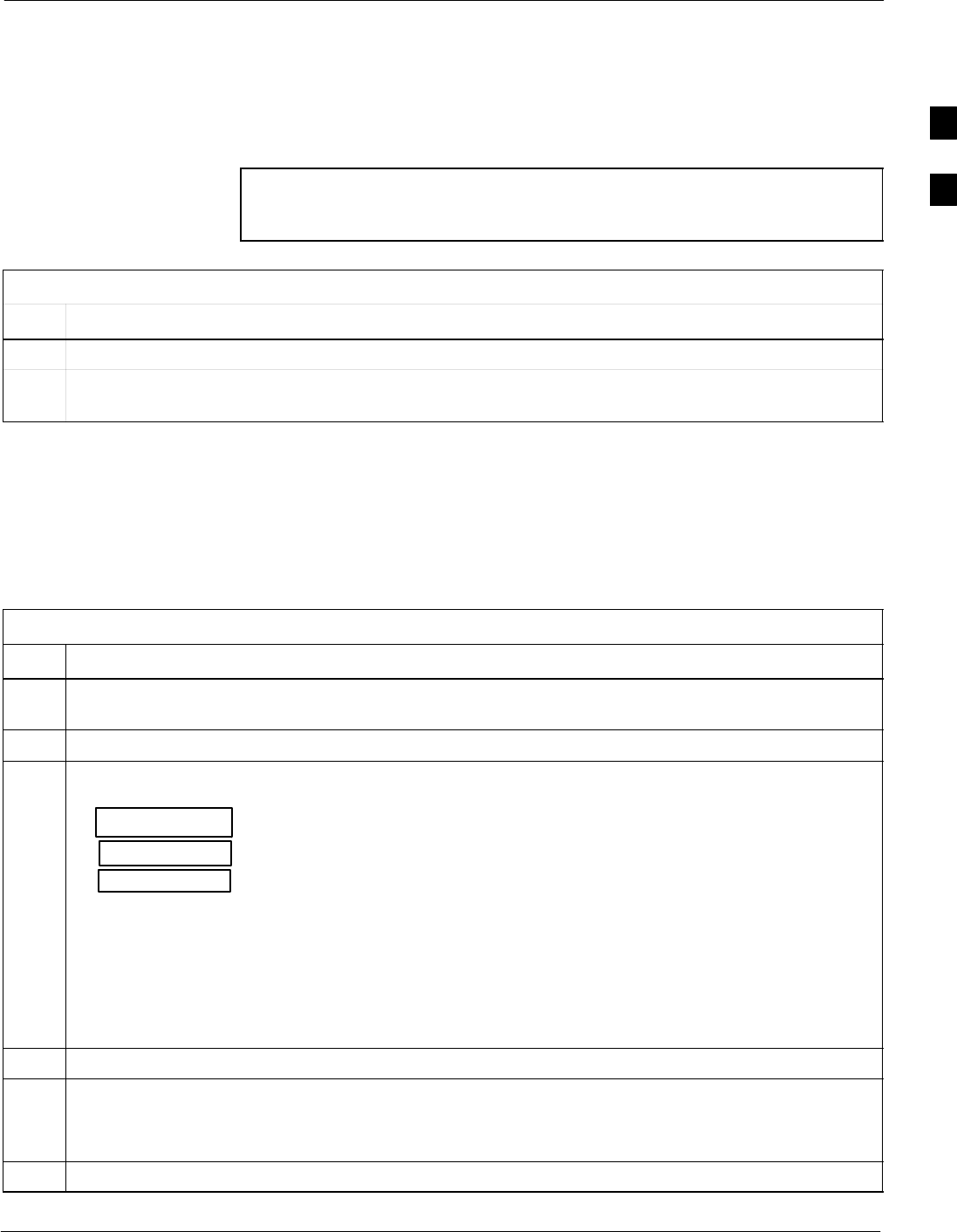
Initial Power–up Tests and Procedures68P09258A31–A
Oct 2003 1X SCt 4812T BTS Optimization/ATP 2-15
Initial Power-up (RFDS)
The procedure in Table 2-6 must be performed on the RFDS after input
power from the common power supply has been verified. Perform the
following steps to apply initial power to the cards/modules within the
frame itself, verifying that each is operating within specification.
NOTE Visual inspection of card placement and equipage for each frame
vs. site documentation must be completed, as covered in
Table 2-1, on page 2-3, before proceeding with this test.
Table 2-6: Initial Power-up (RFDS)
Step Action
1On the RFDS, set the input power rocker switch (P1) to the ON position (see Figure 2-7).
2Verify power supply output voltages (at the top of BTS frame), using a digital voltmeter, are within
specifications: +27.0 V nominal.
Initial Power-up (BTS)
The procedure must be performed on each frame after input power from
the common power supply has been verified. Follow the steps in
Table 2-7 to apply initial power to the cards/modules within the frame
itself, verifying that each is operating within specification.
Table 2-7: Initial Power–up (BTS)
Step Action
1At the BTS, set the C–CCP (POWER) power distribution breakers (see Figure 2-3 on page 2-8 or
Figure 2-5 on page 2-10) to the ON position by pushing in the breakers.
2Insert the C–CCP fan modules. Observe that the fan modules come on line.
3! CAUTION
Verify the correct power/converter modules by observing the locking/retracting tabs appear as follows:
– (in +27 V BTS C–CCP shelf)
– (in –48 V BTS C–CCP shelf)
– (in –48 V BTS power conversion shelf)
Insert and lock the converter/power supplies into their associated slots one at a time.
•If no boards have been inserted, all three PWR/ALM LEDs would indicate RED to notify the user
that there is no load on the power supplies.
– If the LED is RED, do not be alarmed. After Step 4 is performed, the LEDs should turn GREEN;
if not, then a faulty converter/power supply module is indicated and should be replaced before
proceeding.
STPN 4045A
PWR CONV CDMA RCVR
STPN 4044A
PWR CONV LPA
STPN4009
PWR CONV CDMA RCVR
4Seat and lock all remaining circuit cards and modules in the C–CCP shelf into their associated slots.
5Seat the first equipped LPA module pair into the assigned slot in the upper LPA shelf including LPA
fan.
SIn +27 V systems, observe that the LPA internal fan comes on line.
6Repeat step 5 for all remaining LPAs.
. . . continued on next page
2

Initial Power–up Tests and Procedures 68P09258A31–A
Oct 2003
1X SCt 4812T BTS Optimization/ATP
2-16
Table 2-7: Initial Power–up (BTS)
Step Action
7Set the LPA breakers to the ON position (per configuration) by pushing them IN one at a time. See
Figure 1-13 on page 1-32 or Figure 1-14 on page 1-33 for configurations and Figure 2-3 on page 2-8
or Figure 2-5 on page 2-10 for LPA breaker panel layout.
On +27 V frames, engage (push) LPA circuit breakers.
SConfirm LEDs on LPAs light.
On –48 V frames, engage (push) LPA PS circuit breakers.
SConfirm LPA PS fans start.
SConfirm LEDs on –48 V power converter boards light.
SConfirm LPA fans start.
SConfirm LEDs on LPAs light.
8After all cards/modules have been seated and verified, use a digital voltmeter to verify power supply
output voltages at the top of the frame remain within specifications: +27.0 Vdc or –48 Vdc nominal.
9Repeat Steps 1 through 8 for additional co–located frames (if equipped).
2
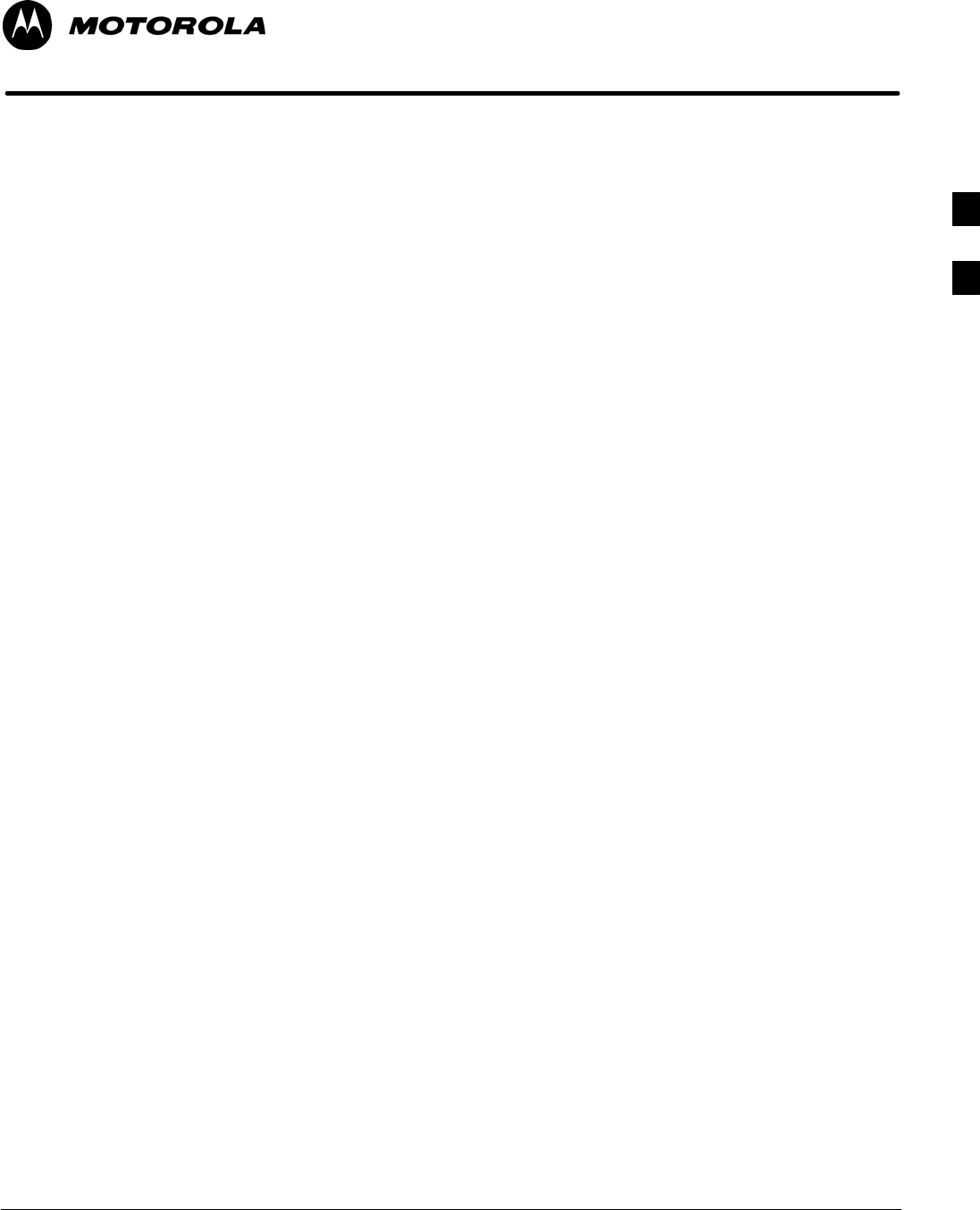
Oct 2003 1X SCt 4812T BTS Optimization/ATP 3-1
Chapter 3
Optimization/Calibration
3
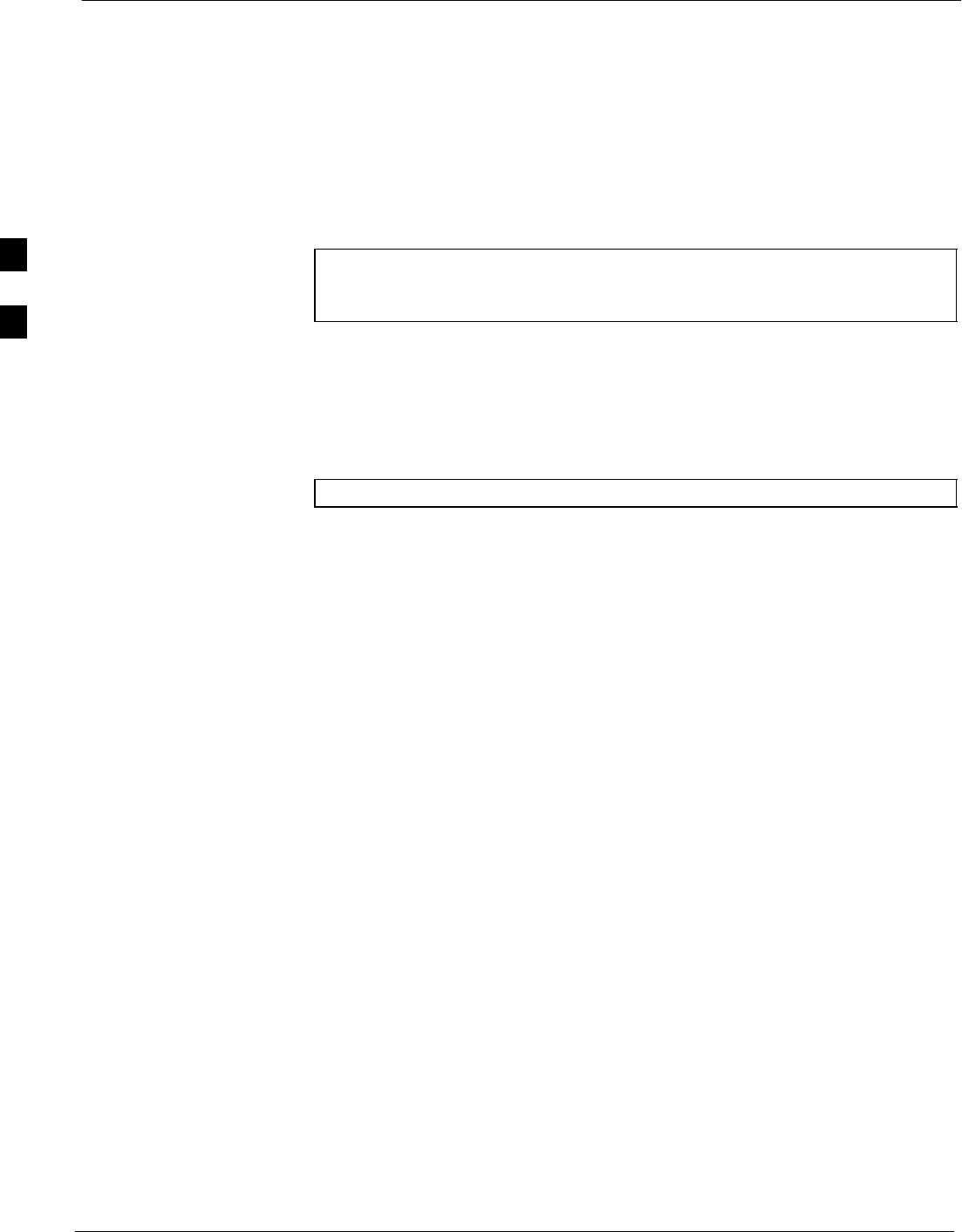
Introduction to Optimization and Calibration 68P09258A31–A
Oct 2003
1X SCt 4812T BTS Optimization/ATP
3-2
Introduction to Optimization and Calibration
Overview
This section describes procedures for isolating the BTS from the span
lines, preparing and using the LMF, downloading system operating
software, CSM reference verification/optimization, set up and calibration
of the supported test equipment, transmit/receive path verification, using
the RFDS, and verifying the customer defined alarms and relay contacts
are functioning properly.
NOTE Before using the LMF, use an editor to view the “CAVEATS”
section in the “readme.txt” file in the c:\wlmf folder for any
applicable information.
Optimization Process Summary
After a BTS is physically installed and the preliminary operations, such
as power up, have been completed, the LMF is used to optimize the
BTS. The basic optimization process consists of the following:
1. Download MGLI–1 with code and data and then enable MGLI–1.
NOTE GLIs may be GLI2s or GLI3s.
2. Use the status function and verify that all of the installed devices of
the following types respond with status information: CSM, BBX,
GLI, MCC, and TSU (if RFDS is installed). If a device is installed
and powered up but is not responding and is colored gray in the BTS
display, the device is not listed in the CDF/NECF file. The
CDF/NECF file must be corrected before the device can be accessed
by the LMF.
3. Download code and data to all devices of the following types:
– CSM
– BBX (may be BBX2 or BBX–1X)
– GLI (other than MGLI–1)
– MCC (may be MCC–8E, MCC24, or MCC–1X)
4. Download the RFDS TSIC (if installed).
5. Verify the operation of the GPS and HSO or LFR signals.
6. Enable the following devices (in the order listed):
– Secondary CSM
– Primary CSM
– All MCCs
7. Using the LMF test equipment selection function, select the test
equipment to be used for the calibration.
8. Calibrate the TX and RX test cables if they have not previously been
calibrated using the CDMA LMF that will be used for the
optimization/calibration. The cable calibration values can also be
entered manually.
9. Connect the required test equipment for a full optimization.
10. Select all of the BBXs and all of the MCCs, and use the full
optimization function. The full optimization function performs TX
calibration, BLO download, TX audit, all TX tests, and all RX tests
for all selected devices.
3
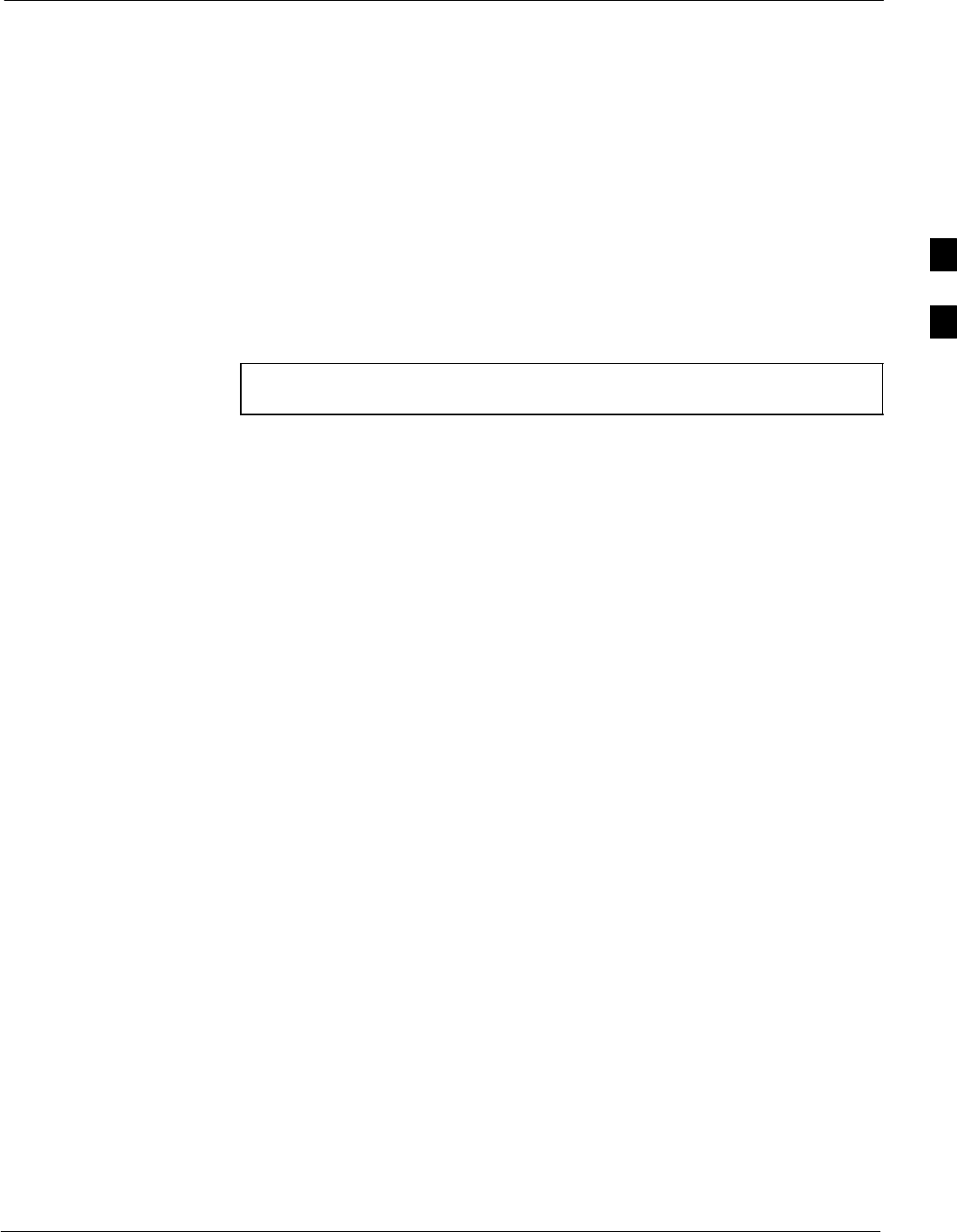
Introduction to Optimization and Calibration68P09258A31–A
Oct 2003 1X SCt 4812T BTS Optimization/ATP 3-3
11. If the TX calibration fails, repeat the full optimization for any failed
paths.
12. If the TX calibration fails again, troubleshoot and correct the
problem that caused the failure and repeat the full optimization for
the failed path.
13. If the TX calibration and audit portion of the full optimization passes
for a path but some of the TX or RX tests fail, correct the problem
that caused the failure and run the individual tests as required until
all TX and RX tests have passed for all paths.
Cell-site Types
Sites are configured as Omni/Omni or Sector/Sector (TX/RX). Each type
has unique characteristics and must be optimized accordingly.
NOTE For more information on the different in site types, please refer
to the applicable Hardware Installation manual.
CDF/NECF
The CDF/NECF (Configuration Data File/Network Element
Configuration File) contains information that defines the BTS and data
used to download files to the devices. A CDF/NECF file must be placed
in the applicable BTS folder before the LMF can be used to log into that
BTS. CDF/NECF files are normally obtained from the CBSC using a
floppy disk. A file transfer protocol (ftp) method can be used if the LMF
computer has that capability. Refer to the LMF Help function on–line
documentation for more information.
The CDF/NECF includes the following information:
SDownload instructions and protocol
SSite specific equipage information
SC–CCP shelf allocation plan
– BBX equipage (based on cell–site type) including redundancy
– CSM equipage including redundancy
– MCC (MCC24E, MCC8E, or MCC–1X) channel element allocation
plan. This plan indicates how the C–CCP shelf is configured, and
how the paging, synchronization, traffic, and access channel
elements (and associated gain values) are assigned among the (up to
12) MCCs in the shelf.
SCSM equipage including redundancy
SEffective Rated Power (ERP) table for all TX channels to antennas
respectively. Motorola System Engineering specifies the ERP of a
transmit antenna based on site geography, antenna placement, and
government regulations. Working from this ERP requirement, the
antenna gain, (dependent on the units of measurement specified) and
antenna feed line loss can be combined to determine the required
power at the top of the BTS frame. The corresponding BBX output
level required to achieve that power level on any channel/sector can
also be determined.
3
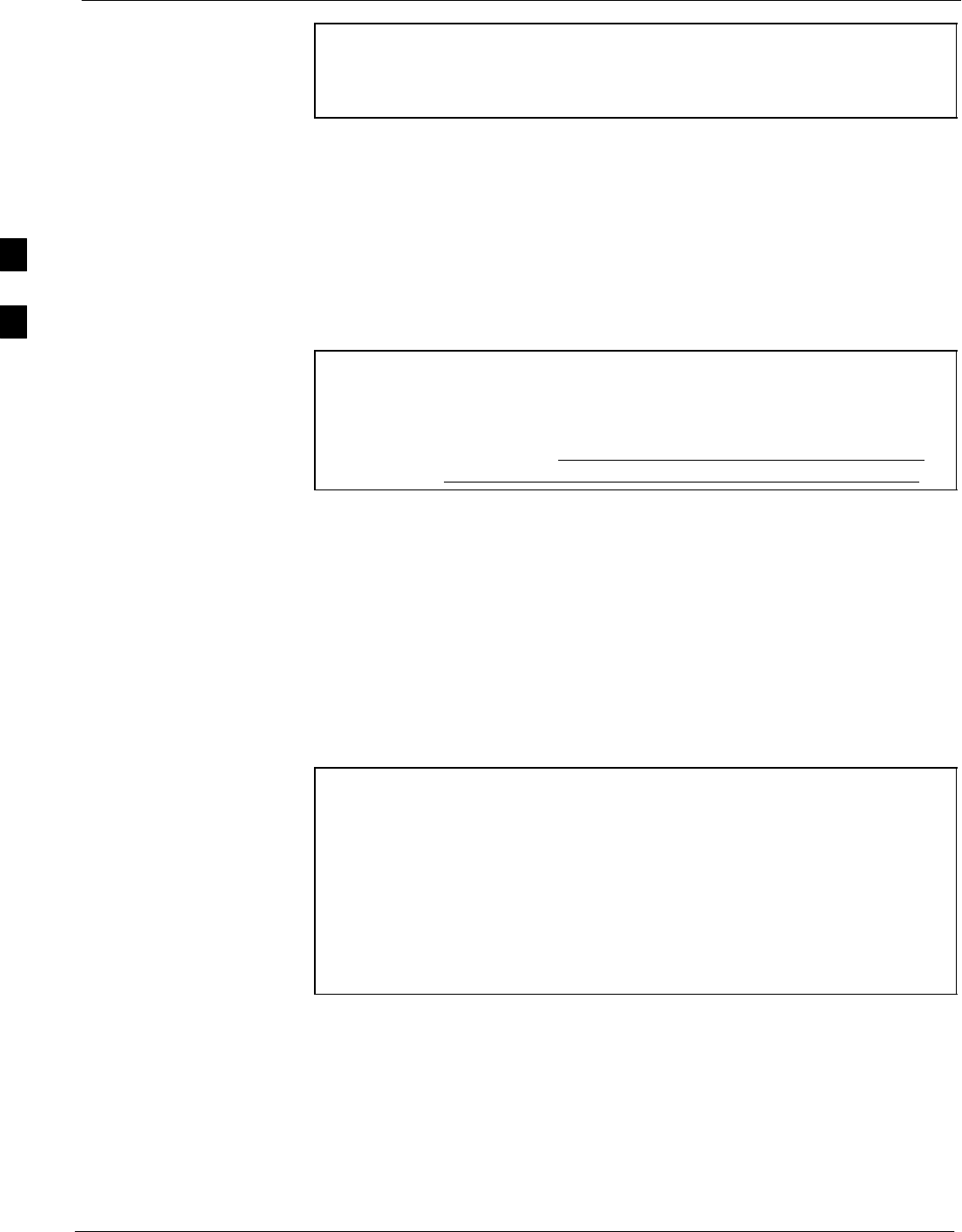
Introduction to Optimization and Calibration 68P09258A31–A
Oct 2003
1X SCt 4812T BTS Optimization/ATP
3-4
NOTE Refer to Figure 3-1 and the LMF Help function on–line
documentation for additional information on the layout of the
LMF directory structure (including CDF/NECF file locations
and formats).
BTS System Software Download
BTS system software must be successfully downloaded to the BTS
processor boards before optimization can be performed. BTS operating
code is loaded from the LMF computer terminal.
BTSs configured for Circuit Backhaul use bts.cdf files. BTSs configured
for Packet Backhaul use bts.necf files (bts–xxx.xml) located on the
OMC/R.
NOTE Before using the LMF for optimization/ATP, the correct
bts–#.cdf (or bts–#.necf) and cbsc–#.cdf files for the BTS must
be obtained from the CBSC and put in a bts–# folder in the
LMF. Failure to use the correct CDF/NECF files can cause
wrong results. Failure to use the correct CDF/NECF files to
log into a live (traffic carrying) site can shut down the site.
The CDF/NECF is normally obtained from the CBSC on a DOS
formatted diskette, or through a file transfer protocol (ftp) if the LMF
computer has ftp capability. Refer to the LMF Help function on–line
documentation for the procedure.
Site Equipage Verification
If you have not already done so, use an editor to view the CDF/NECF,
and review the site documentation. Verify the site engineering equipage
data in the CDF/NECF matches the actual site hardware using a
CDF/NECF conversion table.
CAUTION – Use extreme care not to make any changes to the
CDF/NECF content while viewing the file. Changes to the
CDF/NECF can cause the site to operate unreliably or
render it incapable of operation.
– Always wear a conductive, high impedance wrist strap
while handling any circuit card/module to prevent damage
by ESD. Extreme care should be taken during the removal
and installation of any card/module. After removal, the
card/module should be placed on a conductive surface or
back into the anti–static bag in which it was shipped.
3

Preparing the LMF68P09258A31–A
Oct 2003 1X SCt 4812T BTS Optimization/ATP 3-5
Preparing the LMF
Overview of Packet BTS files
R16.0 and earlier releases had the configuration file called CDF for each
BTS and CBSC used by LMF. In 16.1 Packet BTS, BTS with GLI3
booting in packet binary, the CDF is replaced by two new configuration
files called Network Element Configuration Base (NECB) and Network
Element Change Journal (NECJ). The NECB contains the baseline
configuration and is analogous to the CDF, while the NECJ contains all
the changes made to the configuration since the last time the NECB was
re–generated. Once the NECJ gets to 80% of its maximum size, the
NECB is re–generated and all the updates are rolled into it.
These files play much broader and vital role than previous CDF files.
GLI3 booting in circuit binaries works similar to R16.0.
A few LMF related important facts about these files are listed below.
SBoth files (NECB and NECJ) are in XML format.
SNECB contains all the up-to-date static configuration information and
NECJ contains all the recent changes (including operations) which are
not updated in the NECB.
SBoth files can be viewed in any XML viewer (most easily available is
Internet Explorer V5.0 and higher). They can be also viewed by any
other word processor, but the XML tags will also be seen with them.
SThese files will be created by OMC–R from MIB as per the BTS
provisioning.
SThese files will be regenerated for each software release upgrade on
the system for each BTS.
SThese files will reside on both OMC–R and Packet–GLI3 (unlike
CDF) and will be synchronized periodically between them.
SBoth NECB and NECJ file contain a “SoftwareVersion” field in their
header section indicating the system release version of these files.
SInstead of the bts#.cdf file, the packet LMF uses a bts#.XML file,
which is a copy of the NECB.XML file.
SPacket–GLI3 will need these files for site initialization.
SThe scope of NECB has grown much broader than CDF and has much
more BTS centric information. The use of generic version of these
files should be strictly avoided for the correct site initialization.
3

Preparing the LMF 68P09258A31–A
Oct 2003
1X SCt 4812T BTS Optimization/ATP
3-6
LMF Features and Installation Requirements
Before optimization can be performed, the LMF application software
must be installed and configured on a computer platform meeting
Motorola–specified requirements (see Recommended Test Equipment
and Software in Chapter 1).
NOTE For the CDMA LMF graphics to display properly, the computer
platform must be configured to display more than 256 colors.
See the operating system software instructions for verifying and
configuring the display settings.
Software and files for installation and updating of the LMF are provided
on CD ROM disks. The following installation items must be available:
SLMF Program on CD ROM
SCDF/NECF for each supported BTS (on diskette or available from the
CBSC)
SCBSC File for each supported BTS (on diskette or available from the
CBSC)
FTP Server
To be able to download files to the GLI3, the LMF now runs FTP server
on the LMF laptop. The LMF FTP server runs from the LMFs home
directory. All the files necessary to run the LMF FTP server are installed
from the LMF CD. The FTP server is automatically started by the LMF
upon successful Login to a Packet BTS.
In addition, the LMF provides a new option in the Tools menu called
FTP Server. The option starts the LMFs FTP server if Start is selected,
and stops the server if Stop is selected. The LMFs FTP server runs on
port 21. If any other process is using that port, the error message is
displayed to the user stating that the port is occupied. There is another
option under FTP Server menu called FTP Monitor, which allows the
user to watch FTP activity b/w the LMF and GLI.
Firewalls
Firewalls will block the FTP requests from the Packet GLI to the LMF
laptop. You must disable your firewall before attempting the BTS Synch
command. Some common firewall programs to look for include Network
ICE, BlackICE, Norton’s Desktop Firewall, Enterprise Firewall, and
Personal Firewall.
FTP Server Port in use
On some Windows 2000 installations, a process called “inetd.exe”
makes the FTP server port 21 unusable by the LMF. If the LMF reports
that the FTP server could not start because the port is in use, make sure
the inetd.exe is not running by using the Task Manager’s process list. If
inetd.exe is running, end the process by selecting it and clicking the
“End Process” button. Inetd32.exe is NOT the same and ending it will
not resolve this problem.
3
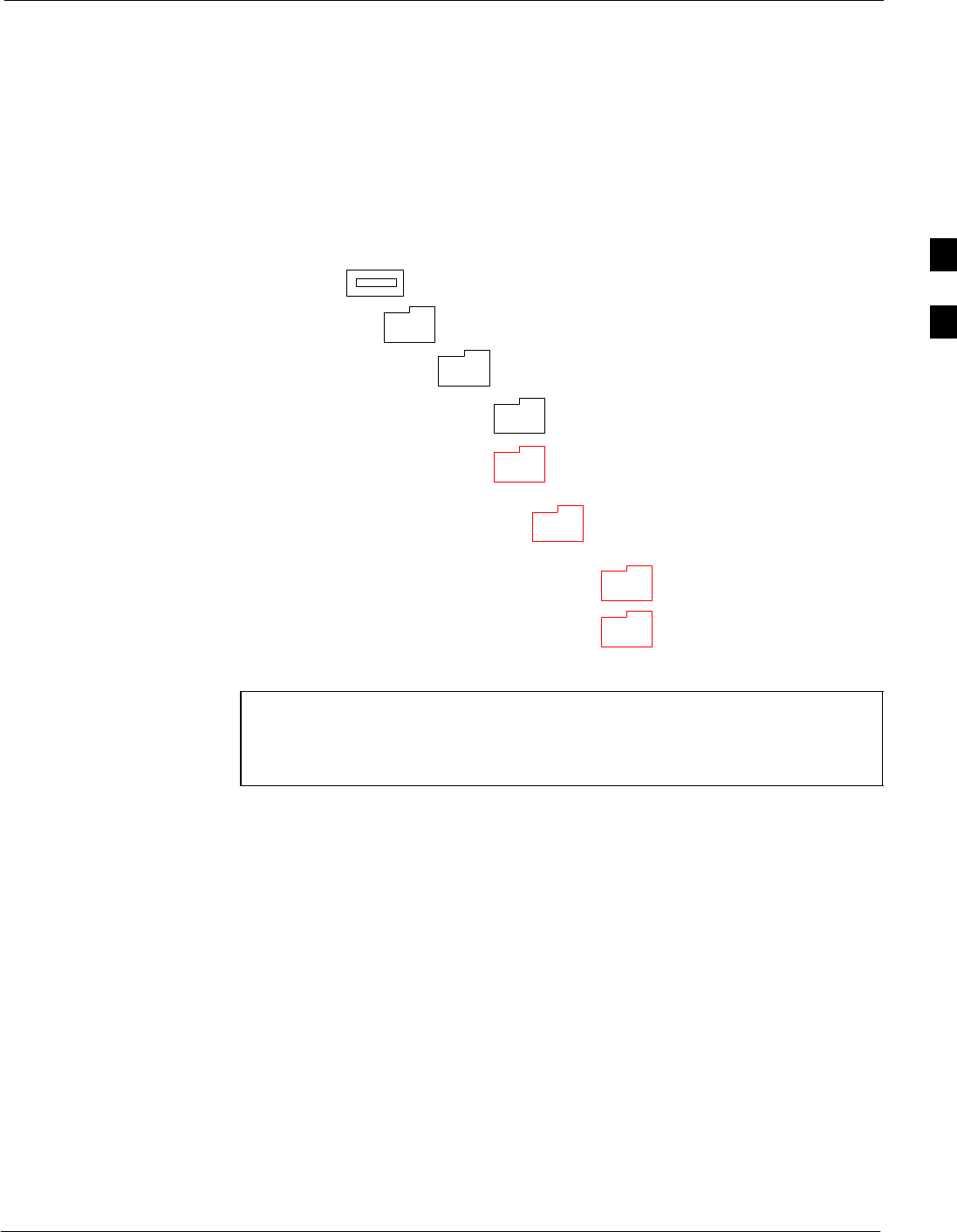
Preparing the LMF68P09258A31–A
Oct 2003 1X SCt 4812T BTS Optimization/ATP 3-7
LMF File Structure Overview
The LMF uses a <x>:\<lmf home directory> folder that contains all of
the essential data for installing and maintaining the BTS. The following
list outlines the folder structure for LMF. Except for the bts-nnn folders,
these folders are created as part of the LMF installation. Refer to the
CDMA LMF Operator’s Guide for a complete description of the folder
structure.
Figure 3-1: LMF Folder Structure
version folder (A separate folder is
required for each different version; for
example, a folder name 2.8.1.1.1.5.)
loads folder
(C:)
x:\<lmf home directory> folder
cdma folder
code folder
data folder
BTS–nnn folders (A separate folder is
required for each BTS where bts–nnn is the
unique BTS number; for example, bts–163.)
NOTE The “loads” folder and all the folders below it are not available
from the LMF for Software Release 2.16.1.x. These folders may
be present as as a legacy from previous software versions or
downloaded from the CBSC/OMC–R.
3

Preparing the LMF 68P09258A31–A
Oct 2003
1X SCt 4812T BTS Optimization/ATP
3-8
LMF Home Directory
The LMF installation program creates the default home directory,
c:\wlmf, and installs the application files and subdirectories (folders)
in it. Because this can be changed at installation, the CDMA LMF home
directory will be referred to with the generic convention of:
<x>:\<lmf home directory>
Where:
<x> = the LMF computer drive letter where the CDMA LMF home
directory is located.
<lmf home directory> = the directory path or name where the CDMA
LMF is installed.
3

Preparing the LMF68P09258A31–A
Oct 2003 1X SCt 4812T BTS Optimization/ATP 3-9
NECF Filename Conventions and Directory Location
NECF
The NECF actually consists of two files: the NECB and NECJ. The
naming convention for the NECB and NECJ is:
NECB*bts#.xml
NECJ*bts#.xml
Where:
* = any characters can be substituted there
# = the actual integer BTS number
The NECB and its corresponding NECJ must have the exact same name,
except for the “B” and “J” difference after the initial NEC characters.
The NECB and the NECJ must reside in the
<LMF_HOME>\cdma\bts–# directory corresponding to the BTS frame
they are for.
Load Information File (LIF)
The LIF contains all the devices binaries available for the specified
System Software Release. It is the functional equivalent of the OLF file
that was used pre–Packet.
The naming convention for the LIF is:
NE_LIF.xml
The LIF must reside in the <LMF_HOME>\cdma\loads\<Software
Release Number> directory, where <LMF_HOME> = the home
directory in which the LMF is installed, usually C:\wlmf <Software
Release Number> = the System Software Release Number (e.g.
2.16.1.0.10).
Cal File
The Cal File still resides in the <LMF_HOME>\cdma\bts–# directory
and is named bts–#.cal, where # is the actual integer number of the BTS.
3
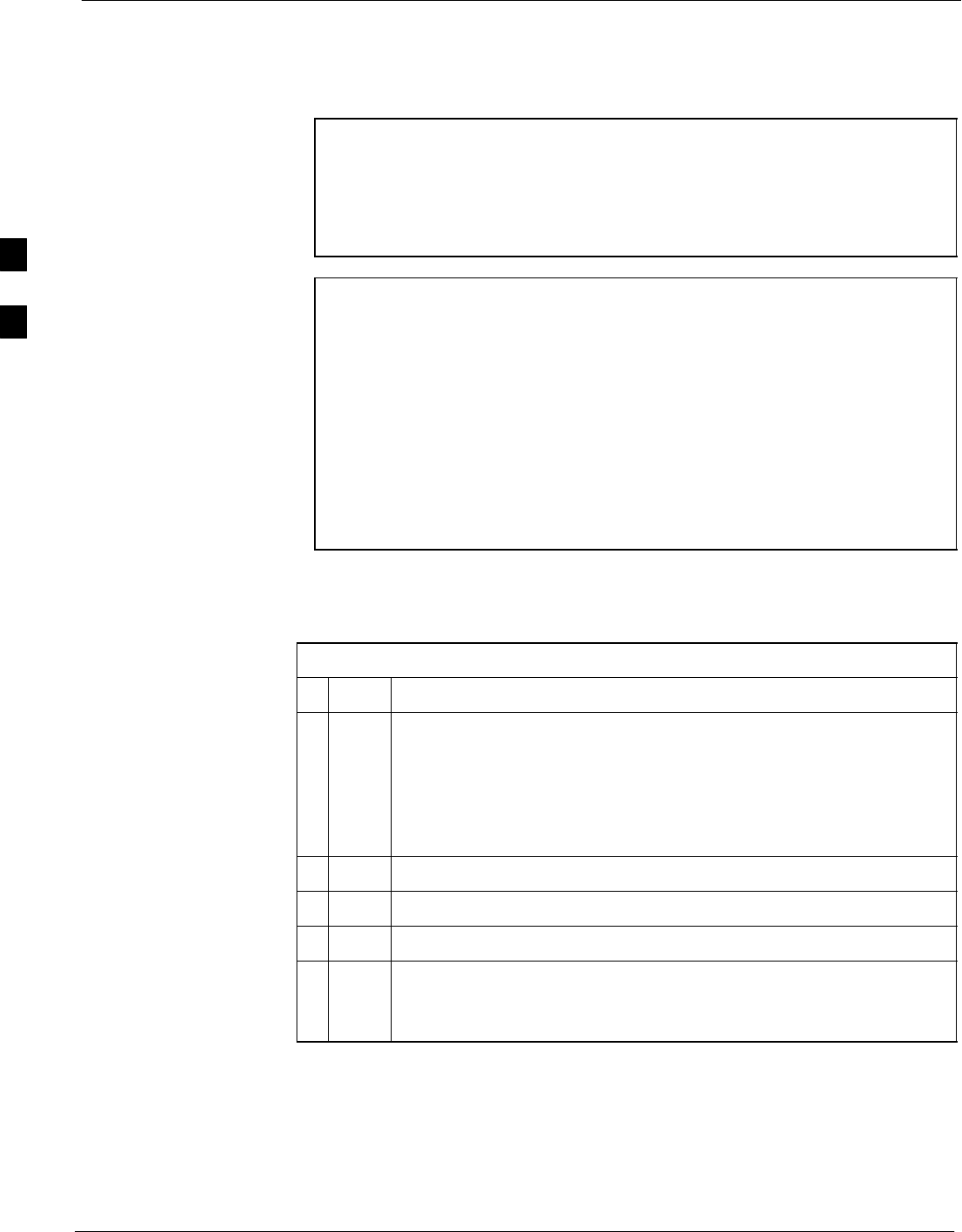
Preparing the LMF 68P09258A31–A
Oct 2003
1X SCt 4812T BTS Optimization/ATP
3-10
LMF Operating System Installation
This section provides information and instructions for installing and
updating the LMF software and files.
NOTE First Time Installation Sequence:
1. Install Java Runtime Environment (JRE)
2. Install U/WIN K–shell emulator
3. Install LMF application programs
4. Install/create BTS folders
NOTE Any time you install U/WIN, you must install the LMF software
because the installation of the LMF modifies some of the files
that are installed during the U/Win installation. Installing U/Win
over–writes these modifications.
There are multiple binary image packages for installation on the
CD–ROM. When prompted, choose the load that corresponds to
the switch release that you currently have installed. Perform the
Device Images install after the WinLMF installation.
If applicable, a separate CD ROM of BTS Binaries may be
available for binary updates.
Follow the procedure in Table 3-1 to install the LMF application
program using the LMF CD ROM.
Table 3-1: Install LMF using CD ROM
nStep Action
1Insert the LMF CD ROM disk into your disk drive and perform the
following as required:
1a – If the Setup screen appears, follow the instructions displayed on
the screen.
1b – If the Setup screen is not displayed, proceed to Step 2.
2Click on the Start button.
3 Select Run.
4 Enter d:\autorun in the Open box and click OK.
NOTE
If applicable, replace the letter d with the correct CD ROM drive
letter.
3
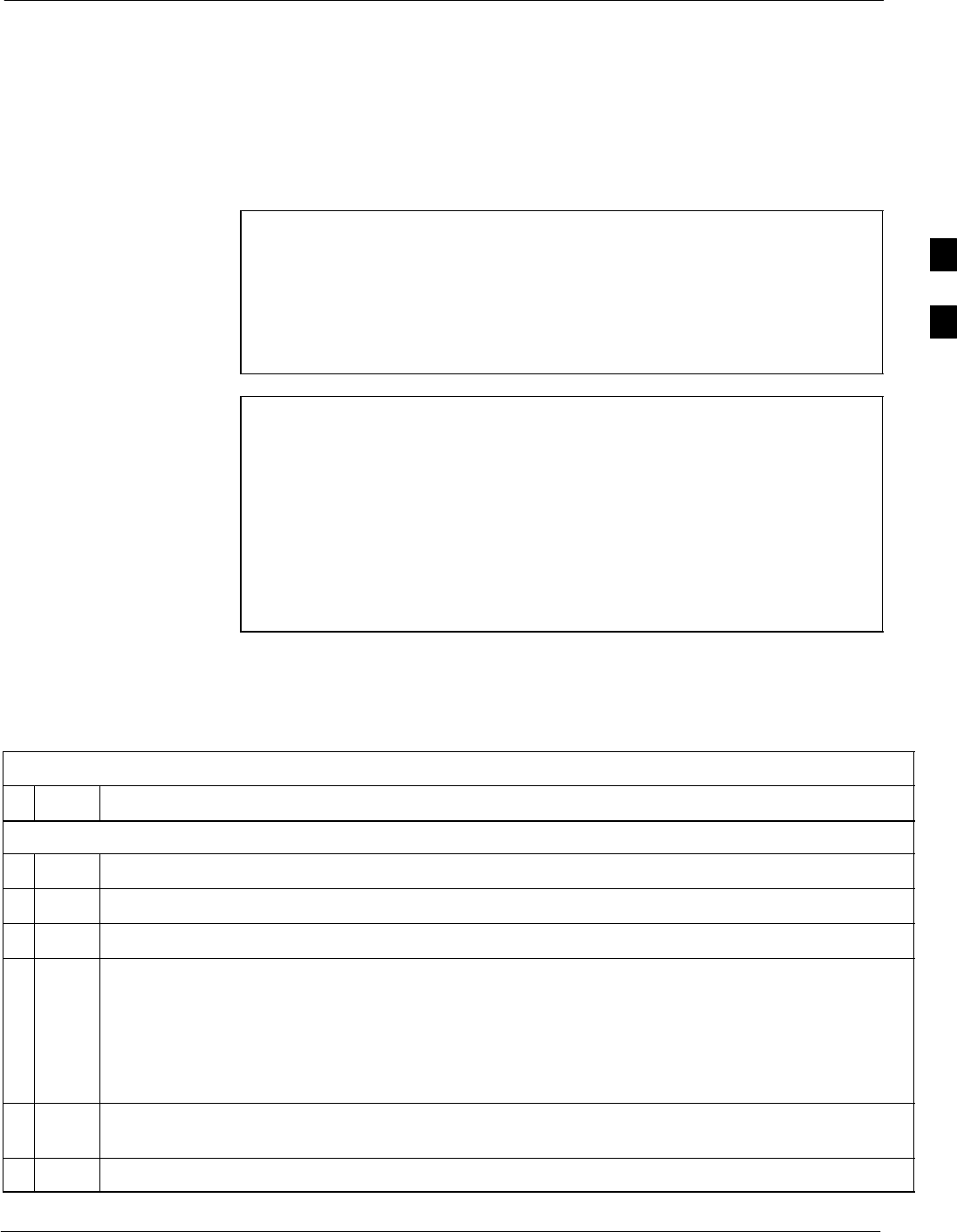
Preparing the LMF68P09258A31–A
Oct 2003 1X SCt 4812T BTS Optimization/ATP 3-11
Copy BTS and CBSC CDF (or NECF) Files to the LMF Computer
Before logging on to a BTS with the LMF computer to execute
optimization/ATP procedures, the correct bts-#.cdf (or bts–#.necf) and
cbsc-#.cdf files must be obtained from the CBSC and put in a bts-#
folder in the LMF computer. This requires creating versions of the
CBSC CDF files on a DOS–formatted floppy diskette and using the
diskette to install the CDF files on the LMF computer.
NOTE – If the LMF has ftp capability, the ftp method can be used to
copy the CDF or NECF files from the CBSC.
– On Sun OS workstations, the unix2dos command can be
used in place of the cp command (e.g., unix2dos
bts–248.cdf bts–248.cdf). This should be done using a copy
of the CBSC CDF file so the original CBSC CDF file is
not changed to DOS format.
NOTE When copying CDF or NECF files, comply with the following
to prevent BTS login problems with the Windows LMF:
SThe numbers used in the bts-#.cdf (or bts–#.necf) and
cbsc-#.cdf filenames must correspond to the locally-assigned
numbers for each BTS and its controlling CBSC.
SThe generic cbsc–1.cdf file supplied with the Windows LMF
will work with locally numbered BTS CDF files. Using this
file will not provide a valid optimization unless the generic
file is edited to replace default parameters (e.g., channel
numbers) with the operational parameters used locally.
The procedure in Table 3-2 lists the steps required to transfer the CDF
files from the CBSC to the LMF computer. For further information, refer
to the LMF Help function on–line documentation.
Table 3-2: Copying CDF or NECF Files to the LMF Computer
nStep Action
AT THE CBSC:
1Login to the CBSC workstation.
2Insert a DOS–formatted floppy diskette in the workstation drive.
3 Type eject –q and press the Enter key.
4 Type mount and press the Enter key.
NOTE
SLook for the “floppy/no_name” message on the last line displayed.
SIf the eject command was previously entered, floppy/no_name will be appended with a number.
Use the explicit floppy/no_name reference displayed when performing Step 7.
5Change to the directory, where the files to be copied reside, by typing cd <directoryname>
(e.g., cd bts–248) and pressing the Enter key.
6 Type ls and press the Enter key to display the list of files in the directory.
. . . continued on next page
3
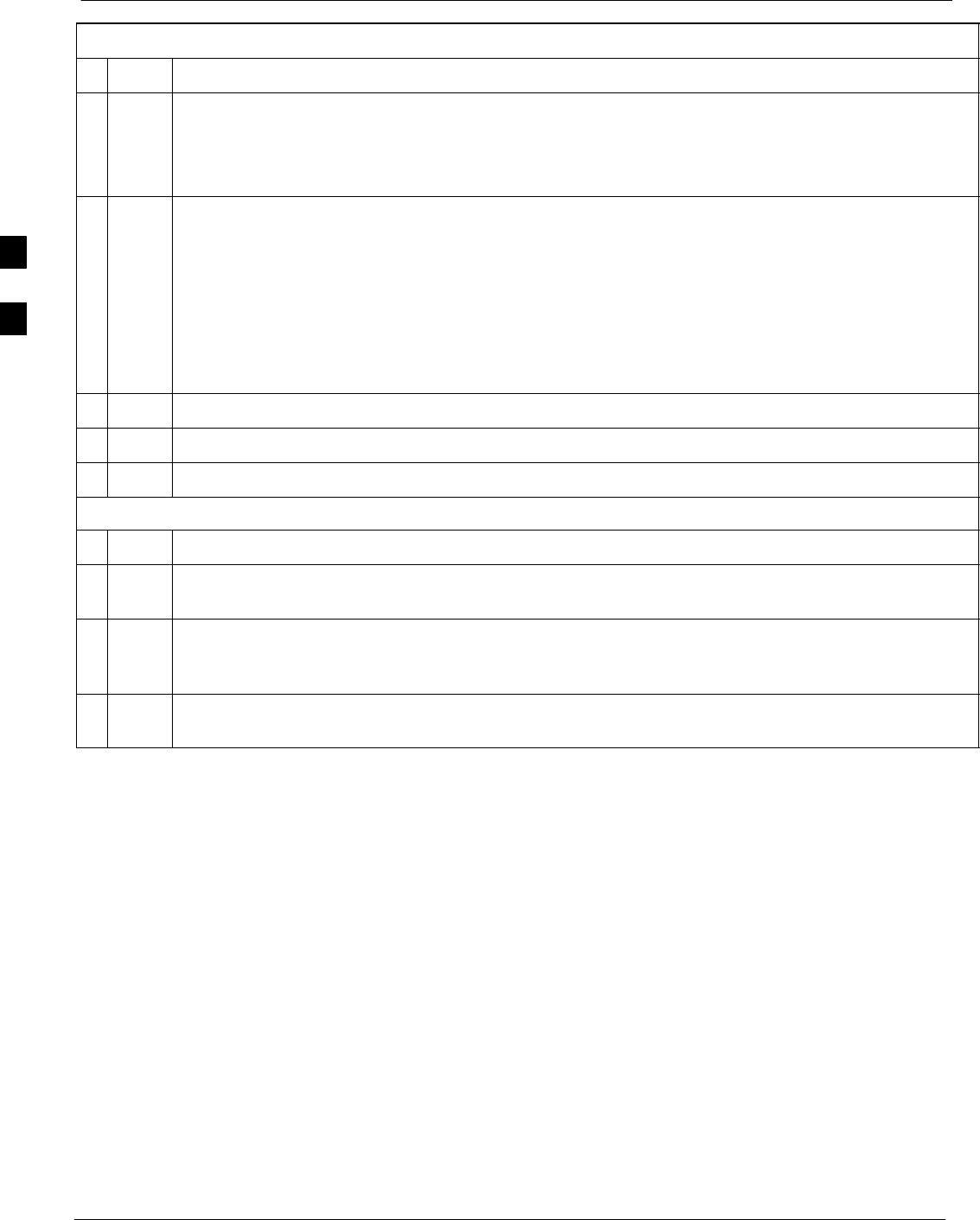
Preparing the LMF 68P09258A31–A
Oct 2003
1X SCt 4812T BTS Optimization/ATP
3-12
Table 3-2: Copying CDF or NECF Files to the LMF Computer
nActionStep
7 With Solaris versions of Unix, create DOS–formatted versions of the bts-#.cdf (or bts–#.necf) and
cbsc-#.cdf files on the diskette by entering the following command:
unix2dos <source filename> /floppy/no_name/<target filename>
(e.g., unix2dos bts–248.cdf /floppy/no_name/bts–248.cdf).
NOTE
SOther versions of Unix do not support the unix2dos and dos2unix commands. In these cases, use
the Unix cp (copy) command. The copied files will be difficult to read with a DOS or Windows text
editor because Unix files do not contain line feed characters. Editing copied CDF files on the LMF
computer is, therefore, not recommended.
SUsing cp, multiple files can be copied in one operation by separating each filename to be copied
with a space and ensuring the destination directory (floppy/no_name) is listed at the end of the
command string following a space (e.g., cp bts–248.cdf cbsc–6.cdf /floppy/no_name).
8Repeat Steps 5 through 7 for each bts–# that must be supported by the LMF computer.
9When all required files have been copied to the diskette type eject and press the Enter key.
10 Remove the diskette from the CBSC drive.
AT THE LMF:
11 If it is not running, start the Windows operating system on the LMF computer.
12 Insert the diskette containing the bts-#.cdf (or bts–#.necf) and cbsc-#.cdf files into the LMF
computer.
13 Using MS Windows Explorer, create a corresponding bts–# folder in the <x>:\<lmf home
directory>\cdma directory for each bts-#.cdf (or bts–#.necf) and cbsc-#.cdf file pair copied from the
CBSC.
14 Use MS Windows Explorer to transfer the bts-#.cdf (or bts–#.necf) and cbsc-#.cdf files from the
diskette to the corresponding <x>:\<lmf home directory>\cdma\bts–# folders created in Step 13.
3
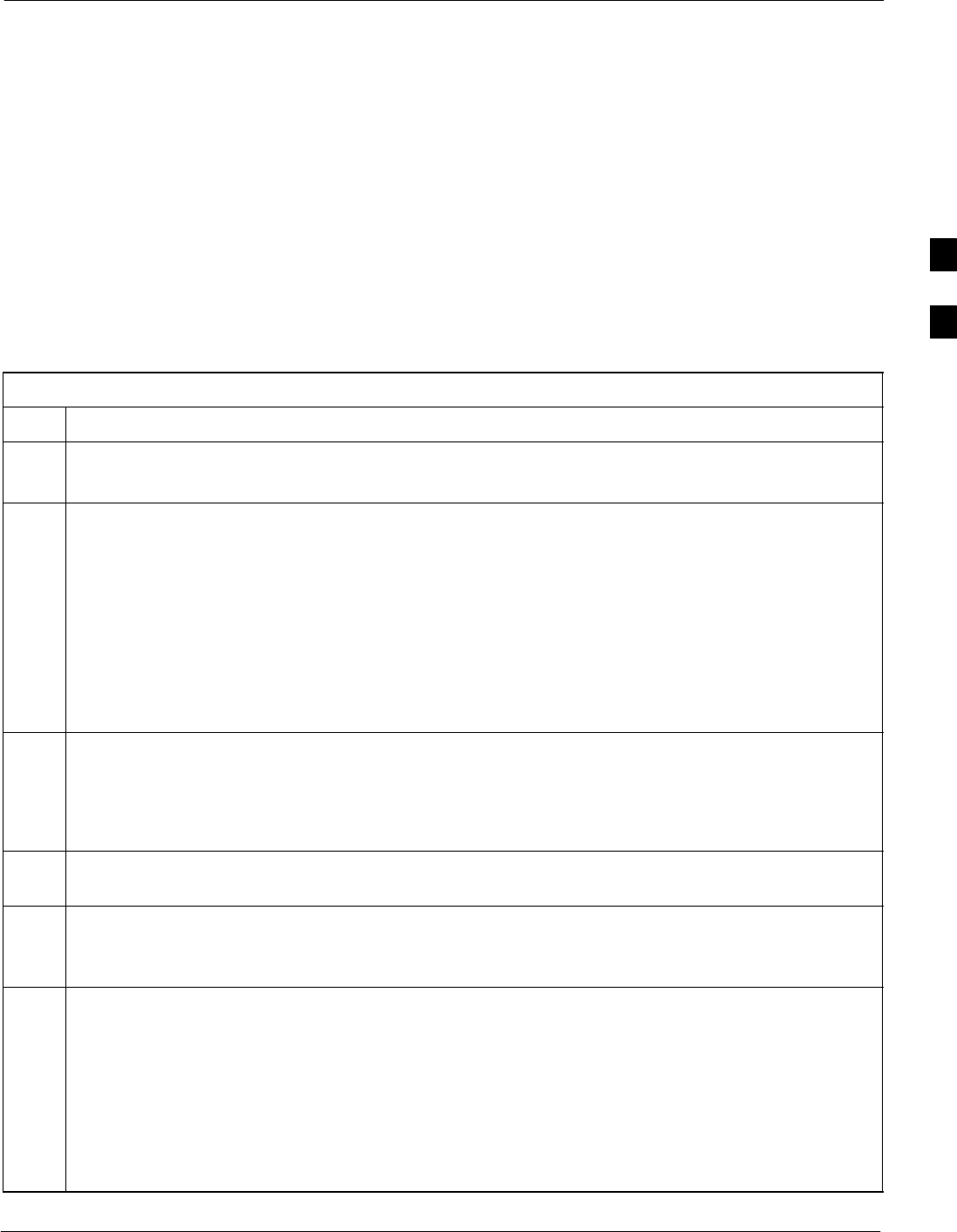
Preparing the LMF68P09258A31–A
Oct 2003 1X SCt 4812T BTS Optimization/ATP 3-13
Creating a Named HyperTerminal Connection for MMI Connection
Confirming or changing the configuration data of certain BTS Field
Replaceable Units (FRU) requires establishing an MMI communication
session between the LMF and the FRU. Using features of the Windows
operating system, the connection properties for an MMI session can be
saved on the LMF computer as a named Windows HyperTerminal
connection. This eliminates the need for setting up connection
parameters each time an MMI session is required to support
optimization.
Once the named connection is saved, a shortcut for it can be created on
the Windows desktop. Double–clicking the shortcut icon will start the
connection without the need to negotiate multiple menu levels.
Follow the procedure in Table 3-3 to establish a named HyperTerminal
connection and create a Windows desktop shortcut for it.
Table 3-3: Creating a Named Hyperlink Connection for MMI Connection
Step Action
1From the Windows Start menu, select:
Programs>Accessories>
2Perform one of the following:
SFor Win NT, select Hyperterminal and then click on HyperTerminal or
SFor Win 98, select Communications, double click the Hyperterminal folder, and then double click
on the Hyperterm.exe icon in the window that opens.
NOTE
SIf a Location Information Window appears, enter the required information, then click Close.
(This is required the first time, even if a modem is not to be used.)
SIf a You need to install a modem..... message appears, click NO.
3When the Connection Description box opens:
– Type a name for the connection being defined (e.g., MMI Session) in the Name: window.
– Highlight any icon preferred for the named connection in the Icon: chooser window.
– Click OK.
4From the Connect using: pick list in the Connect To box displayed, select COM1 or COM2 (Win
NT) – or Direct to Com 1 or Direct to Com 2 (Win 98) for the RS–232 port connection and click OK.
NOTE
For LMF configurations where COM1 is used by another interface such as test equipment and a
physical port is available for COM2, select COM2 to prevent conflicts.
5In the Port Settings tab of the COM# Properties window displayed, configure the RS–232 port
settings as follows:
SBits per second: 9600
SData bits: 8
SParity: None
SStop bits: 1
SFlow control: None
. . . continued on next page
3
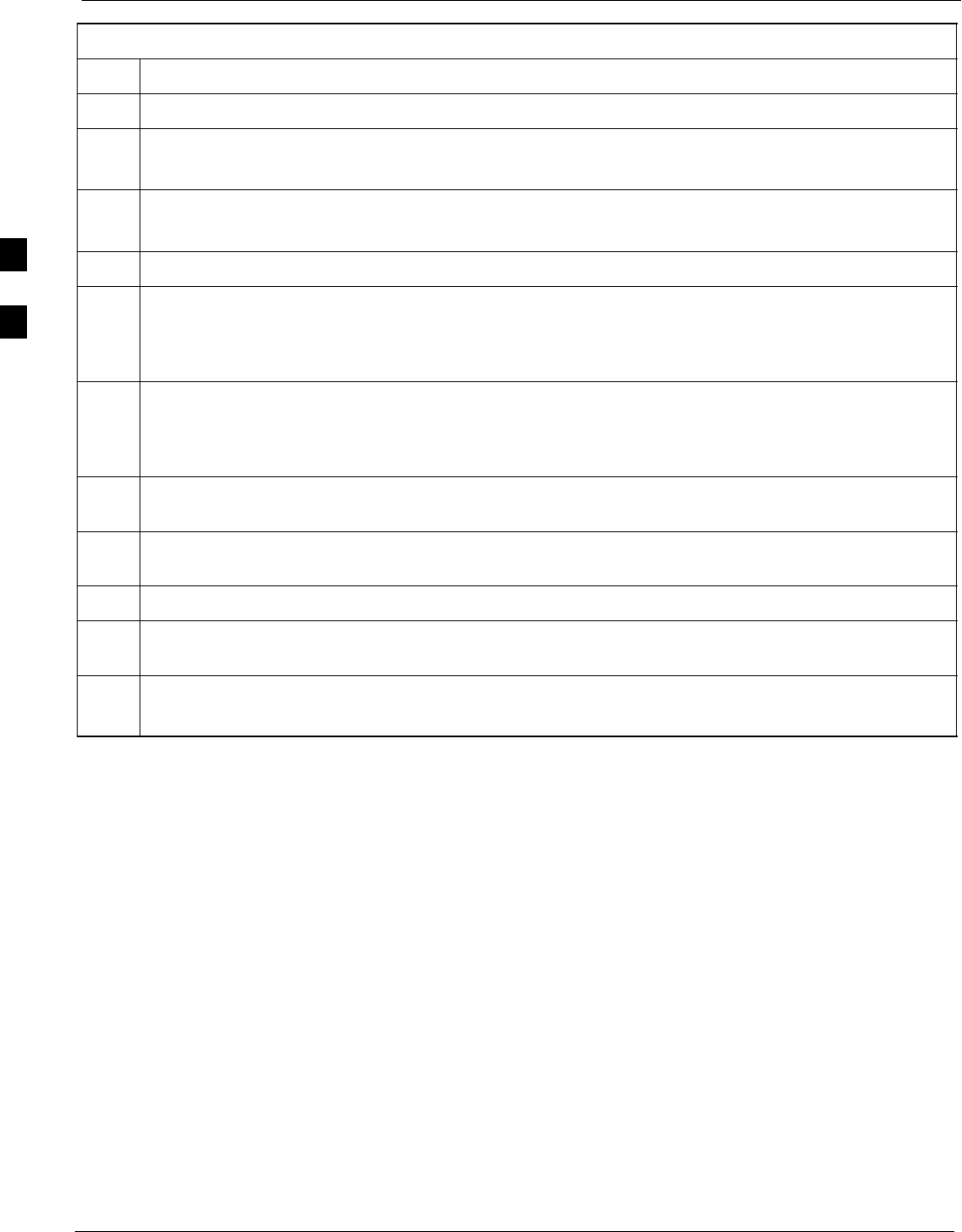
Preparing the LMF 68P09258A31–A
Oct 2003
1X SCt 4812T BTS Optimization/ATP
3-14
Table 3-3: Creating a Named Hyperlink Connection for MMI Connection
Step Action
6 Click OK.
7Save the defined connection by selecting:
File>Save
8Close the HyperTerminal window by selecting:
File>Exit
9 Click Yes to disconnect when prompted.
10 Perform one of the following:
SIf the Hyperterminal folder window is still open (Win 98) proceed to step 12
SFrom the Windows Start menu, select Programs > Accessories.
11 Perform one of the following:
SFor Win NT, select Hyperterminal and release any pressed mouse buttons.
SFor Win 98, select Communications and double click the Hyperterminal folder.
12 Highlight the newly created connection icon by moving the cursor over it (Win NT) or clicking on it
(Win 98).
13 Right click and drag the highlighted connection icon to the Windows desktop and release the right
mouse button.
14 From the pop–up menu displayed, select Create Shortcut(s) Here.
15 If desired, reposition the shortcut icon for the new connection by dragging it to another location on the
Windows desktop.
16 Close the Hyperterminal folder window by selecting:
File > Close
3
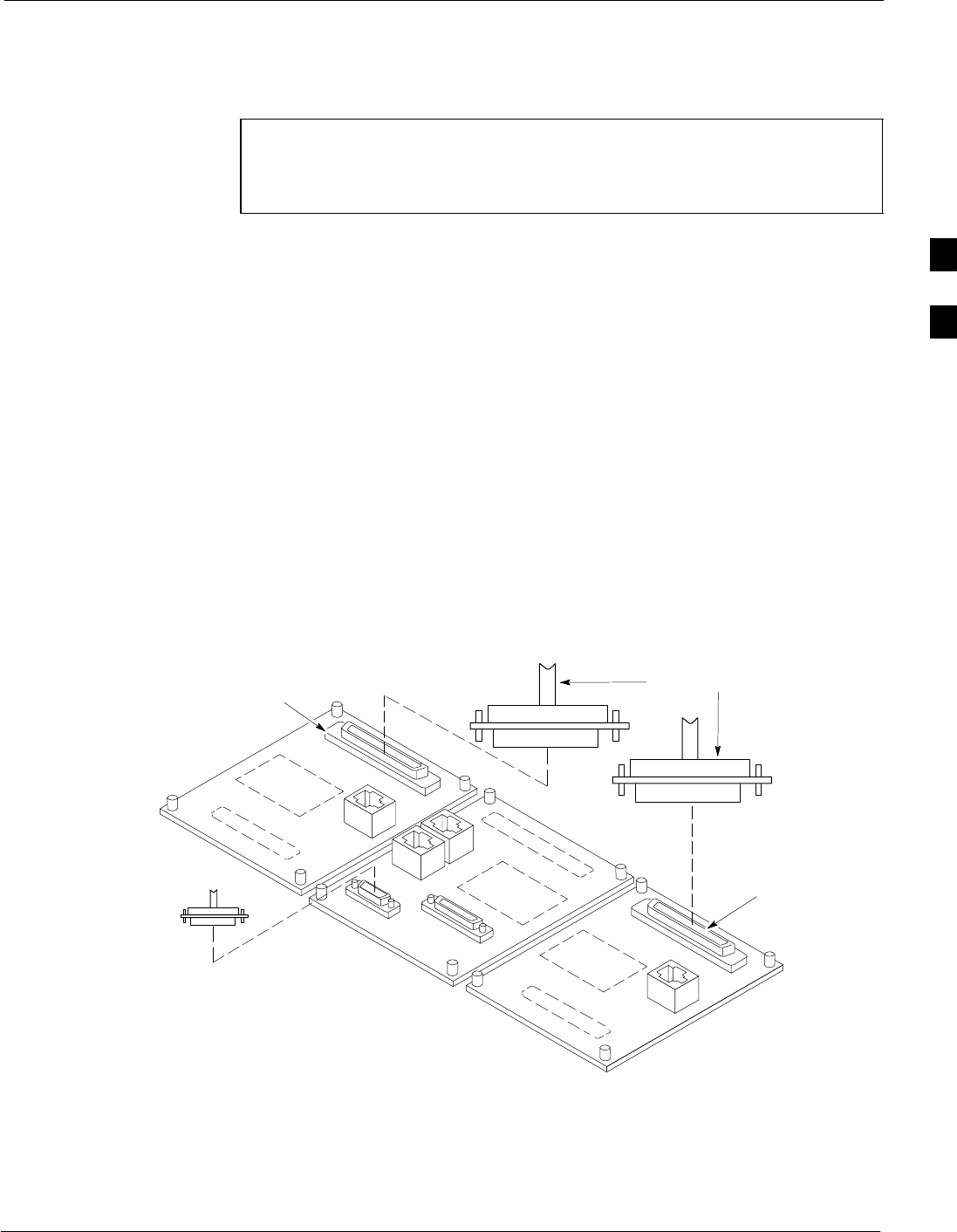
Span Lines – Interface and Isolation68P09258A31–A
Oct 2003 1X SCt 4812T BTS Optimization/ATP 3-15
Span Lines – Interface and Isolation
T1/E1 Span Interface
NOTE At active sites, the OMC/CBSC must disable the BTS and place
it out of service (OOS). DO NOT remove the 50–pin TELCO
cable connected to the BTS frame site I/O board J1 connector
until the OMC/CBSC has disabled the BTS!
Each frame is equipped with one Site I/O and two Span I/O boards. The
Span I/O J1 connector provides connection of 25 pairs of wire. A GLI
card can support up to six spans. In the SC 4812T configuration, the odd
spans (1, 3, and 5) terminate on the Span “A” I/O; and the even spans (2,
4, and 6) terminate on the Span “B” I/O.
Before connecting the LMF to the frame LAN, the OMC/CBSC must
disable the BTS and place it OOS to allow the LMF to control the
CDMA BTS. This prevents the CBSC from inadvertently sending
control information to the CDMA BTS during LMF based tests. Refer to
Figure 3-2 and Figure 3-3 as required.
Isolate BTS from T1/E1 Spans
Once the OMC–R/CBSC has disabled the BTS, the spans must be
disabled to ensure the LMF will maintain control of the BTS. To disable
the spans, disconnect the span cable connectors from the Span I/O cards
(see Figure 3-2).
Figure 3-2: Span I/O Board T1 Span Isolation
50–PIN TELCO
CONNECTORS
REMOVED
SPAN A CONNECTOR
(TELCO) INTERFACE
TO SPAN LINES
SPAN B CONNECTOR
(TELCO) INTERFACE
TO SPAN LINES
TOP of Frame
(Site I/O and Span I/O boards)
RS–232 9–PIN SUB D
CONNECTOR SERIAL
PORT FOR EXTERNAL
DIAL UP MODEM
CONNECTION (IF USED)
FW00299
3
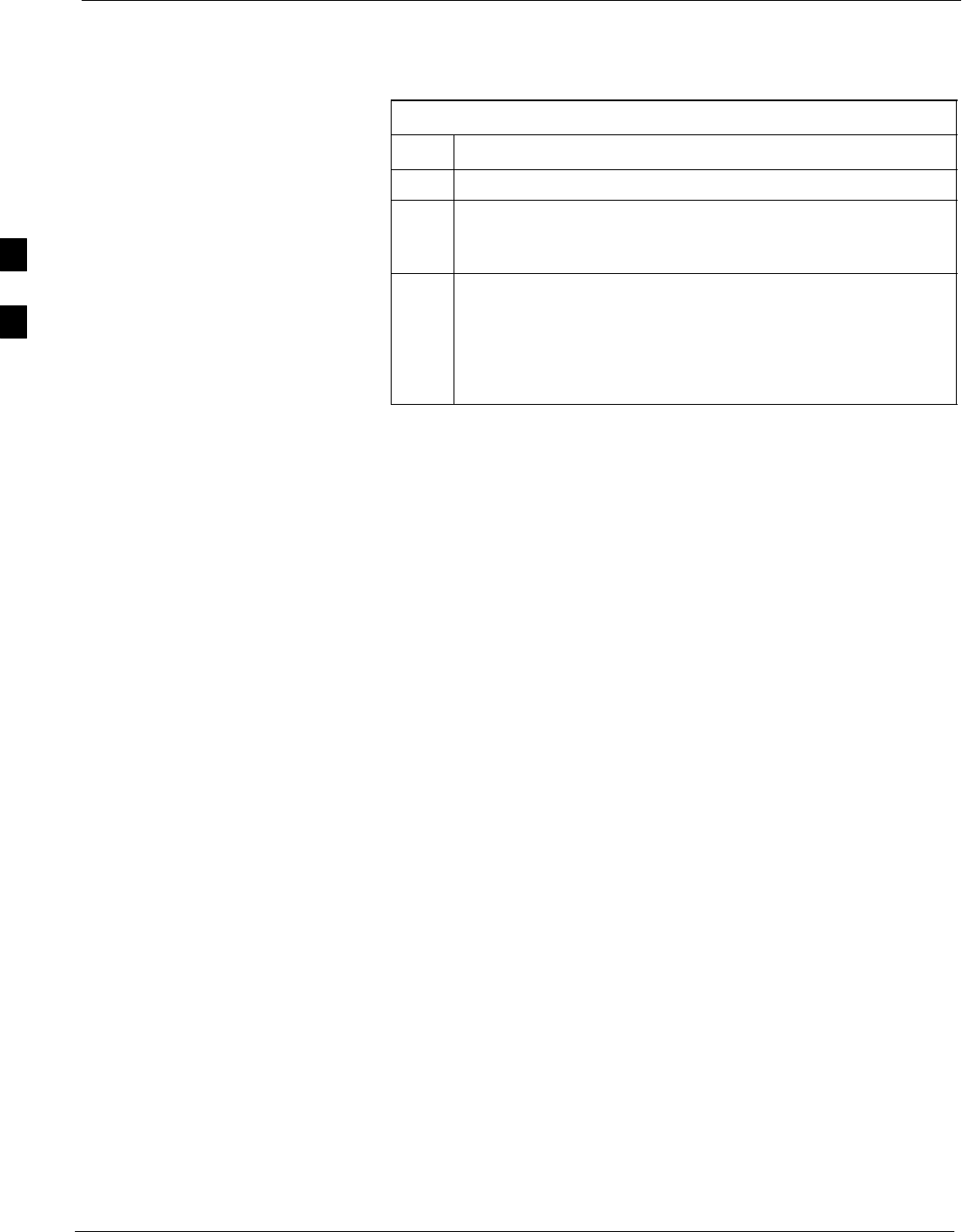
Span Lines – Interface and Isolation 68P09258A31–A
Oct 2003
1X SCt 4812T BTS Optimization/ATP
3-16
T1/E1 Span Isolation
Table 3-4 describes the action required for span isolation.
Table 3-4: T1/E1 Span Isolation
Step Action
1Have the OMC/CBSC place the BTS OOS.
2The T1/E1 span 50–pin TELCO cable connected to the BTS
frame SPAN I/O board J1 connector can be removed from
both Span I/O boards, if equipped, to isolate the spans.
NOTE
If a third party is used for span connectivity, the third party
must be informed before disabling the span line.
Verify that you remove the SPAN cable, not the
“MODEM/TELCO” connector.
3
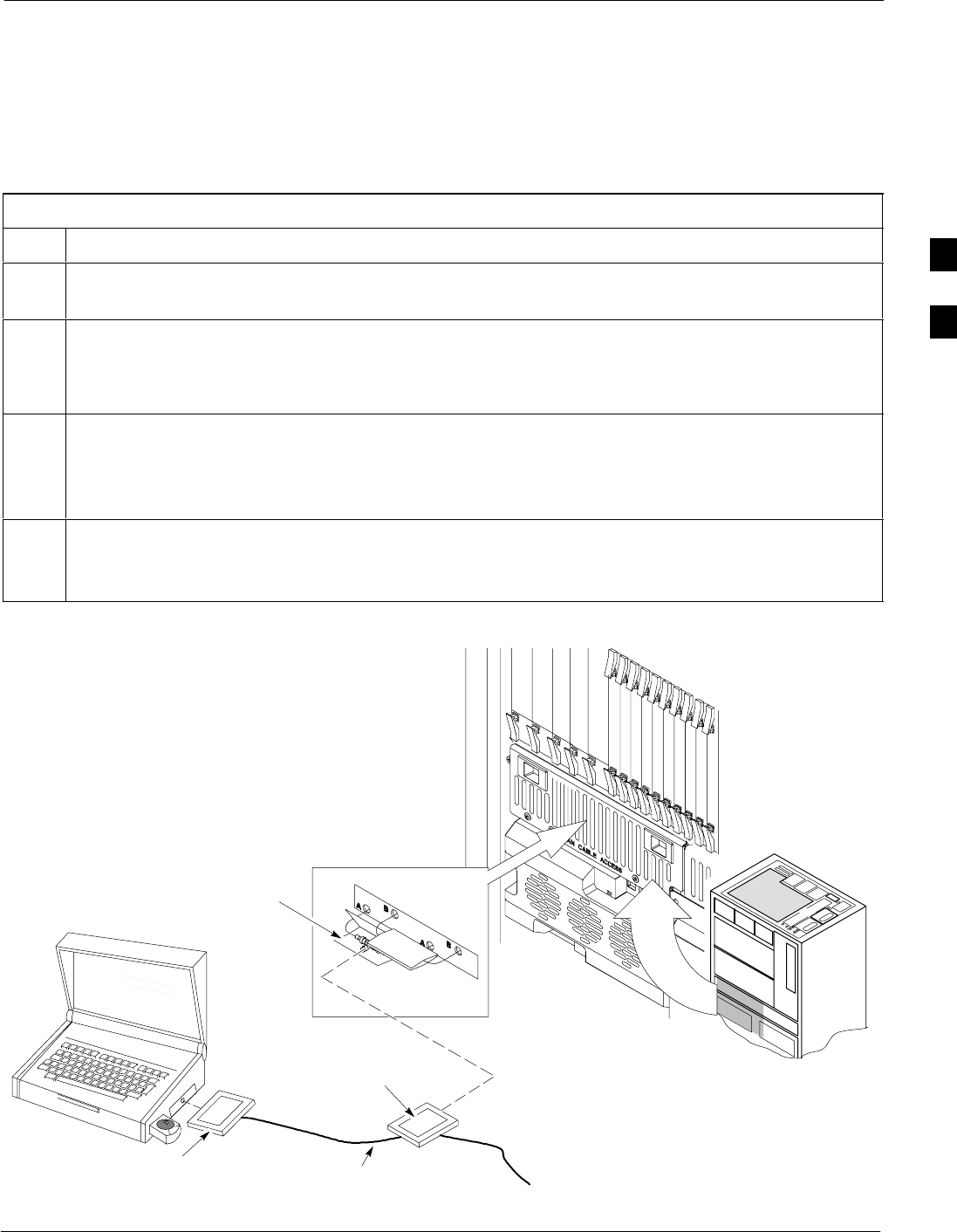
LMF to BTS Connection68P09258A31–A
Oct 2003 1X SCt 4812T BTS Optimization/ATP 3-17
LMF to BTS Connection
Connect the LMF to the BTS
The LMF is connected to the LAN A or B connector located on the left
side of the frame’s lower air intake grill, behind the LAN Cable Access
door (see Figure 3-3).
Table 3-5: LMF to BTS Connection
Step Action
1To gain access to the connectors, open the LAN cable access door, then pull apart the fabric covering
the BNC “T” connector (see Figure 3-3).
2Connect the LMF to the LAN A BNC connector via PCMCIA Ethernet Adapter with an unshielded
twisted–pair (UTP) Adapter and 10BaseT/10Base2 converter (powered by an external AC/DC
transformer). If there is no login response, connect the LMF to the LAN B connector. If there is still
no login response, see Table 6-1, Login Failure Troubleshooting Procedures.
NOTE
Xircom Model PE3–10B2 or equivalent can also be used to interface the LMF Ethernet connection to
the frame connected to the PC parallel port, powered by an external AC/DC transformer. In this case,
the BNC cable must not exceed 91 cm (3 ft) in length.
* IMPORTANT
The LAN shield is isolated from chassis ground. The LAN shield (exposed portion of BNC connector)
must not touch the chassis during optimization.
Figure 3-3: LMF Connection Detail
NOTE:
Open LAN CABLE ACCESS
door. Pull apart Velcro tape and
gain access to the LAN A or LAN
B LMF BNC connector.
LMF BNC “T” CONNECTIONS
ON LEFT SIDE OF FRAME
(ETHERNET “A” SHOWN;
ETHERNET “B” COVERED
WITH VELCRO TAPE)
LMF COMPUTER
TERMINAL WITH
MOUSE PCMCIA ETHERNET
ADPATER & ETHERNET
UTP ADAPTER
10BASET/10BASE2
CONVERTER CONNECTS
DIRECTLY TO BNC T
115 VAC POWER
CONNECTION FW00140
UNIVERSAL TWISTED
PAIR (UTP) CABLE (RJ11
CONNECTORS)
3

Using the LMF 68P09258A31–A
Oct 2003
1X SCt 4812T BTS Optimization/ATP
3-18
Using the LMF
Basic LMF Operation
LMF Coverage in This Publication – The LMF application program
supports maintenance of both CDMA and SAS BTSs. All references to
the LMF in this publication are to the CDMA portion of the program.
Operating Environments – The LMF application program allows the
user to work in the two following operating environments which are
accessed using the specified desktop icons:
SGraphical User Interface (GUI) using the WinLMF icon
SCommand Line Interface (CLI) using the WinLMF CDMA CLI icon
The GUI is the primary optimization and acceptance testing operating
environment. The CLI environment provides additional capability to the
user to perform manually controlled acceptance tests and audit the
results of optimization and calibration actions.
Basic Operation – Basic operation of the LMF in either environment
includes performing the following:
SSelecting and deselecting BTS devices
SEnabling devices
SDisabling devices
SResetting devices
SObtaining device status
The following additional basic operation can be performed in a GUI
environment:
SSorting a status report window
For detailed information on performing these and other LMF operations,
refer to the LMF Help function on–line documentation.
NOTE Unless otherwise noted, LMF procedures in this manual are
performed using the GUI environment.
3

Using the LMF68P09258A31–A
Oct 2003 1X SCt 4812T BTS Optimization/ATP 3-19
The LMF Display and the BTS
BTS Display – When the LMF is logged into a BTS, a frame tab is
displayed for each BTS frames. The frame tab will be labeled with
“CDMA” and the BTS number, a dash, and the frame number (for
example, BTS–812–1 for BTS 812, RFMF 1). If there is only one frame
for the BTS, there will only be one tab.
CDF/NECF Requirements – For the LMF to recognize the devices
installed in the BTS, a BTS CDF/NECF file which includes equipage
information for all the devices in the BTS must be located in the
applicable <x>:\<lmf home directory>\cdma\bts–# folder. To provide
the necessary channel assignment data for BTS operation, a CBSC CDF
file which includes channel data for all BTS RFMFs is also required in
the folder.
RFDS Display – If an RFDS is included in the CDF/NECF file, an
RFDS tab labeled with “RFDS,” a dash and the BTS number–frame
number combination (for example, RFDS–812–1) will be displayed.
Graphical User Interface Overview
The LMF uses a GUI, which works in the following way:
SSelect the device or devices.
SSelect the action to apply to the selected device(s).
SWhile action is in progress, a status report window displays the action
taking place and other status information.
SThe status report window indicates when the the action is complete
and displays other pertinent information.
SClicking the OK button closes the status report window.
3

Using the LMF 68P09258A31–A
Oct 2003
1X SCt 4812T BTS Optimization/ATP
3-20
Understanding GUI Operation
The following screen captures are provided to help understand how the
GUI operates:
– Figure 3-4 depicts the differences between packet and circuit
CDMA “cdf” file identification. Note that if there is a packet
version “bts” file, the “(P)” is added as a suffix. There is a
corresponding “(C)” for the circuit mode version.
– Figure 3-5 depicts the Self-Managed Network Elements (NEs) state
of a packet mode SC4812T. Note that an “X” is on the front of each
card that is under Self–Managed Network Elements (NEs) control
by the GLI3 card.
– Figure 3-6 depicts three of the available packet mode commands.
Normally the GLI3 has Self-Managed Network Elements (NEs)
control of all cards as shown in Figure 3-5 by an “(X)”. In that state
the LMF may only status a card. In order to download code or test a
card, the LMF must request Self-Managed Network Elements (NEs)
control of the card by using the shown dropdown menu. It also uses
this menu to release control of the card back to the GLI3. The GLI3
will also assume control of the cards after the LMF logs out of the
BTS. The packet mode GLI3 normally is loaded with a tape release
and NECB and NECJ files which point to a tape release stored on
the GLI3. When the GLI3 has control of a card it will maintain that
card with the code on that tape release.
– Figure 3-7 depicts a packet mode site that has the MCC–1 and the
BBX–1 cards under LMF control. Notice that the “X” is missing
from the front of these two cards.
For detailed information on performing these and other LMF operations,
refer to the LMF Help function on–line documentation.
3